
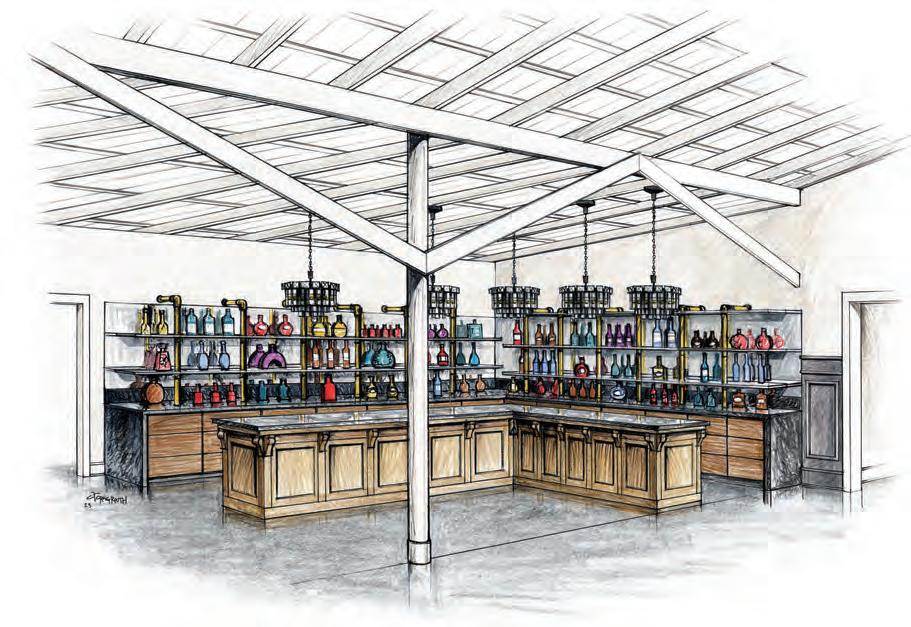




JUL 23 // COUNTRYROADSMAG.COM 2

// JUL 23 3 5720 Commerce Street • (225) 635-6502 www.StFrancisvilleInn.com
Exec Chef Michael Dardenne
Entrées Appetizers
6
34
NEWS & NOTEWORTHIES
Augmented reality on the plate and a new distillery
Events
fireworks, waterside celebrations abound 11
HOME PLACE PASTURES
Radical intentionality raises the finest cuts of meat
 by Mimi Greenwood Knight
by Mimi Greenwood Knight
WATER RICH, DIRT POOR
The St. John Restaurant goes hydroponic by Lucie
Monk Carter
JU’LYIN! Barbecue,
RAW DEAL
Revolutionizing New Orleans sushi by reaching directly into the Gulf by Alexandra Kennon
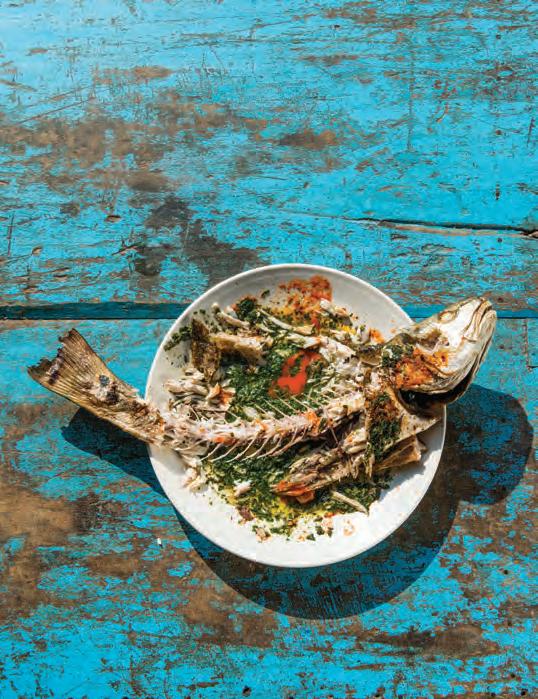
On the Cover
HAPPY PLATE
Nothing says summer in the Gulf South quite like leaning back from the picnic table, belly full of fresh-caught fish, face tilted up towards the sweltering sun— bonus points if you can see a body of water from your seat. When we came across this capture by New Orleans photographer Rush Jagoe, we found it familiar, nostalgic even. We’ve been here before.
And perhaps it was our story-searching tendencies, but we saw other things in this image, too: locality in the freshness, seasonality in the colors, intentionality in the plating—holding forth even in decimation. We saw the joy of food sourced with care, prepared with love, and eaten with relish.
We hope you feel these sentiments radiating from the stories within this year’s Cuisine Issue as well, as we celebrate local restaurants and purveyors radically rethinking our food systems, shortening the distance from farm, or sea, to plate. At the same time, we remember the impact those far away places have had on our food culture, traveling to West Africa to experience gumbo’s predecessor first-hand and sharing memories of the Hitachi rice cookers that relinquished an inch on our Cajun and Creole grandmothers’ roles in the kitchen. And finally, we re-examine food as a mechanism of art—reaching even beyond its beauty and taste for something more powerful: message.
Cuisine Culture
FLESH OF THE GODS From spawn to
flush,
52
58 REFLECTIONS
Introducing the Africatown Heritage Museum in Mobile by Cheré Coen
WE LET SUMMER COME TO US
On the sweltering summer blues by Ed Cullen
54
Publisher James Fox-Smith Associate Publisher
Ashley Fox-Smith
Managing Editor Jordan LaHaye Fontenot
Arts & Entertainment Editor Alexandra Kennon Editorial Intern Audrey Livigni Creative Director Kourtney Zimmerman
Contributors:
Cheré Coen, Ed Cullen, Lucius Fontenot, Mimi Greenwood Knight, Sonny Marks, Shelby McClure, Teddy McGehee, Kimberly Meadowlark, Lucie Monk Carter, Jody Ray, Chris Turner-Neal Cover Artist Rush Jagoe Advertising
SALES@COUNTRYROADSMAG.COM
Sales Team
Heather Gammill & Heather Gibbons Advertising Coordinator Melissa Freeman President Dorcas Woods Brown Country
Escapes
THERE’S SOMETHING IN THE WATER
66
ISSN #8756-906X
“CAN-I-BALL?”
Exploring meal as message in Baton Rouge by Chris
Turner-Neal
56
Copyrighted.
GRIS GRIS
50 years since they started covering Baton Rouge like the Dieux by Teddy McGeHee
Post Office handling of third-class mail.
JUL 23 // COUNTRYROADSMAG.COM 4 Contents VOLUME 40 // ISSUE 7 JULY 2023
Saint Charles
Baton Rouge, LA 70802
(225) 343-3714 Fax (815) 550-2272
WWW.COUNTRYROADSMAG.COM
Roads Magazine 758
Street
Phone
EDITORIAL@COUNTRYROADSMAG.COM
Subscriptions $21.99 for 12 months
$39.58 for 24 months
rights reserved. No portion of this publication may be reproduced without permission of the publisher. The opinions
in Country Roads magazine
authors or columnists and
the
the publisher,
they
an endorsement of products or services herein. Country Roads magazine
the right to refuse any advertisement. Country Roads cannot be responsible for delays in subscription deliveries due to U.S.
All
expressed
are those of the
do not necessarily reflect
views of
nor do
constitute
retains
8
38
40
Photo by Rush Jagoe
WEST
West
world
HOW TO MAKE
AFRICAN OKRA STEW Reaching for gumbo’s
African origins a
away by Jody Ray 44
HITACHI
Cajun staple
48
A
by Jordan LaHaye Fontenot
53
A foodie’s guide to the Mississippi Gulf Coast by Jordan LaHaye Fontenot
A Roadkill Christmas
by James Fox-Smith
Mimi
Perspectives
Mushroom Maggie’s story by
Greenwood Knight 47
THE SECRET LIFE OF FOOD
Clare Crespo’s all-toodelicious body of artwork by Sonny Marks
SURVIVING THE CLOTILDA
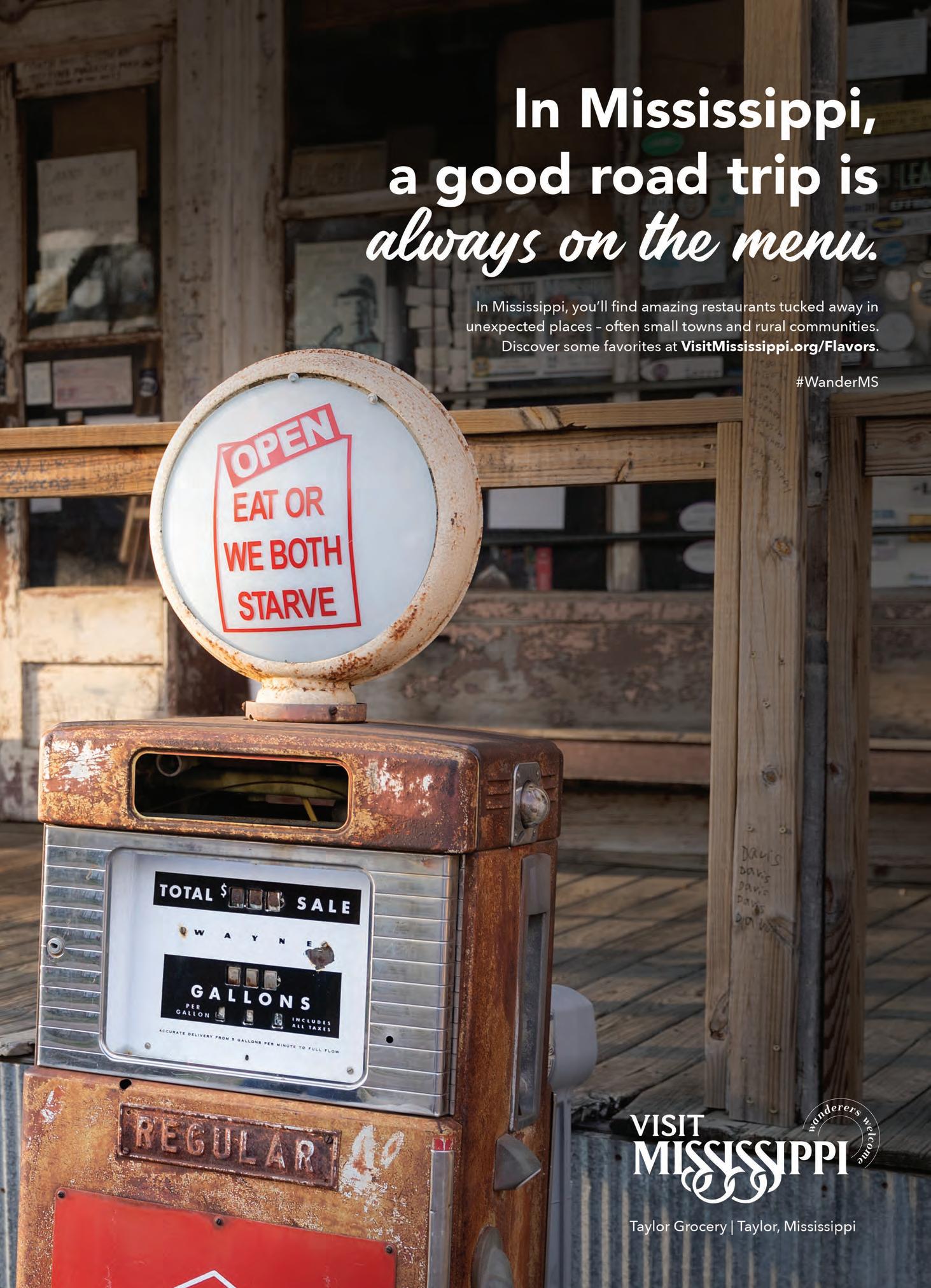
// JUL 23 5
Reflections
FROM THE PUBLISHER

One of the vividest memories I have of my grandmother dates from December, 1979. I was nine years old and my homesick parents had taken our family back to the U.K. for Christmas for the first time since we had emigrated to Australia in 1975. 1979 brought a cold winter to southeastern England, and an unusually snowy one on the rural, windswept part of the Suffolk coast where my grandparents lived. When we arrived the roads snaking across the Suffolk fens were lined with high snowbanks that made driving the narrow laneways even more fraught than usual. In 1979 my grandmother’s daily driver was a 1965 Mini Clubman with a four-speed manual gearbox, no heat, and wheels the size of grapefruit. There was nothing about this vehicle that recommended it for winter driving. Nor was Gran a particularly good driver, but as with most activities in her life, this fact didn’t prevent her from throwing herself into the activity with gusto. So, when she set out on a snowy morning early during our visit to shop for Christmas dinner ingredients, her oldest grandson, sensing adventure, was keen to ride along. As we sat in the freezing car preparing
to set off, Gran explained her theory of driving on snow and ice, which was that one should get the car into top gear as soon as possible. This she commenced to do with a great grinding of gears, and we fishtailed out of the driveway and into the street, picking up speed in the direction of Aldeburgh. So, we were skimming along between snow-blanketed fields at a pretty good clip when two fat pheasants chose the exact wrong moment to fly out from a hedgerow, and encountered the Mini with a flakburst of feathers and a soft, double “whump.” Rather than taking evasive action, Gran let out a shout of triumph and stood on the brakes, sending the Mini into a series of graceful pirouettes. When it came to rest against a snowbank she scrambled out and dashed back up the road to retrieve the pheasants, which she deposited into the back seat beside nine-year-old me. The image of those two large, beautifully colored, exotic-looking birds lolling deadly on the brown vinyl has never left me. Simultaneously, the Christmas dinner menu, and my impression of my grandmother, both underwent some modification as a result of this event.
Gran was the last member of my family to have experienced anything approaching scarcity. While she and my grandfather were reasonably wellto-do by the time I entered the picture, the straitened circumstances of her upbringing as a coal-miner’s daughter
in nineteen-twenties Wales had inculcated her with a reflexive thriftiness that no amount of money would ever assuage. She had a particular horror about wasting food, that manifested itself in the myriad ways she had perfected for turning the leftovers of one meal into the raw material of the next, and in the delight she took in any activity that resulted in a free meal. This meant that during my childhood visits, no afternoon walk (she was a great one for walking) was embarked upon without a bag for gathering whatever edible foodstuffs the Suffolk fields and the season had to offer: field mushrooms in spring, blackberries and gooseberries in early summer; apples and sloe berries— which she would pick from hedgerows then steep in gin to make a luscious sloe gin liqueur—in autumn. Any grandchild who managed to catch an edible fish from the lake at the bottom of the
garden could expect showers of praise, and while she was no hunter, in winter she was happy to let hunters use the lakeside dock, so long as there was a goose or a couple of ducks in it for her.
It’s interesting to reflect on how my grandmother’s early experiences (and presumably those of her forebears) still echo, leaving their mark on ensuing generations who have never known the kind of scarcity that makes someone incapable of leaving a pair of stunned pheasants lying in a roadside ditch. Her daughter—my mother—inherited Gran’s inability to waste food. In her own kitchen Mum makes performance art out of decanting leftovers into a Russian nesting-doll-like series of progressively smaller containers until, finally, every morsel is consumed. Then there’s her grandson—yours truly—who, having yet again planted ten times the number of tomato, cucumber, pepper, and squash plants required to feed one small family, now lies awake at 3 am worrying about how to consume all the fresh produce piled soggily on his kitchen countertops. The ways in which the experiences of long-departed ancestors influence the habits and attitudes we embody today are a reminder that, whether in the kitchen, in the garden, on the road, or in life, no-one ever really walks alone.
James Fox-Smith, publisher —james@countryroadsmag.com


JUL 23 // COUNTRYROADSMAG.COM 6
Fresh Summer Flavor (with a Twist of Science!)
Pennington Biomedical’s Metabolic Research Kitchen develops recipes that support better health through balanced nutrition—and deliver delicious flavor, too.
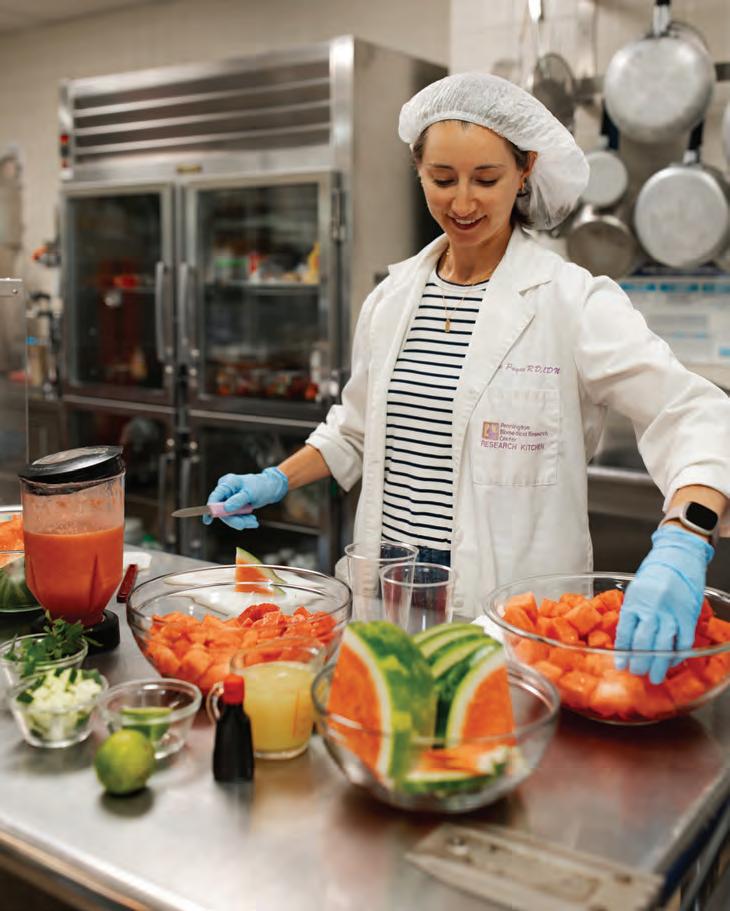
For nearly four decades, Louisiana State University’s Pennington Biomedical Research Center has stood at the forefront of health and nutrition research. A vital component of the Center’s work takes place in Pennington Biomedical’s Metabolic Research Kitchen, which supports the Center’s dietary studies and nutritional research. In the research kitchen, dietitians and nutritionists design, prepare, and serve specialized meals that meet study-specific criteria. Each day, the kitchen’s staff prepare menus and recipes to exacting standards—sometimes measuring ingredients down to the tenth of the gram—designing dishes to deliver the specific amounts of calories, protein, fat, and carbohydrates that researchers need to accurately test the impacts of different diets on study participants. And while such a precise approach to food preparation might seem unfamiliar, many of the methods that the Metabolic Kitchen implements to create these participant meals can also be used to help anyone produce delicious, satisfying dishes, all while reducing consumption of potentially harmful ingredients like meat, fat, or salt. So, just in time for the peak of watermelon season, here is a delicious, refreshing recipe for a highly nutritious, icy-fresh summer drink that’s easy to make, and far lower in sugar than typical store-bought alternatives. Try it at your next backyard barbecue or summer pool party. You, your family, and your health, will all be glad you did!
Watermelon Mint Slush

Makes 6 cups
1 cup = 70 kcals, 0g fat, 17g carbohydrates, 1g fiber, 1g protein
Ingredients
6 cups watermelon cut into 1” cubes (3 cups frozen, 3 cups thawed)
1 cup diced cucumber
1 cup orange juice
½ of 1 lime
5 mint leaves, sliced
2 drops mint extract
Instructions
1. Line a plate or cookie sheet with plastic wrap or silicone baking mat. Lay fresh watermelon cubes in a single layer onto the plate or cookie sheet, and place into the freezer until frozen.
2. Add 3 cups frozen watermelon cubes and 3 cups fresh (or thawed) watermelon cubes to a blender, along with diced cucumber, orange juice, juice from ½ of a lime, sliced mint leaves, and mint extract.
3. Blend together to desired consistency and serve.
To learn more about Pennington Biomedical’s Metabolic Kitchen and the dietary studies it supports, visit https://labs.pbrc.edu/metabolic-kitchen/
// JUL 23 7
A special advertising feature from Pennington Biomedical Research Center For more information about Pennington Biomedical Research Center, visit www.pbrc.edu. Scan here for more information.
Registered Dietitian and Metabolic Kitchen Director, Renee Puyau, prepares Watermelon Mint Slush as a healthy summer treat.
Le Petit Chef
SKULLMAPPING’S IMMERSIVE ANIMATED DINNER EXPERIENCE ARRIVES IN NEW ORLEANS
On a recent Friday night I sat hacross from my fiancé in the hhistoric Hotel Monteleone’s Criollo Restaurant, and enjoyed a five-course meal. Such indulgent meals have been enjoyed in the French Quarter for well over a century, but this one was different. We watched course after course as a tiny, 3D-animated chef painstakingly prepared each dish—from growing the radishes alongside the burrata, to wrestling sea creatures from a jet ski for the bouillabaisse, to tackling a lobster three times his size—in vibrant projection mapping right on the tabletops in front of us.
The experience is called Le Petit Chef, a concept hatched by Belgium artistic collective Skullmapping, which was
co-founded by Creative Director Filip Sterckx and 3D Artist Anton Verbeeck. Skullmapping creates 3-dimensional animation projects that use projection mapping to bring intricate and colorful scenes to life on any surface, from table place settings to historic building faces (one project they completed for New Year’s Eve in Antwerp involved a story of a firebird’s battle with evil, projected magnificently on a massive historic building face, in the style of Luna Fête in New Orleans or Allumer in Natchez).
Le Petit Chef has been staged (Eaten? Cooked? Shown?) in cities across the world including Bangkok, Paris, London; and more recently in American cities like New York, Chicago, and Los Angeles. For the first time anywhere in the
Gulf South, it’s currently being offered at Criollo through the summer and into the fall, with dinner seatings at 5:30 pm and 8 pm.
Besides each dish consistently being exquisitely prepared, the grown-up menu presented alongside the cartoon show was made of crowd-pleasers: a burrata and heirloom tomato salad, a seafood bouillabaisse flavored with garlic and saffron; a sous-vide lobster tail in a creamy garlic butter topped with truffle oil; wagyu beef tenderloin atop a celeriac mash with prosciutto-wrapped asparagus; and a relative of the baked Alaska featuring neapolitan-flavored gelato with torched meringue and a cherry on a chocolate wafer called “Le Bombe”.
I appreciated that even though the projections felt contemporary—even futur-
A Tale of Agave & Sugarcane
istic-seeming—staples of a fine meal out weren’t compromised. The real, human service was still excellent—a waiter explained each course between the animated interludes, and the actual, human chef (though somewhat less petit than our adorable protagonist), greeted us warmly as we arrived.
Timeout called Le Petit Chef at the Los Angeles Ritz an “uncomplicated delight”. And that’s exactly what it is, if you let it be. Coming straight from a busy week of work, it was just the combination of indulgently delicious and outright silly that I didn’t realize I was craving. That can only be properly executed if the food and animation technology are both actually very serious—Le Petit Chef spares no effort in either area, ensuring that a concept so precariously close to veering gimmick holds fast its status as a delight. In a world where technological advancements often feel daunting (between resetting the wifi router and wondering/worrying about the future of A.I.), Le Petit Chef feels like a rarely-simple digital-age treat.
—Alexandra Kennon
WITH RUM ON THE MIND, NOËL FAMILY DISTILLERY DEBUTS LOUISIANA’S FIRST SMALL-BATCH TEQUILA
“Mmm . . . “ is the sound that vibrates from the back of my tongue as the rum hits it, tingling with a surprising—albeit gentle—spice.
“That’s what I say every time I sip it,” smiled Chip Noël, master distiller and visionary behind Noël Family Distillery.
The rum, made from Grade A molasses, is a blend of North and Central American rums aged for six years and proofed onsite in Donaldsonville. The kick, Chip’s daughter and business partner, and the distillery’s CEO Natalie Noël explained, comes from the cask finish in tequila barrels.
It’s been almost six years since Chip and Natalie first set out on this journey together—enacting Chip’s vision of Louisiana sugarcane-produced rum made in their hometown. “We had no idea when we thought about doing this that it would take this long,” said Natalie, who mentions that almost everything that could go wrong, did. “But resiliency is our motto,” she said. And finally, on May 17, the Noël Family Distillery officially received the license to open its doors and sell its hard-won products.
While six years is a long time to
get a business started, it’s not all that long when it comes to producing the high-quality aged rum of Chip’s dreams. So, the first barrel of Chip’s own rum made with Louisiana sugarcane—the very heart of the operation—is still cheerfully aging right by the entrance of the distillery. During the hardest moments along the journey, Chip explained, this barrel is what has kept them going. “It represents a lot to us,” he said. “I don’t like to open it up to even try to taste it. The angels have gotten enough.” The rum will be available at the end of this year.
In the meantime, Chip and Natalie are working with established distillers across the world to create spirits—especially rums—that are true expressions, taste and quality-wise, of their own ambitions at Noël Family Distillery. Alongside the tequila-finished rum is a more traditional barrel-aged version, blended from Caribbean and Central American rums and distilled from high-test molasses.
The vodkas are made 100% from American-grown corn, distilled six times through a charcoal filter, and proofed and bottled inside the Noël Distillery. “We just wanted a vodka that could do well in a martini,” said Natalie. They also
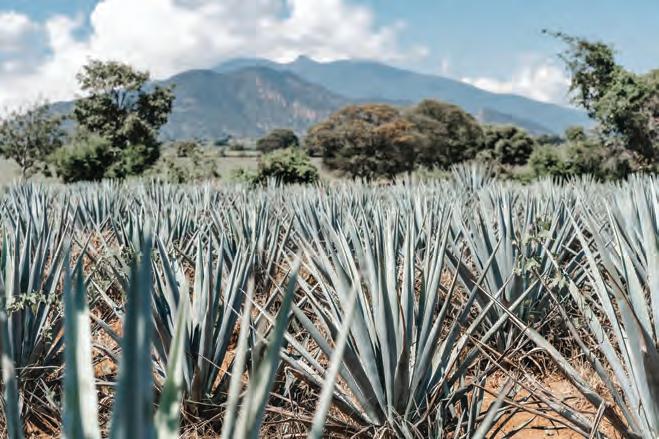
offer a pickle vodka, mixed here in Donaldsonville, that comes from a recipe Natalie dreamed up during her pregnancy pickle cravings.
And then there’s the tequila—Louisiana’s first. “I fell in love with tequila,” said Natalie. “And there is a gap in this market. There’s no local distillery offering authentic agave tequila.” For tequila to be tequila, it must be made in one of five authorized states in Mexico—which is where Natalie and Chip went. Working closely with the woman-owned agave farm and distillery Casa Maestri, Natalie developed two small-batch luxury tequilas she felt would suit Louisiana palates, while staying true to the authentic spirit of the liquor. The Blanco is meant to be a true celebration of agave, smooth and with just a hint of sweetness—no additives. The Reposado, which is aged in former Jack Daniels’ oak barrels, is a delightful and unique expression of tequila that Natalie said has been a favorite at tastings—delicious on the rocks, with a spritz of lime; in a margarita; or even as a rum or bourbon replacement in a stylized Old Fashioned.
Following the great struggle of getting started, the Noëls see themselves aligned with the crops at the heart of their op-
eration—which draws deeply on their multi-generational roots as a farming family in Donaldsonville. “The agave plant, the sugarcane plant—these are both resilient crops,” said Natalie. “The agave plant—you just plant it and ignore it for like seven years, and then harvest it. And sugarcane, it’ll get attacked by hurricanes every year, and it’ll still be here.”
The father-daughter duo look forward to being a part of the revitalization efforts in their hometown, and to offering a gathering place for their community. “I’m kind of blown away by the people who walk through that door,” said Chip. “I’ve been here my whole life, but they’re so appreciative to have something like this in Donaldsonville.”
Currently, Noël Family Distillery is open for tours and tastings (they also have a full cocktail menu) from 9 am–4 pm Monday—Friday, and by appointment on Saturdays. You can find their spirits at Hokus Pokus Liquor in Prairieville and Calandro’s, Mulberry Market, French Market Bistro, Ivars, La Carreta, the Main Lobby, and Bin 77 in Baton Rouge. shop.noëldistillery.com.
—Jordan LaHaye Fontenot
JUL 23 // COUNTRYROADSMAG.COM 8 Noteworthy LOOK CLOSER NEWS, TIMELY TIDBITS, AND ASSORTED CURIOSITIES • JULY 2023
Disclaimer: the writer's experience was hosted by the Hotel Monteleone.
Grapevine Mills A Hidden Tourism Treasure in Dallas-Fort Worth


The city of Grapevine is often hailed as one of the greatest family destinations in North Texas, centrally located between Dallas and Fort Worth, offering small-town charm, premiere shopping, local community events and adventurous outdoor activities. Within the city of Grapevine, Grapevine Mills shopping center is home to over 180 sought after and popular retail brands, entertainment experiences, and multiple dining options that no other surrounding retail center has. A true family destination, the indoor, air-conditioned mall welcomes metroplex locals as well as day trippers during summer months to beat the heat and enjoy quality family fun where everyone can play!
For many travelers from surrounding areas, Grapevine Mills is a must-add to any summer itinerary! As a destination where retail shopping meets the world of entertainment, a next-level experience is ignited for visitors, offering things to do for all ages including Legoland Discovery Center, where children can build and test their own designs; Peppa Pig World of Play, the first Peppa Pig experience in the United States; Round 1 Bowling and Amusement offering bowling, karaoke, ping pong and more; SEA Life Aquarium, home to the only Sea Turtle rescue hospital in North Texas; and The Escape Game, where guests will embark on an immersive adventure with unexpected surprises and an array of different settings to choose from. A lineup of popular, everyday brands is balanced with a collection of highly desirable outlets like Michael Kors, Neiman Marcus Last Call, Saks OFF 5th, Pandora, The North Face, kate spade new york and the eagerly awaited Arhaus The Loft that will open on property this July.

“Bargain hunters and interior design devotees will flock to Arhaus The Loft to find discounted, slightly-imperfect and overstocked pieces such as handcrafted sofas, sectionals, accent chairs, lighting and more,” shares Trudy Cresswell, Director of Marketing and Business Development at Grapevine Mills. “Marking the first discounted concept of its kind in Texas, this anticipated opening will further enhance Grapevine Mills’ home décor portfolio, joining Horchow Finale located in Neiman Marcus Last Call, offering uniquely made furniture at consumer-friendly prices.”
To the shoppers’ delight, Grapevine Mills is also excited to welcome the highly anticipated arts and entertainment company, Meow Wolf, in July 2023 as they debut their first Texas exhibition in Grapevine: The Real Unreal. Unlocking different dimensions of perspective and creativity through more than 30 rooms of multidimensional art and compelling narrative, visitors will be immersed in a technicolor wonderland that blends storytelling, technology and innovative art. Visions will come to life through the dedication and creativity of over 40 artists, with more than 30 of whom are local to Texas, along with internal Meow Wolf artists bringing their work to the Grapevine experience.
“It is important to us to support the Grapevine community and we are thrilled to see so many emerging local artists and other creatives from Texas as they contribute their originality to the upcoming Meow Wolf installation at Grapevine Mills,” adds Cresswell.


As a leading shopping destination for over 25 years, Grapevine Mills has fostered an environment where the traditional indoor mall experience and timeless activity of retail shopping is elevated and reimagined. As the metroplex continues to grow and evolve, so does Grapevine Mills, inviting families, locals and travelers to find the best deals, indulge in entertainment activities perfect on a vacation and spend quality time with family. Grapevine Mills has something for everyone and is on a mission to continue innovating retail for the next generation by expanding its retail portfolio and continuously welcoming new entertainment concepts.
To learn more about Grapevine Mills, visit simon.com/mall/grapevine-mills
// JUL 23 9
A
special advertising feature from Grapevine Mills, Texas

JULY 23 // COUNTRYROADSMAG.COM 10
June 30 –July 4
Erath Independence Day Cajun
Carnival: One of the oldest Fourth of July celebrations in Acadiana, this Cajun Carnival in Downtown Erath is set to be full of rides, fais do dos, Fire Department water fights, a fun run, a parade, and more. Look forward to live performances by local musicians the likes of Swampland Revival, Ryan Foret, Alligator Blue, Dustin Sonnier, Gerald Gruenig and Gentilly Zydeco, Poisson Rouge, and the Beau Young Band. Cap it all off with a fireworks display the evening of the 4th at 9 pm. Free. erath4.com.
July 1
Jennings Stars & Stripes
Celebration and Fireworks Show: An outdoor community festival with food trucks, markets, games, and live music starting at 5 pm, and a
Events
fireworks show held by the Jennings Fire department at the Oil and Gas Park. Free. Visit the Jennings Festival Association Facebook Page for more information.
Acadian Wind Symphony’s Celebrate America! at the ACA: The nationally-acclaimed Acadian Wind Symphony, under the direction of Gerald Guilbeaux, will present a patriotic concert for Independence Day in the James Moncus Theatre at The Acadiana Center for the Arts. 7:30 pm. $20. acadianacenterforthearts.org.
4th of July Lake Jam : Bring the boat or the car out to celebrate America with live music from bands like South 70 and Southern Roots, food vendors Mama G’s, Asian Cajun Trailer, and East Gate BBQ, and family activities in Morgan City’s Lake End Park. 11 am–5 pm. Free. cajuncoast.com.
July, July
Independence Day parades, festivals, barbecues, and fireworks shows by region

Weiner Pop-Up Independence Day Weekend Celebration: Enjoy craft beer, hot dogs, and live music at Bayou Teche Brewing's Weiner PopUp Independence Day Weekend Celebration. Live music by Jimmy Breaux from 4 pm–7 pm. Noon–9 pm. Free. lafayettetravel.com.
July 3
Youngsville Sugar Mill Pond Independence Celebration: Meet at Sugar Mill Pond and, before lighting up the night, enjoy music, family-friendly activities, and pop-up vendors. 5 pm–9 pm. Free. Details on the Sugar Mill Pond Facebook Page.
July 4
New Iberia Fourth of July Parade: Patriotic harmonies are set to make their way through Bouligny Plaza in honor of the birth of our nation. An Honor Guard ceremony will follow. Downtown New Iberia. 1:30 pm–5 pm. Free. iberiatravel.com.
Lake Charles Red, White, Blue & You Celebration: This festival celebration paints the town patriotic with a star-spangled street parade, concessions, face painting, and a huge fireworks display over the lake. 7 pm at the Lake Charles Civic Center. Free. visitlakecharles.org.
Broussard Independence Day Festival: Partake in a big ol’ birthday party for the nation, Broussard-style. Family friendly activities (including hot dog eating contests), live music by Louisiana Red, and fireworks at the St. Julien Park Sports Complex. 5 pm–9 pm. Free. Details at the Broussard Chamber of Commerce Facebook Page. Red, White, and Blue Boat Parade: Start the day with the Red, White, and Blue Boat Parade, and finish it out with fireworks over the lake from Lake End Parkway in Morgan City. Parade at 1 pm, fireworks begin at 9 pm. Free. cajuncoast.com.

// JULY 23 11
JULY'S ALIVE
ON THE DOCKET FOR THIS HOT JULY: BARBECUE COOK-OFFS, FIREWORKS OVER LAND AND WATER, ABUNDANT LIVE MUSIC, AND LOADS OF CREATIVE FUN TO KEEP THE KIDS BUSY • 2023
JULY
ACADIANA & SOUTHWEST LOUISIANA
Fourth of July Events
Krotz Springs Fireworks on the River: The name says it all—head out to the Atchafalaya for a sportsman's paradise fireworks show in Nall Park, 562 Front Street. The little town goes the whole nine yards with hot dogs, watermelon, and live local music. 6:30 pm–8 pm. cajuntravel.com. •
THE NORTHSHORE
July 1
Sparks in the Park: Celebrate the birth of our nation with Covington's annual Sparks in the Park festival. The event includes fireworks at dusk, live patriotic music performed by the Convington Concert Band, and fresh food made by local vendors—plus, you guessed it, a hot dog eating contest. The Rotary Club of Covington will keep the crowd hydrated with lemonade and water. While there are plenty of activities for the kids, the Covington Business Association will offer wine aplenty for adults—so pull out those lawn chairs and blankets and head to Bogue Falaya Park. Free. 5:30 pm–9 pm. louisiananorthshore.com.
Slidell Heritage Festival: Inside Heritage Park, join the community in

celebration of our nation with live music from Soul Revival, Amanda Shaw, and Zebra, plus food trucks and beverages, water slides and face painting, and a fireworks show to cap it all off. Gates open at 4 pm, lasts until 11 pm. $15 admission for ages thirteen and older. slidellheritagefest.org.
July 3
Mandeville's Light Up the Lake: On the Mandeville Lakefront, the fireworks will be beautifully mirrored in Lake Pontchartrain to ring in the Fourth of July. With patriotic tributes and live music, a kid's tent, games, face painting, and food trucks, the fireworks are not the only thing to look forward to. Onstage entertainment, located between Coffee and Carroll Streets, begins at 6 pm. Fireworks begin at 8:30 pm and will be launched from a raised barge for great viewing all along the lakefront. Picnics are not only welcome, but encouraged. Free. louisiananorthshore.com.
July 4
Madisonville Old Fashioned 4th of July Celebration: The Town of Madisonville and Keep Madisonville Beautiful invite all to the Old-Fashioned
4th of July celebration of America's independence on the banks of the Tchefuncte River. Bring your chairs, coolers, and picnic baskets, and find a spot on the riverfront to enjoy the fun. Feel free to bring the kids along, as activities include kids' games, cornhole and horseshoe tournaments, a Veteran's Salute, watermelon eating and rooster crowing contests, a pie bake-off, and fireworks in front of Old Town Hall. The fireworks start at 8:45 pm around dusk. Free. 10 am to dusk. louisiananorthsore.com.
Olde Town Slidell 4th of July
Celebration: Celebrate in Olde Towne Slidell this 4th of July with a day full of family fun, delicious food, kids’ activities, and much more. Stretching throughout Olde Towne Slidell with cooling zones available in efforts to beat the heat, this celebration is sure to get you in the patriotic spirit. And don’t forget about the big finale: a music-choreographed firework show. The celebration is presented by the Olde Towne Slidell Merchant Association. Free. Noon–9 pm. louisiananortshore.com.
Abita Springs' 4th of July
Celebration: The city of Abita Springs invites all to their 4th of July celebration. The festival will bring a classic car display from Gulf Coast Classic Cruisers, live music, fireworks, face painting for the kids, and food from favorite vendors. Additionally, the Abita Beer Truck
and other drinks will be available for purchase all day. Free. 2 pm–9:30 pm. louisananorthshore.com. •
CENTRAL & NORTH LOUISIANA
July 1
Independence Day Celebration in Monroe-West Monroe: Settle in downtown on the west or the east to watch the highly-anticipated annual fireworks show. Throughout the day, local vendors will be peddling their wares, and the streets will be filled with the sounds of live bands. Fireworks start at 9 pm, over the Ouachita River—best viewed from downtown West Monroe or Monroe, or on the West Monroe levee. Free. monroewestmonroe.org.
Flying Heart Freedom Fest & Anniversary Party: Flying Heart Brewery is celebrating it's own birthday, along with the country's. Things kick off with the national anthem at 1:30 pm, followed by performances by Cowboys with Guitars and Dash Rip Rock. Night ends with a bang, watching the Monroe-West Monroe firework show. Lasts until 9 pm. Tables are $100, including four wristbands and four beer tokens per table. Purchase at Flying Heart. monroe-westmonroe.org.
JULY 23 // COUNTRYROADSMAG.COM 12
01MK7641 11/21
Childhood comes and goes in a blink. We’re here through the stages of your life, with the strength of the cross, the protection of the shield. The Right Card. The Right Care.
July 4
The Sportspectrum Firecracker

5K Race in Shreveport: The annual Firecracker 5K at St. Vincent Mall in Shreveport provides patriotism one heated mile at a time. Kids can come too, with a half-mile fun run. 7:30 am. $30 in advance; $40 day-of. Donations will directly benefit the Spine Institute of Louisiana Foundation. sbfunguide.com.
Shreveport KTBS Freedom Fest: The fireworks will be coming from towns throughout the region: across from the Sci-Port Discover Center, backdropped by the lights on the Texas Street Bridge, and in the Brookshire Arena in Bossier City, the Northwood Country Club in Blanchard, over Big Cypress Bayou, and at the Maude Cobb Convention Complex. Locals can celebrate with live performances by local bands at the Northwood Country Club and the Molly Ringwalds in Downtown Shreveport. Food trucks will be on standby at South Bossier Park and Louisiana Boardwalk Outlets. Fireworks begin at 9:30 pm. Free. sbfunguide.com.
The Avoyelles Arts and Music Fest: The Fest will be held in downtown Marksville in connection with Louisiana’s longest running July 4th celebration. There will be live music by
•
GREATER BATON ROUGE
July 3
Kenilworth Independence Day Parade: Having trinkets, candy, and other treasures thrown from passing floats is a time-honored tradition in Louisiana, but why not bust it out for America's birthday, too? Kenilworth is again celebrating with its Independence Day Parade this year. Rolls at 6:30 pm. For route information and more, visit kenilworthneighborhood.com.
Donaldsonville’s Fireworks on the River: Crescent Park comes alive with live music by the Michael Foster Project and other acts all afternoon before the fireworks—this historic little town puts on a good show. 4 pm–10 pm. Free. visitlasweetspot.com.

July 4
Baton Rouge Fourth of July Spectacular: Every year, for our nation's birthday, WBRZ lights up the sky above the Mississippi River. The fireworks can be viewed from anywhere along the levee, and from Downtown
// JULY 23 13
Amanda Shaw, a barbecue cook-off, an arts & crafts fair, a car, truck, and jeep show, and fun and games for all ages. 10 am–8 pm, with fireworks to follow. Free and open to the public. avoyellesarts.com.
Old Mandeville celebrates America's independence with Light Up the Lake—a fireworks display reflected back from the waters of Lake Pontchartrain. See listing on page 12.
Fourth of July Events
Baton Rouge starting at 9 pm. visitbatonrouge.com.

Baton Rouge Concert Band 4th of July Concert: Celebrate America's independence with the Baton Rouge Concert Band, who will perform a selection of patriotic favorites like “The Stars and Stripes Forever” and “America, The Beautiful” at the East Baton Rouge Main Branch Library on Goodwood.
7 pm. Free. ebrpl.com. •
LSU Museum of Art and Tsunami Baton Rouge's 4th of July Annual
Celebration: Enjoy a colorful sushi dinner by Tsunami, fireworks, music and much more at the 4th of July

Celebration presented by the LSU Museum of Art. $75; terrace-only $25; VIP $100. 7 pm–10 pm. For more information visit lsumoa.org.
Annual Plaquemine Hometown
Celebration: At this annual Hometown Celebration at Bayou Plaquemine Waterfront Park, expect old-fashioned games, a veterans' boat parade, food, crafts, live music, dancing, and a jitterbug contest. 5 pm–9 pm. Visit postsouth.com

Red, White, and Blue
Celebration: The Belle of Baton Rouge is hosting an Independence Day celebration with complimentary beer, snacks, accessories, and cake. 1 pm–5 pm. belleofbatonrouge.com. •


FELICIANAS, NATCHEZ

POINTE COUPEE

July 2
&




City of New Roads Independence Day Celebration: The City of New Roads invites all to celebrate the birth of our nation ahead of this 4th of July along False River with food, entertainment, and activities for the whole family. The day also includes sounds by Total Control and the annual boat parade down False River beginning at 2 pm, with boats dressed in vibrant shades of red, white, and blue. Music starts at 5 pm with a firework show at 9 pm. Free. Noon–midnight. newroads.net.
July 4
Natchez Fourth of July Fireworks : Join the party at the Natchez Bluff to celebrate Independence Day. Activities

Bandstand, and of course a booming firework show to cap off the night. Live music at 5 pm. Fireworks following at 9:30 pm. Free. visitnatchez.org. St. Francisville’s July 4th in Parker Park: St. Francisville celebrates the Fourth with live music, food trucks, and fireworks in Parker Park. Free. 6 pm. stfrancisville.net. •
GREATER NEW ORLEANS
July 3
3 rd of July in City Park: Yes, you can celebrate our great nation on July 4, but you can also show your pride year-round—July 3 included, at City Park in New Orleans. Bring your chairs and blankets to enjoy patriotic music with The Marine Corps Band on the Goldring/Woldenberg Great Lawn, and fireworks at the Peristyle. Bring a picnic, and a dress code of red, white, and blue is definitely recommended. 7:15 pm. Free and open to to the public. neworleanscitypark.com.
July 4
Go Fourth on the River: The Mississippi River has long linked the people of this region to the rest of America, and on our great country's birthday, the people of New Orleans
Starting at 9 pm on both sides of the Great Mississippi, fireworks will shoot and scream and burst in to the sky from the banks and from barges, accompanied by a medley of patriotic songs. Settle in between Governor Nichols St. Wharf and Canal St. Dock. Free. go4thontheriver.com.
4th of July on the Creole Queen: Celebrate independence on the open water, watching fireworks from the decks of the paddlewheeler called the Creole Queen. This dinner cruise— which sets sail complete with special buffet menu, open call brand bar, and live entertainment—offers the best seat in the house to view the "Dueling Barges" fireworks display that the City of New Orleans puts on above the Mississippi. $129 per adult, $69 for youth (ages 6–12), and $20 for children (ages 3–5). Boarding from 7 pm to 8 pm, located at Poydras St. Wharf/Spanish Plaza. The riverboat sets sail following the fireworks display. Reservations are required at creolequeen.com •
Discover Culinary Delights HOMETOWN CELEBRATION Tuesday, July 4th 3PM to 9PM | Plaquemine Bayou Waterfront Park Join us for fireworks, food, crafts, and a boat parade. VISITIBERVILLE.COM
#FatDaddysPoboys #Feed&Seed_SugarFarms
#Robertos
Other events
UNTIL JUL 9th
SECRETARIES & SHOWTUNES
9 TO 5 AT THE LOOKING GLASS THEATRE COMPANY
Lafayette, Louisiana
It’s the Dolly Parton musical, y’all— based on the 1980 hit film by the same name. Female friendship and revenge get center stage in this riotous classic, which will be performed by the brand spanking new Looking Glass Theatre Company as their third show for Lafayette audiences. Performances will take place at 7:30 pm Fridays and Saturdays; 2 pm Sundays at the Wonderland Center for Performing Arts. $28. thelookingglasstheatreco.org. •
UNTIL JUL 30th
IN MEDIA

UNBRANDED: REFLECTIONS IN BLACK BY CORPORATE AMERICA AT LSU MOA
Baton Rouge, Louisiana
Artist Hank Willis turns his lens to the way advertising media depicts African Americans, commenting on what it implies about race relations and unveiling hidden stereotypes and bigotry. Through forty
photographs and digitally-altered images narrowed down from his original eighty-two works, Unbranded at the LSU Museum of Art walks the viewer through half a century of print advertising. lsumoa.org. •
UNTIL AUG 4th
RETROSPECTIVES
REMEMBERING LARRY CASSO AT THE SHAW CENTER
Baton Rouge, Louisiana
An exhibition of artworks by beloved Baton Rouge artist Larry Casso, who is often associated with the Baton Rouge Fine Arts Academy, will be on display in the first floor Lamar Atrium gallery at the Shaw Center for the Arts this summer, in the first exhibition of Casso’s works since his passing. larrycassofinearts.com. •
UNTIL AUG 5th
BUILDING LEGACIES A. HAYS TOWN AND THE ARCHITECTURAL IMAGE OF LOUISIANA AT THE MANSUR Monroe, Louisiana
Prolific Louisiana architect A. Hays Town incorporated French, Spanish,
and Caribbean influences, and gained national recognition for his designs. A traveling exhibit celebrating his life and work, A. Hays Town and the Architectural Image of Louisiana, is coming to the Mansur Museum courtesy of the Hilliard Museum; and features drawings, photographs, architectural models, and archival records. An opening reception on July 22 from 5:30 pm–7:30 pm will feature a talk by LouAnne Greenwald, Director of the Hilliard University Art Museum. masurmmuseum.org. •
UNTIL AUG 12th
HISTORIC STORIES
AWAY FROM HOME: AMERICAN INDIAN BOARDING SCHOOL
STORIES AT LOUISIANA’S OLD STATE CAPITOL
Baton Rouge, Louisiana
Towards the end of the 19th century, the United States government attempted to assimilate Native American children by placing them in boarding schools. These schools were often far from home for the students, lumping children from a variety of diverse tribes together to force them to learn English and domestic work, often forbidding them from speaking their tribal languages. This summer, an exhibition at Louisiana’s Old State Capitol addresses this history. A discussion will be held in conjunction
with the exhibition on July 11 at 6 pm. Free. louisianaoldstatecapitol.org .
UNTIL AUG 15th
PAGE TURNERS
EAST BATON ROUGE PARISH LIBRARY’S SUMMER READING PROGRAM
Baton Rouge, Louisiana
This summer, the East Baton Rouge Parish Summer Reading Program presents “All Together Now!” featuring an entire summer of free programs, workshops, storytimes, concerts, and more— designed with every age in mind. Young readers will earn rewards by tracking their reading, and can sign up at their local library location or online at ebrpl.beanstack.org. Learn more at ebrpl.com. •
UNTIL AUG 19th
BOOTLEGGERS
PROHIBITION ERA IN LOUISIANA AT LOUISIANA’S OLD STATE CAPITOL
Baton Rouge, Louisiana
It perhaps doesn’t come as the largest surprise that during the Prohibition Era, Louisiana found ample ways to skirt federal mandates forbidding liquor. An exhibition at Louisiana’s Old State Capitol turns over this fascinating period
// JULY 23 15
•
July 1st
Beginning
CARE THAT IS PERSONAL New Roads • Zachary Baker • Plaquemine GOSOUTHSTAR.COM “My preferred place for urgent care.” ALISHA J.
Events










Beginning July 1st

in the Bayou State’s history—and all of the speakeasies, flappers, bootleggers, and rum-runners that came along with it. louisianaoldstatecapitol.org.
UNTIL OCT 8th






BALLOT BOXES
AMERICAN DEMOCRACY: A GREAT LEAP OF FAITH AT THNOC
New Orleans, Louisiana

A traveling exhibition from the Smithsonian that looks at the origins and evolution of American democracy from its inception in 1776 forward is on display in the Historic New Orleans Collection's Exhibition Center. Free. hnoc.org.



UNTIL OCT 29th
BLUE DOGS
THE RIVER IS THE ROAD: PAINTINGS BY GEORGE RODRIGUE AT THE WEST BATON ROUGE MUSEUM

Port Allen, Louisiana
George Rodrigue, beloved New Iberia painter of the “Blue Dog” and countless other symbols of Louisiana culture and lore, frequently utilized
the image of the river to reflect his own Cajun background as well as his larger life journey. For the first time, a new exhibition at the West Baton Rouge Museum organized by Rodrigue’s Life & Legacy Foundation is tracing Rodrigue’s use of the river throughout nearly five decades of his work—including forty-five original works from paintings, to sculptures, to metal works loaned from the private collections of Rodrigue’s surviving wife Wendy Rodrigue, the George Godfrey Rodrigue, Jr. Family Trust, and various other collectors. westbatonrougemuseum.org.
JUL 1 st
CROONIN' ON THE COAST
JIM MCCORMICK AT THE BAY ST. LOUIS LITTLE THEATRE Bay Saint Louis, Mississippi
Grammy-nominated country music songwriter Jim McCormick is taking the stage of the Bay St. Louis Little Theatre with songs like his Billboard Country charting hits “The Good Ones” and “Take a Little Ride”. 8 pm–10 pm. $20–$100. bontempstix.com.
JUL 1st

CORNY SPORTS
AMERICAN LEGION CORNHOLE TOURNAMENT
Covington, Louisiana
American Legion Post #16 invites all to test their aim at their inaugural Cornhole Tournament, which is a fundraiser for
renovations and enlargement of the historic American Legion Museum in Covington. In efforts to beat the heat, the tournament will be held inside, with registration opening at 10 am. Favorite fair foods will be available for purchase, with vending machines for beverages. This tournament is brought to the Northshore by the Madisonville Baggers.
4 4BLOCKS BLOCKS TODOWNTOWN TODOWNTOWN ORRIVER ORRIVER




16
•
•
•
•
The River is the Road: Paintings by George Rodrigue at the West Baton Rouge Museum showcases the New Iberia painter's continuous use of the river in his works. "Caught Up In The Current" (2004), acrylic on canvas. Collection of George Rodrigue Family Trust, courtesy of the West Baton Rouge Museum.
- -

































// JULY 23 17
Events

Beginning July 1tst - July 5th
$10 admission, $10 blind draw which will be awarded to the winners. Event starts at 11 am. louisiananorthshore.com. •
JUL 1st
RELATIVE STRANGERS
BOOK LAUNCH WITH AUTHOR
JEREMY WHITE
Denham Springs, Louisiana
When a Baton Rouge couple receives an unexpected DNA test result, it catapults them into an adventure to resolve three strange and overwhelming mysteries. Author Jeremy White will sign copies of his book The Little Girl at the Bottom of the Picture—A Journey of Selfless Discovery at Cavalier House Books. 2 pm–4 pm. Free, $30 for a signed copy. bontempstix.com. •
JUL 1st
CREEPY COCKTAILS
SPIRIT MANSION
Baton Rouge, Louisiana
Just because it’s summertime, doesn’t mean you can’t get dark and creepy— especially with the touring immersive cocktail experience Spirit Mansion
coming to Baton Rouge’s historic Sinclair House. You’ll commune with the spirits (both alcoholic and dead) over the course of the four-part, ninety-minute experience that includes four hand-crafted themed cocktails. 6 pm and 8 pm. $55. spiritmansion.com. •
JUL 1st
FIDDLES & WASHBOARDS
LEBEAU ZYDECO FESTIVAL
Lebeau, Louisiana
Immaculate Conception Church does it again, luring zydeco lovers back to this tiny central Louisiana hamlet for a thirtyfirst year with a top-notch lineup of zydeco heavy-hitters. Bring your Toot Toot (and don’t mess with mine) out to the home of legend Rockin’ Sidney. Adults $20; children $10. 9 am–10 pm. cajuntravel.com. •
JUL 1st
TRIKE-FECTAS
3 WHEEL SHOWDOWN
Slidell, Louisiana
The Purple Hands Foundation invites the community out to the 3 Wheel Showdown
for a day of fun and fellowship for custom vehicle enthusiasts. Whether you love 3-wheeled bikes and customizing them with the latest items on the market, or are just a spectator, all are welcome. With or without a bike, there are many activities and seasoned vendors onsite offering great deals. $12 general admission. $25 for participating drivers. 10 am–9 pm each day. lousiananorthshore.com. •
JUL 1st - JUL 2nd
SURPRISE HITS
30 BY NINETY PRESENTS
THE PRODUCERS
Mandeville, Louisiana
When a down-on-his-luck Broadway producer aims to scam millions of dollars out of the local little old ladies by producing a terrible play (titled Springtime for Hitler) with their backing, no one could be more surprised than he when it turns out to be a smash hit. Watch the antics onstage at 30 by Ninety Theatre. 8 pm Fridays and Saturdays; 2:30 pm Sundays. $19. 30byninety.com. •
JUL 1st - JUL 8th
SCHOOL OF ROCK
GOOD TIME ROCK RETREAT
Lafayette, Louisiana
Have you ever wanted to rock out on stage, but thought your time had
passed? The Good Time Rock Retreat is your second chance at attaining your rockstar reality. A camp for adults, the Good Time Rock Retreat is a week-long intensive where participants can play the instrument of their choosing, learn songs, and raise the rock horns of adoring fans at the gig on the last night of camp. With instructors Danny Devillier, Dave Trainer, Maegan Berard Rankin, and David Crochet, this experience should prove creatively fulfilling and plenty of fun, too. $385. 10 am–5 pm each day. lafayettetravel.com. •
JUL 1st - JUL 22nd SUMMER BOUNTY FRESH FEST
Baton Rouge, Louisiana
Throughout the early weeks of summer, when the spectacular bounty of Louisiana farms reaches its peak, the Red Stick Farmers Market sets into motion a series of themed events at its Saturday downtown markets. From local chefs demonstrating seasonal cooking tips to live music, art, and garden activities— each week will celebrate one of our regional crops. See the schedule below:
July 1: Star Spangled Saturday
July 8: Just Peachy

July 15: Everything Eggplant
July 22: Positively Pepper
JULY 23 // COUNTRYROADSMAG.COM 18
July 28: Oh My Okra
More info at breada.org.


JUL 1st - JUL 31st
PAINTED SKIES
LOUISIANA SUNSET AT GALLERY 600 JULIA
New Orleans, Louisiana
Stop by Gallery 600 Julia to view new acrylic paintings by artist Marne Meynig depicting Louisiana’s uniquelycolorful sunsets. The exhibition opens with a reception from 6 pm–8 pm. gallery600julia.com.
JUL 2nd
REALISM & ABSTRACTION ARTIST TALK WITH JENNIFER CARWILE
Baton Rouge, Louisiana
Head to the Manship Theatre to be guided through an exploration of art with artist Jennifer Carwile. As she discusses her effort to strike a balance between realism and abstraction, Carwile will delve into the three sections of her exhibit: Waterscapes, Growth and Decay, and Tanzanian Dreams. Free. 1 pm. manshiptheatre.org.
JUL 2nd - JUL 29th
CASINO CONCERTS


JULY SHOWS AT L’AUBERGE

Baton Rouge, Louisiana
Here’s the shows you can catch coming up at L’Auberge, when you want a safer bet than playing the slots. They just opened the new Edge comedy club, and most of these acts are part of their new Bonkerz Comedy Series:

July 2: Gabriel Iglesias. 7 pm. Tickets start at $60.
July 6: Dan Whitehurst (Edge Comedy Club). 7 pm. Tickets $15.
July 13: Kymbra Li. (Edge Comedy Club). 7 pm. Tickets $15.
July 20: Carrey B. (Edge Comedy Club). 7 pm. Tickets $15.
July 27: Mia Jackson. (Edge Comedy Club). 7 pm. Tickets $15.
July 29: Killer Queen. 8 pm. Tickets start at $20. lbatonrouge.com.
JUL 5th
CREATIVE COURSINGS
MIDDENDORF'S PARTAKE
WINE TASTING DINNER

Slidell, Louisiana

The latest event in the Partake event series at Middendorf's Slidell, "Red, Wine & Blue" is sure to be an elegant night of wining and dining. The dinner will feature a four-course meal by European master Chef Horst Pfeifer, served alongside red wines for tasting from across America with Mallory Young of Southern Glazer's Signature Fine Wines & Spirits. $100 per person (including tax and gratuity). 6:30 pm–9 pm. louisiananorthshore.com. •
JUL 5th - JUL 27th
SWIM-INS AND WE WENT: 60 YEARS AFTER THE BATON ROUGE SWIM-IN AT BATON ROUGE GALLERY

Baton Rouge, Louisiana

In July of 1963, over three dozen Black activists held a "swim-in" at the thensegregated City Park Pool, where BREC's City-Brooks Community Park sits today.
Five were arrested for the act of protest— including Reverend Betty Claiborne, who simply stated "...and we went" regarding the impactful act. Drawing the title from her words, Baton Rouge Gallery has partnered with Dialogue on Race Louisiana and the Parks & Recreation Commission of East Baton Rouge (BREC) to open an exhibition about the swim-in, which influenced a number of
// JULY 23 19
•
•
•
•
In Central Louisiana, Lebeau lures Zydeco musicians and fans to Rockin' Sidney's stomping ground for the Lebeau Zydeco Festival, July 1. See listing on page 18. Image courtesy of St. Landry Parish Tourism.
Events
Beginning July 6th - July 8th
court decisions calling for integration. batonrougegallery.org. •
JUL 6th
GENRE-HOPPING GOOD PRBLMS AT THE ACA
Lafayette, Louisiana
Hear the unique sound of ULL's student music collective Good PRBLMS as they tackle genres in their own distinctive way from hip-hop, to soul, to R&B. Catch them performing at the Acadiana Center for the Arts as part of the 2023 NXT concert series. 7:30 pm. $15–$35. acadianacenterforthearts.org.
JUL 6 th
LYNCHPINS THE HOLY BREATH SCREENING
Shreveport, Louisiana
Award-winning artist Dorothy Kristin Hanna filmed The Holy Breath, a fifty minute film inspired by director David Lynch, right in Shreveport. It'll be screening at the Robinson Film Center. 7:30 pm. $10.50. robinsonfilmcenter.org.
JUL 6th - JUL 28th
KIDS ROCK YOUNG BAND NATION CONCERT SERIES
Baton Rouge, Louisiana
Curbside Burgers is joining forces with the Baton Rouge Music Studio to provide cool performance opportunities to young local bands on their outdoor stage The Pig Pen. The Young Band Nation Concert Series will take place the first Thursday of each month during summer from 5 pm–8 pm, and the Young Band Nation Summer Camp Performance Series showcasing the work from the camp will take place every two weeks through summer at 3 pm. Free. curbsideburgers.com.
JUL 7th
AU NATURALE NATURE VS. NURTURE AT THE HEALTHCARE GALLERY
Baton Rouge, Louisiana
Louisiana artists Cathy Smart, Justin Patin, and Heather Kinsel have delved into the ways Mother Nature influences human behavior for a new exhibition that includes nature photography, handcrafted geode sculptures, and more. A closing reception on July 7 will feature appetizers, wine, and conversations with the artists. 6 pm–9:30 pm. Free. ellemnop.art.
JUL 7th
PARODY PARTIES SPOOF NIGHT! WITH SHE'S ALL THAT
Baton Rouge, Louisiana
A jock attempting to turn a nerdy girl into the school's prom queen sounds like perfect spoof fodder. Join the Family Dinner Comedy Troupe's interactive movie experience, which tackles beloved films with live commentary, digital skits, and audience-curated improv games.
7:30 pm. $14. manshiptheatre.org.
JUL 7th - JUL 13th
SOUL FOOD & TUNES
HENRY TURNER JR.'S LISTENING ROOM
Baton Rouge, Louisiana
It's always a fun night at Henry Turner Jr.'s Listening Room—Baton Rouge's premier spot for introducing new and original musical talent. Fridays bring performances by Henry Turner Jr. & Flavor, and the Listening Room AllStars, who may include Kelton ‘Nspire Harper, Larry LZ Dillon, comedian Eddie Cool, and more. Friday nights welcome special guests, along with an all-you-can-eat community fish fry. Saturdays go acoustic, bringing in special guests and soul food. Here are some special guests to look forward to this month:
July 7: California folk singer-songwriter
Jen Howard
July 13: Historical-fiction inspired songwriter Dean Johensen
8 pm. $10 entry. henryslisteningroom.com. •
JUL 7th - JUL 28th
GO BANANAS
TIPITINA'S CONCERT SCHEDULE
New Orleans, Louisiana
The famous Tchoupitoulas venue continues bringing a wide variety of New Orleans' favorite musical acts to Professor Longhair's legendary stage. Here's what's coming up:
July 7: Free Friday featuring Tony Hall & friends + Deltaphonic. 9 pm.
July 8: Gimme Gimme Disco (A Disco Dance Party Inspired by ABBA). 9 pm.
July 14: Free Friday featuring Papa Mali's Brand New Bag + Very Cherry. 9 pm.
July 15: The Iceman Special. 9 pm.
July 21: Free Friday featuring The Soul Project FUAS + The New Orleans Johnnys. 9 pm.
July 25: Jenny Lewis. 8 pm.
July 28: Free Friday featuring Soul Brass Band + Sam Price & The True Believers. 9 pm.
Ticket prices at tipitinas.com. •
JUL 7th - JUL 28th
PORCH TUNES
MIDDENDORF'S LIVE MUSIC ON THE PORCH
Slidell, Louisiana
Middendorf's Slidell invites you to end your summer weeks at the Live Music on the Porch Performance Series every Friday through July. With live music by local artists and great meals, this is the perfect way to celebrate the start of the weekend. Featured artists include Pat Catania, Brent Gentry, Chris Broussard, and others. Happy hour is held Wednesday through Friday from 3 pm–6 pm, with live music from 4 pm–8 pm. Free admission with menu prices varying. louisananorthshore.com. •
JUL 7 th - SEP 29 th
POP-UP ART

POYDRAS CENTER POP-UP ART EXHIBIT: CECILE FABRE, WENDY SCRONCE, AND SARAH FABRE
New Roads, Louisiana
New Roads' historic Julien Poydras Museum and Art Center continues to highlight local art and artists for the community's enjoyment with a series of special Pop-Up Art Exhibits. The exhibition includes a variety of works by featured artists Cecile Fabre, Wendy Scronce, and Sarah Fabre. A reception with the featured artists will be held July 7 at 6 pm. Free. pointecoupeehistoricalsociety.com. •
JUL 8 th
LETHAL LADIES
NORTHSHORE ROLLER
DERBY VS. SPINDLE TOP ROLLER GIRLS
Slidell, Louisiana
Come out to the Northshore Harbor Center to cheer on the "Lethal Ladies" of the Northshore Roller Derby as they take on the Roller Girls of Beaumont, Texas this month. At this face-paced, high energy match-up, you are sure to be kept on your toes as these two teams compete for a win. Ages over 13, $12. Kids 8–12, $6. 7 pm–10 pm. louisiananorthshore.com. •
JUL 8 th
STEPPIN' OUT DANCING FOR A CAUSE
Gonzales, Louisiana
Support the Arc of East Ascension with a fun, live, local iteration of the show Dancing With the Stars Ascension Parish community leaders will transform into "Star Dancers" for live ballroom dance performances with professional dancers at the Lamar Dixon Expo Center. VIP tickets $150. 7 pm. thearcea.com. •
JUL 8 th
MEALS & WHEELS
OWHEELIES TOTALLY AWESOME SUMMER EXPO
Mandeville, Louisiana
What's in a Name? Totally. Awesome. The Owheelies Totally Awesome Summer Expo is a fun-filled event for the whole family in the heart of the Northshore. Held at the Mandeville Lions Club, there will be a bicycle show, Cornhole Tournament, raffle
JULY 23 // COUNTRYROADSMAG.COM 20
•
•
•
•
•
Through July, BREADA's Red Stick Farmers Market in downtown Baton Rouge celebrates summer bounty with Fresh Fest, offering different activities and specials each week. See listing on page 18. Image courtesy of BREADA.

// JULY 23 21
Events

Beginning July 8th - July 13th
contest, and much more. With local shops and food vendors also out, come by to experience all that the community has to offer. Free. $5 for adult bike show. $10 for Cornhole tournament. 10 am–3 pm. louisiananorthsore.com.
JUL 8 th
CONCERTS & COMEDY
JULY AT THE JEFFERSON PERFORMING ARTS CENTER
Metairie, Louisiana
The Jefferson Performing Arts Center draws a wide variety of national and international touring acts, from music to comedy to musical theatre and beyond, to its Metairie stage. Here are the shows who will be making appearances on the JPAC stage in July:
July 8: Comedian Brad Williams.
10:30 pm. $36.50–$46.50.
July 13: The Pink Floyd Laser Spectacular! 8 pm. $39–$59.
July 22: New Orleans Beatles Fest. 8 pm. $32–$82.
July 28–30: Grease the Musical 7:30 pm (2 pm Sunday). $20–$50. jeffersonpac.com.
JUL 8th
ATCHAFALAYA CHILD
MINOS THE SAINT ALBUM RELEASE
Baton Rouge, Louisiana
Baton Rouge-based folk rock band Minos the Saint is debuting their latest album, Atchafalaya Child — joining Cajun and Zydeco influences with edges of Latin, Jazz, Eastern European, and the group's collective classical background. A concert celebrating the release will take place at Mid City Ballroom—albums will be available for purchase, too. 8 pm–9 pm. $15. bontempstix.com.
JUL 9 th
BASKET CASES MAKE A MARKET BASKET WORKSHOP
Lafayette, Louisiana
Sculpture artist Susan Chiquelin is hosting a one-day workshop on basketmaking at the Lafayette Art Association & Gallery this month. Chiquelin will guide participants through the rewarding process from start to finish, and send them off with a 15" x 9" x 14"
basket specially designed for farmer's market perusing. All supplies will be provided. 9:30 am–4:30 pm. $85. lafayetteart.org. •
JUL 9 th MOZART DIE ZAUBERFLÖTE MET OPERA AT THE ACA
Lafayette, Louisiana
Mozart's beloved opera Die Zauberflöte has received its first staging at the Met in nearly two decades, daringly reimagined by English director Simon McBurney. See it come to life on the big screen at the Acadiana Center for the Arts. 2 pm. $15. acadianacenterforthearts.org. •
JUL 10 th - JUL 21 st
YELLOW BRICKS
TRI-PARISH BALLET: THE WIZARD OF OZ
Baton Rouge, Louisiana
Local dancers of the Tri-Parish Ballet Company will daintily dance down the yellow brick road when they tour The Wizard of Oz at local libraries in the Baton Rouge area. Shows are as follows:
July 10: Goodwood library, 2:30 pm.
July 11: Pride Library, 10 am; Greenwell Springs Library, 2:30 pm.
July 12: Carver Library, 10 am; Jones Creek Library, 2:30 pm.
July 13: Bluebonnet Library, 2:30 pm.
July 17: River Center Library, 10 am; Delmont Gardens Library, 2:30 pm.
July 18: Livingston Library, 10:30 am.
July 19: Denham Springs Library, 10:30 am; Watson Library, 2 pm.
July 20: Baker Library, 10 am; Zachary Library, 2:30 pm.
July 21: Fairwood Library, 2:30 pm
odysseyacademyofdance.com.
JUL 10 th - JUL 23 rd
MYTH, BUSTED HISTORY MYTHBUSTERS AT ROSEDOWN
Saint Francisville, Louisiana
The popular two-week series History Mythbusters returns to Rosedown State Historic Site. Spread and sustained on the wings of repetition, historical myths begin life as stories created to explain things that are not understood, then become accepted on the strength of continued tellings. With research, many such stories have been found to be myths, yet lots of them are still retold at historic sites around the country. Through this program, interpretive staff will explore commonly-believed myths and misconceptions by relating how,
JULY 23 // COUNTRYROADSMAG.COM 22
•
•
•
•
and why, they came to be—and will present the factual information and historical primary sources behind each one. Included in the $12 admission fee. 10 am–4 pm daily. lastateparks.com. •
JUL 13 th
GAME CHANGERS
ARRESTED DEVELOPMENT AT THE MANSHIP THEATRE
Baton Rouge, Louisiana

The multi-platinum, Grammy Award-
winning group Arrested Development comes to the Manship to deliver an energetic performance this July. More than twenty years have passed since the young group used rebellious lyrics of optimism to blast the hip-hop scene. Arrested Development became the first hip-hop group to receive the "Best New Artist" Grammy Award. Continuing to make history, the group's hit song "Tennessee" went on to be named as one of the "500 Songs That Shaped Rock and Roll" by the Rock and Roll Hall of Fame, and in the top "100 Greatest Songs of the '90s" by VH1. $35–$45. 7:30 pm. manshiptheatre.org. •
JUL 13 th - JUL 14 th
CHORALE CORRALS EUNICE COMMUNITY
CONCERT BAND & CHOIR CONCERT SERIES
Eunice, Louisiana
The Eunice Community Concert Band & Choir has been belting out bangers (by which we mean classics) for over thirty years now. Their summer concerts are historically fun and familyfriendly, with plenty of opportunities for audience participation—featuring special selections from heirloom cases of WWII-era music provided by one
of the organization's co-founders, as well as favorites such as "Love is an Open Door," "Over the Rainbow," and "When the Saints". This year's summer concert series will take place over two nights at the First Baptist Church from 7 pm–10 pm. $5; $2 for children younger than 12. Tickets can be purchased in advance by calling (337) 457-1776 or at the door. •
JUL 13 th - JUL 15 th
GRAND FESTIVALS
ISLAND STRONG MUSIC FEST
Grand Isle, Louisiana
The second annual Island Strong Music Fest celebrates Grand Isle's ongoing hurricane recovery with the return of the two-day Island Strong Music Festival. Enjoy food, craft booths, and other local vendors to support the city of Grand Isle in their recovery from Hurricane Ida—plus enjoy performances by Kendall Shaffer Band, Aaron Forest Band, Chase Tyler Band, and many more South Louisiana musicians. Thursday 4 pm–1 pm. Friday noon–11 pm. Saturday 11 am–11 pm. $30 for weekend bracelet. $10 for Thursday's events. $15 for Friday and Saturday. 12 and under are free. Cash only. islandstrongmusicfest.com. •

// JULY 23 23
Acrylic painter Marne Meynig's vibrant canvases interpreting Louisiana's sunsets and landscapes are on display at Gallery 600 Julia in New Orleans this month. See listing on page 19. "Evening Cane Burning" by Marne Meynig, courtesy of Gallery 600 Julia.
Events



Beginning July 13th - July 15th
JUL 13 th - JUL 16 th
DINNER & A SHOW WHERE WERE YOU IN '42? DINNER THEATRE PRODUCTION
Denham Springs, Louisiana

Throw it back to the 1940s with an evening of dinner theatre about the USO performers who put their own lives on the line to boost troop morale during WWII, which serves as a fundraiser for the Livingston Parish Children's Choirs. Individual tickets $45. 7 pm, Sunday matinée 2 pm. ticketpeak.co/lpcc. •
JUL 14 th
COUNTRY CROONERS TRACY LAWRENCE AT LAMAR-DIXON EXPO CENTER
Gonzales, Louisiana
Country music songwriter Tracy Lawrence is making his way to the Lamar Dixon Expo Center.
7:30 pm. Tickets start at $75. lamardixonexpocenter.com. •
14 th

LANDSLIDES MARY'S WISH PRESENTS LOUISIANA'S PREMIER FLEETWOOD MAC SHOW

Covington, Louisiana
The hits of Fleetwood Mac are coming to the Northshore when Mary's Wish presents Louisiana's Premier Fleetwood Mac Show. Take a blast from the past

at the Columbia Street Tap Room when the six-piece cover band performs a night of Fleetwood Mac and Stevie Nicks tunes this summer. Also enjoy thirty beers on tap and delicious food, with all proceeds to benefit the Women's Center for Healing & Transformation in Abita Springs. $15. 7:30 pm. louisiananorthshore.com. •
JUL 14 th
OUI, OUI
BASTILLE DAY FÊTE 2023

New Orleans, Louisiana
When it's Bastille Day in the United States, what better city is there to celebrate it than the "Frenchest" city in America? The Alliance Francaise's Bastille Day Fête goes all out with French food, a costume contests, dancers, live music by Anais St. John and Pardon my French, general celebration of French culture, and so much more. 6 pm–midnight. $10. af-neworleans.org. •
JUL 15 th
FINGER FORMING CLAY HANDBUILDING WORKSHOP AT THE LAFAYETTE ART ASSOCIATION
Lafayette, Louisiana
Using slab construction techniques, artist Edward deMahy will instruct participants at this workshop on how to create everything from a cup, to a

JULY 23 // COUNTRYROADSMAG.COM 24
The Island Strong Music Fest support's Grand Isle's continued recovery following Hurricane Ida with live music, local food, and plenty of activities for the second year in a row. Image courtesy of Paul Christiansen and the Town of Grande Isle. See listing on page 23.
MAIN CLINIC AND PEDIATRICS: 7373 PERKINS RD. BATON ROUGE, LA 70808 (225) 769-4044 INTERNAL MEDICINE AT NEW ROADS: 230 ROBERTS DR., SUITE I (225) 638-4585 BATONROUGECLINIC.COM
20 Pediatricians, 40 Internists and numerous specialties… we have everything you need to keep you and your family

// JULY 23 25 SPONSORED BY Hotel Monteleone Hederman Brothers History Antiques & Interiors Keil’s Antiques LaFleur & Laborde Moss Antiques Arbor House Premium Parking Attendees of the 2023 New Orleans Antiques Forum will be immersed in the objects and art that embody the development of “southern sound.” Sessions will explore the material culture of parlor entertainment, First Nations social dances and storytelling, musical furniture, early country and western costumes, nineteenth-century opera in the French Quarter, and much more. Visit hnoc.org/antiques for details.
Antiques
2023 AUGUST 3 – 6, 2023 • THE HISTORIC NEW ORLEANS COLLECTION
MATERIAL CULTURE
The New Orleans
Forum
MUSIC TO MY EYES
OF SOUTHERN SOUND
Events

Beginning July 15th - July 21st

bird house, to a wall hanging, to a tray, to a vase. 10 am–5 pm at the Lafayette Art Association Gallery. $80. Register by calling or texting Edward at (337) 366-1380. lafayetteart.org. •
JUL 15th
WHY KNOT?
SHUTTLE TATTING
WORKSHOPS
Port Allen, Louisiana
Louisiana artist Christy Benoit Castille will lead a workshop in the historic art of shuttle tatting, which involves knotting double thread and dates back to the 1700s, at the West Baton Rouge Museum. 1 pm–3 pm. $30. westbatonrougemuseum.org. •
JUL 15th
ART ON THE FARM
STARR HOMEPLACE
CREATIVE COMMUNITY DAYS
Oak Ridge, Louisiana
Starr Homeplace outside of Monroe offers a sprawling ten acres of grounds with twenty buildings, all devoted to artists and creatives to refine and showcase their skills—
particularly during Creative Community Days, where the property opens its doors for a day of artful expression and creative communion. 8 am–4 pm. $10 for adults, free for children. starrhomeplace.org.
JUL 15th
KIDS' BOOKS
PARTY HEARTY KITTY-CORN PARTY
Denham Springs, Louisiana
Celebrate the release of children's book Party Hearty Kitty-Corn with a magical party full of crafts, stories, and sparkles. 1 pm–2 pm. Free, $18.99 for a signed copy of the book. bontempstix.com.
JUL 15th
HEADS & TAILS
AUCOIN’S CRAWFISH

BOIL COOK-OFF

Morgan City, Louisiana
A crawfish cook-off, live music by The Borne Ready Band, and more summer fun will be popping off at the Lake End Park Pavilion in Morgan City. 7 pm–11 pm. Free. lakeendpark.net. •

JUL 15th
TAKE IT SLOW
KOKOMO STROLL
Covington, Louisiana
Break out your flip-flops and coconut bras, because island living is coming to the Northshore. In the spirit of
summer, the Kokomo Stroll is a leisurely walk through downtown Covington, where participating restaurants and local businesses will provide samples of signature bites and refreshing specialty drinks, with live music to round out the beach experience. If you partake in every
JULY 23 // COUNTRYROADSMAG.COM 26
Morgan City's Bayou BBQ Bash promises competition in a variety of smoke-centric categories—including a kids' league barbecue contest. Image courtesy of the Bayou BBQ Bash. See listing on page 27.
cocktail sample, you may actually believe you're on vacation. Attire is "dress down", think beach casual. 5 pm–8 pm, rain or shine. $45 for cups and must be over 21 to attend. Your cup is your admission and will be need to be purchased prior to the event. Tickets at bigtickets.com. •
JUL 17 th - JUL 19 th
LEARNING OPPORTUNITIES
WEST BATON ROUGE MUSEUM TEACHERS’ INSTITUTE
Port Allen, Louisiana
Each year, the West Baton Rouge Museum hosts three days of professional development for Louisiana educators in the slow summer months. This year's Teachers' Institute will focus on the life and work of beloved Louisiana painter George Rodrigue, in conjunction with the exhibition The River is the Road: Paintings by George Rodrigue currently on display at the Museum. Participants will complete a lesson plan and receive classroom resources, as well as a $100 stipend and daily lunches. Registration limited to twenty participants. westbatonrougemuseum.org. •
JUL 19th
CHART-TOPPERS
THE LOBBY LOUNGE CONCERT: ERIC JOHANSON
Slidell, Louisiana
The Lobby Lounge Concert Series presents Eric Johanson, a Top 10 Billboard-charting guitarist, vocalist and songwriter. His repertoire includes progressive Americana, blues-based roots rock, and funk. Come out to the Lobby Lounge at the Harbor Center to enjoy a night of vibrant music with this talented performer. Johanson's work includes his four most recent solo releases – Live at DBA: New Orleans Bootleg, Covered Tracks: Vol. 1, Covered Tracks: Vol. 2, and Below
Sea Level – all which reached Top 10 positions on the Billboard blues charts. Admission is $20–$100. 7 pm–9 pm with doors opening at 6:30 pm. For tickets and more information visit louisiananorthsore.com. •

JUL 19 th - AUG 26 th
HOT ART
ELIZABETHAN GALLERY'S HOT SUMMER ART SHOW
Baton Rouge, Louisiana

Each summer the Elizabethan Gallery's summer art show showcases work by talented Baton Rouge artists of various mediums. Muted interpretive landscapes by Mickey Asche and colorful, figure-based abstracts by Keith Douglas will be featured. Select works will be available for sale, as well.
An opening reception will be held on July 19 from 5 pm–7 pm. elizabethangallery.com.
JUL 20 th
SMOKE SIGNALS
BAYOU BBQ BASH
Morgan City, Louisiana
Slow and steady wins the race in this International Barbecue Cookers Association competition, which sets the area beneath the Highway 90 bridge to smoking. Competitors should come armed with their homemade rubs and marinades—and a thirst to prove themselves. (An appetite will come in handy, too.) Categories include pork spare ribs, brisket, and chicken. In addition to the competitive cooking events for corporations, teams, and kids, Saturday offers a full schedule of chances to devour tasty things from highly regarded barbecue vendors, a Kids Zone, booths for arts & crafts and quilting, live music in the evenings, and on and on. Festivities start with a kick-off party Thursday evening; live music and the sauce and dessert competition start Friday night at 6 pm; and the festival kicks into full gear on Saturday from 12:30 pm on, under the Highway 90 bridge in Morgan City. cajuncoast.com. •
JUL 21 st
BE OUR GUEST BEAUTY AND THE BEAST POP PARODY AT MORGAN CITY MUNICIPAL AUDITORIUM
Morgan City, Louisiana
The Ballie Players are bringing a new interpretation of Disney's Beauty and the Beast to the stage of the Morgan City Municipal Auditorium—in all of its pop parody glory. Performances at 11 am and 6 pm. $5. (985) 380-4639. •
JUL 21 st
FOOD & FUN(DRAISERS)
SOUTHERN NIGHTS SOIRÉE

PRESENTED BY COVINGTON TRACE ER & HOSPITAL
Mandeville, Louisiana
The St. Tammany Chamber of Commerce and Covington Trace ER & Hospital presents a night full of food from the Northshore’s finest restaurants, entertaining casino games, and live and silent auctions. With an open bar and sought-after pieces for auction, the city of Mandeville is the place to be on this July evening. $150 for a single ticket, $250 per couple, $100 for member of the Northshore Young Professional, $1000 for the corporate ticket package and $2000 VIP table. louisiananorthshore.com. •
// JULY 23 27
•
Events

Beginning July 21st - July 24th
JUL 21st
BIRTHDAY PARTIES
THE PRODUCERS AT MID CITY BALLROOM
Baton Rouge, Louisiana
Mid City Ballroom owners Tom and James are inviting all to partake in their birthday bash—including new wave/ power pop sensations The Producers from Atlanta, who will play an '80s-tastic set of music starting at 8 pm. 7 pm–10 pm. $40 in advance, $45 at the door. Mid City Ballroom is B.Y.O.B. bontempstix.com.
JUL 21st - JUL 30th
THEATRE ARTS
STOP KISS AT CITÉ DES ARTS
Lafayette, Louisiana

In New York, a radio traffic reporter meets a Mid-Western third-grade teacher, and the two just click. As their friendship deepens, something deeper draws them closer, and it all culminates in a kiss—a kiss that sets off a violent act that centers this powerful drama, to be performed at Cité des Arts. citedesarts.org.
JUL 22nd KIDS ON WHEELS KIDS BIKE RACE
Baton Rouge, Louisiana
Little ones under twelve (and their grown-ups, too) can put their bike wheels to the road for Pelican State Credit's annual kids' bike race, which is divided by age range (there's even a race for parents). Check in 9 am, race begins at 10 am at Pelican's Corporate Campus. Free. pelicanstatecu.com.
JUL 22 nd
HATS ON CHAPEAUX PARTY AND TEA AT THE COTTAGE CAFE
Central, Louisiana
Join Chapeaux designers Karla and Jenn to learn the process of designing and creating your own festive fascinator— from dreaming up a design, to selecting your materials, to creating a unique Chapeaux you can then wear to high tea at The Cottage Tea Room (and, of course, take selfies beneath their lovely tree). Workshop begins at 10 am, tea begins at noon. $75 per guest, advanced
registration is required at square.link/u/unusmtdo. •
JUL 22nd
MAGICAL BOOK SIGNINGS
MERMAID DAY BOOK LAUNCH
Denham Springs, Louisiana

Mermaid and magic-obsessed kiddos can come out to celebrate the release of Mermaid Day, from the authors of bestselling Unicorn Day, at Cavalier House Books. 1 pm–2:30 pm. Free, $18 for a signed copy. bontempstix.com. •

JUL 22nd
GIVE A FOLK NATCHITOCHES-NSU FOLK FESTIVAL
Natchitoches, Louisiana

Northwestern State University is holding their forty-third annual NatchitochesNSU Folk Festival with the theme "Celebrating Louisiana Cultural Gumbo." The festival will take place at Northwestern State University's Prather Coliseum, where you can expect live music, dance performances, folk foods and more fun. The Cajun Stompers, James Linden Hogg, Hugh Harris and the Drifting Cowboys, and the Louisiana State Fiddle Championship are just a few live music performances to expect. $10 for all day, $6 after 5 pm and free
for children ages 12 and under. Crafts from 9 am–5 pm. Louisiana State Fiddle Championship 1 pm–4 pm at the Magale Recital Hall. nsula.edu. •

JUL 22nd
GUN SHOWS
NPC NATURAL MUSCLE CONTEST
Baton Rouge, Louisiana
Come out to see Louisiana's Finest NPC Natural Muscle Competition at the Manship Theatre. With displays of bodybuilding, figure, bikini, physique, classic, and wellness, this promises to be a night of physical excellence. Prejudging events begin at 10 am. Evening Finals Events begin at 5 pm. Tickets $49–$54. manshiptheatre.org. •
JUL 23rd
LAUGH ATTACKS STAND UP COMEDY WITH GARY VIDER
Baton Rouge, Louisiana
Get your laugh on with "Comic to Watch" Gary Vider at the Manship Theatre. This cabaret-style show features America's Got Talent Top 10 Finalist comic Gary Vider as he brings his audience on a humorous joyride from the comfort of the Manship Theatre. His subtle humor
JULY 23 // COUNTRYROADSMAG.COM 28
•
•
•
(800) 256-2931 | CajunCoast.com | #cajuncoast
TAKE IN THE MESMERIZING BEAUTY ALONG THE SHRIMP TRAIL.
M ystically B eautiful
Drive the Shrimply Delicious Trail in St. Mary Parish and enjoy Louisiana’s favorite seafood along the Cajun Coast. The abundance of restaurants along the many waterways offers visitors the opportunity to sample Louisiana’s Wild Caught Shrimp in a variety of ways. This Shrimply Delicious Trail is your passport to extraordinary culinary delights! CajunCoast.com/ShrimpTrail
Amelia | Morgan City | Berwick | Bayou Vista | Patterson Franklin | Baldwin | Jeanerette Ask for Louisiana Wild Caught Shrimp!
and dry delivery has earned him TV appearances on CONAN and The Late Show with Stephen Colbert. With jokes published in the New York Times and Time Out NY Magazine, Vider is sure to bring an evening of laughter to Baton Rouge. $20. $7:30 pm. manshiptheatre.org. •
JUL 23rd & JUL 28th
HEAVY-WEIGHT HISTORY
HISTORY TALKS WITH WARREN PERRIN
Brusly and St. Martinville, Louisiana

Join author Warren Perrin for a fascinating discussion on the history of the American-Israeli weightlifter David Berger, who was taken hostage and killed during the Munich Massacre at the 1972 Summer Olympics—the story at the heart of Perrin's most recent book The Weight of History, the Power of Apology— Remembering Lifter David Berger 50 Years
After the Munich Olympics. 1 pm at the West Baton Rouge Acadian Heritage Celebration at St. John the Baptist Catholic Church Activity Center in Brusly on July 23; 4 pm at the Acadian Memorial in St. Martinville. on July 28. Free. acadianmuseum.com. •
JUL 24th
MONDAY MADNESS
ST. TAMMANY RED BEANS 'N' RICE COOK-OFF Covington, Louisiana
If you’re from Louisiana, you know

that red beans and rice is a Monday tradition. United Way will be celebrating this tradition for a good cause at their annual all-you-can-eat Red Beans ‘n’ Rice Cook-Off in the Northshore's Greater Covington Center. Proceeds will support suicide prevention, mental health services, and other programs offered by United Way in St. Tammany Parish. 11 am–2 pm. $75 entry for a four-person cooking team; $10 for general admission. unitedwaysela.org/redbeans. •

JUL 24th - JUL 28th ON POINTE SUMMER DANCE INTENSIVE
Baton Rouge, Louisiana
Through this summer dance intensive at Baton Rouge Ballet Theatre's Dancers' Workshop, intermediate and advanced dance students 12 and older can focus on their dance technique and style. Renowned teachers Alex Pandiscio, Mallory Mahaffey, and Marlon Grigsby will advise on ballet, contemporary, variations, and pointe. 9 am–3:30 pm daily. $450 (including registration fee). batonrougeballet.org. •
JUL 26 th - JUL 29 th
STAR STUFF ASTRONOMICAL LEAGUE CONVENTION
Baton Rouge, Louisiana
ALCon is the annual convention of the Astronomical League, an umbrella organization of over 240 amateur
// JULY 23 29
Events

Beginning July 26th - July 29th
astronomy clubs and societies across the United States. Their mission is to promote the science of astronomy through encouraging public interest via local astronomy clubs. The 2023 convention will be held at the Hilton Capitol Center Hotel in Baton Rouge, and anyone interested in astronomy is invited to attend. Find more information and the full schedule at alcon2023.org. •
JUL 27th
SCENIC CREATIONS
LANDSCAPE PAINTING
WORKSHOP AT THE WEST BATON ROUGE MUSEUM
Port Allen, Louisiana
Join the West Baton Rouge Museum for a landscape painting workshop for adults under the guidance of artist Celeste Payne. No experience is necessary, and all materials and refreshments will be provided. This workshop is offered in conjunction with the current exhibit The River is the Road: Paintings by George Rodrigue. Free with supplies provided, but registration is limited. 6 pm. westbatonrougemuseum.com.

JUL 27 th - JUL 29 th
GOOD EATS & COMPANY
NATCHEZ FOOD & WINE FESTIVAL
Natchez, Mississippi
One of the most highly-anticipated culinary events in Mississippi, the Natchez Food & Wine Festival attracts top chefs and restaurateurs from throughout the Gulf South. Each summer, they gather in Natchez to stage multiple-course dinners in historic mansions, progressive dining events, gourmet tastings, and casual social occasions that make the most of the city's spectacular riverside setting. Friday night offers a huge taster's fair—"Tastings Along the Mississippi River"—with scores of regional chefs and restaurants participating (it always sells out); and top regional chefs stage elaborate feasts in grand Natchez mansions on Saturday night. It's a weekend-long chance to enjoy fine food, wine, and craft brews in Natchez—the oldest permanent settlement along the Mississippi River. Details for individual events and tickets at bontempstix.com.
JUL 28th - JUL 29th
POWERFUL PERFORMANCES
MAMA'S GUN: THE CHOREOGRAPHY OF MOTHERING WHILE BLACK AT THE MANSHIP THEATRE
Baton Rouge, Louisiana

The Manship Theatre presents Mama's Gun: The Choreography of Mothering While Black. Mama's Gun addresses
the emotional and physical work of mothering from infancy to maturity through a hybrid of concert dance, hiphop theater, and storytelling. Presented by the Power Coalition for Equity and Justice and Nyama Contemporary Dance Company, the performance offers the perspective of mothers of unjustly killed Black and Brown youth, shedding light on the suffering of
JULY 23 // COUNTRYROADSMAG.COM 30
•
•
Black women who have lost children to racial and other forms of violence and discrimination. $30.


7:30 pm. manshiptheatre.org.
JUL 28th - FEB 24th DISC-OGRAPHIES








KEI ITO: EACH TOLLING SUN AT THE HILLIARD

Lafayette, Louisiana

Kei Ito's 1945 collection Each Tolling Sun is coming to the Hilliard Art Museum. Ito harnesses the symbolism of the sun by tying it to Japanese New Years celebrations. Created by the smashing of steel discs, Ito makes an image of deformation to reflect his grandfather's experience with the tragedies of Hiroshima and Nagasaki. These pieces not only represent the sun as a symbol of his legacy and their experience with the great destructions of the past, but of the looming future caused by nuclear weapons and other annihilating forces in our world. Ito's work mirrors intergenerational loss, and is rooted in highlighting the legacy of his family—specifically his grandfather's survival of the bombing of Hiroshima. Using the materials of photography and experimental process, each of Ito's projects is linked to historical events that will provide audiences the opportunity to explore notions of justice and power. hilliardmuseum.org. •
JUL 29th
KID STUFF
BACK TO SCHOOL BASH
Covington, Louisiana
The Children's Museum of St. Tammany invites kids to gear up for the 2023-2024 school year with their "Back to School Bash". This preschool and elementary education expo features a backpack giveaway for attendees, and so much more. After checking out the expo, be sure to visit the museum for its many fun, educational exhibits. Kids age 4 and up will get a free backpack with supplies (a $75 value). 10 am–noon. Free. louisiananorthshore.com. •

JUL 29th
PERSONAL LEGACIES

GENEALOGY SYMPOSIUM: HIDDEN NO MORE








Baton Rouge, Louisiana
The Genealogy Department at the East Baton Rouge Parish Library is hosting a one-day symposium titled "Hidden No More: Uncovering the Genealogies of Enslaved Families in Louisiana". The day will include insight from local researchers about Louisiana's history of slavery, and will close with a talk by Rachel L. Swarns, New York Times journalist and author of

the upcoming upcoming book The 272: The Families Who Were Enslaved and Sold to Build the American Catholic Church 10:30 am. Free. ebrpl.com. •
JUL 29th







QUEENLY MEALS "DRAG ME TO THE ROOSEVELT" DRAG BRUNCH
New Orleans, Louisiana
The Roosevelt New Orleans will host the latest installment of its "Drag Me to The Roosevelt" brunch series at the end of the month. The "Disco Inferno" themed drag brunch will feature a three-course meal, bottomless mimosas, a costume contest, '70s disco music, and sizzling entertainment from New Orleans' own Kitten N' Lou, and special guest performers. Noon. $99, $129 VIP. therooseveltneworleans.com. •
// JULY 23 31
For our full list of July events, including those we couldn’t fit in print, point your phone camera here.
•
MSBOOKFESTIVAL.COM @VisitVicksburg scan to PLAN
views
Enjoy beautiful river
and great southern cuis e!
Summertime in St. Francisville
It’s HOT. Come find respite among historic properties, elevated accommodations, and inspired shopping, all suffused with the spirit of small-town celebration.
St. Francisville has been attracting artists, explorers, and nature lovers to its picturesque Mississippi riverside location ever since John James Audubon settled in to paint a sizeable chunk of his Birds of America series here more than two hundred years ago. Slow down to look around and it’s easy to see why. The soaring bluffs and sandybottomed creeks of the Tunica Hills provide cool respite from lowland summer heat, while the Felicianas’ dense hardwood forests shelter an abundance of bird species, making the unique ecology of these West Feliciana hills a goldmine for sharpeyed birders at any time of year. In downtown St. Francisville, a street named Ferdinand carries travelers arriving by riverboat into the heart of the Historic District, where shops, churches, and National Historic Register-listed properties rub shoulders with a fast-growing
mix of luxurious accommodations, distinctive dining experiences, and fashion-forward boutiques. While the pleasures of a day or a weekend in St. Francisville are ripe for discovery at any time, the little town makes a popular destination during summer, when escaping the concrete jungle for quiet laneways, drinks on porches, oak-shaded historic gardens and hiking to Tunica Hills waterfalls sounds like an especially good idea. This season, two distinctive smalltown events await inspired travelers coming from near and far. So, add these to your calendar and come see what all the fuss is about. You’ll be glad you did.
4th of July Fireworks at Parker Park
Tuesday, July 4, 6 pm–‘til. The Town of St. Francisville and West Feliciana Parish join forces to bring all the snap, crackle, and pop of



a small-town Independence Day celebration to historic Parker Park, right across from newly-opened St. Francisville retail landmarks
The Corbel and Barlow/Deyo Supply Company. Food, drinks, and a music stage will all be gathered under the oaks, with live entertainment courtesy of James McCann & the Northbound Drifters, and Trey Pendley into the evening. Food trucks by Nana’s Custom Concessions and Bean Dip Factory will dish up tasty things. Fancyville Nutrition will serve refreshing lemonade, boba, and tea; and for the grownups, ridiculously cute Italian beverage truck Tippy Tap Co will be pouring festive 4th of July cocktails, beer, and wine. The fun starts at 6 pm, with fireworks at dark.
Pop & Shop
Saturday, August 19 from 4 pm–7 pm. All St. Francisville’s
most irresistible boutiques compete to out-do one another during the Pop & Shop event, offering one-off discounts and limited-time offers to entice shoppers. Roam the historic district between 4 pm and 7 pm and you’ll find bands playing outside of participating establishments, and shops serving refreshments and champagne cocktails. A great night to visit!
To learn more about area attractions and activities in St. Francisville, visit stfrancisville.net/things-to-do

JULY 23 // COUNTRYROADSMAG.COM 32
VISIT
ST. FRANCISVILLE
restaurant 1796 cocktail lounge
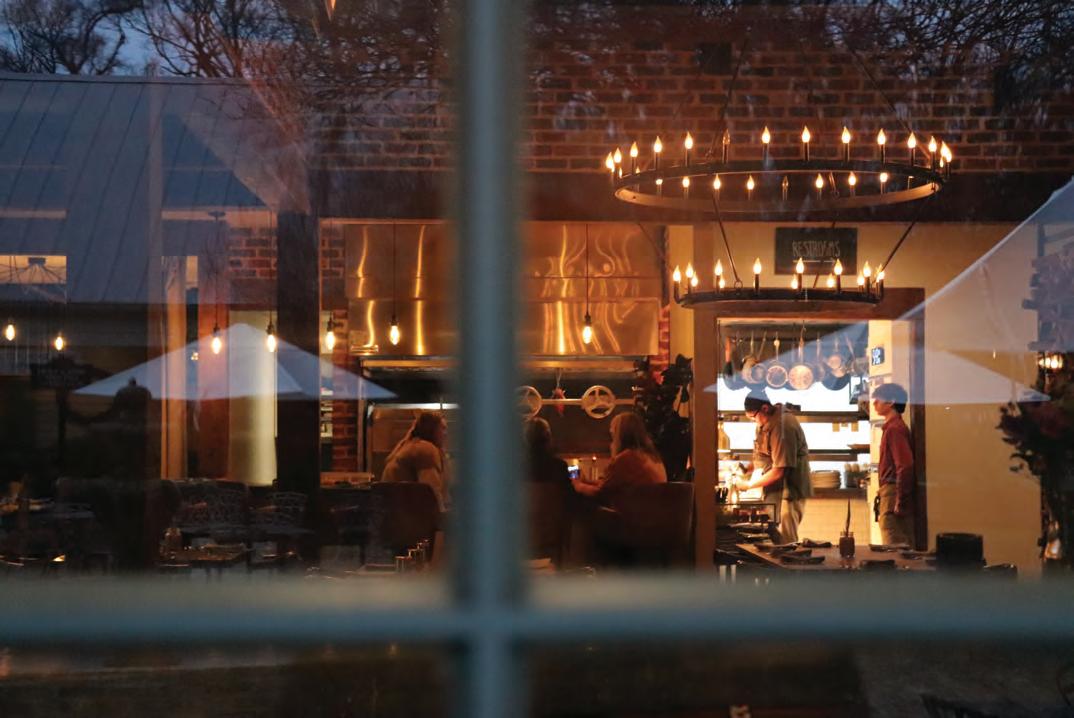
newhourslounge
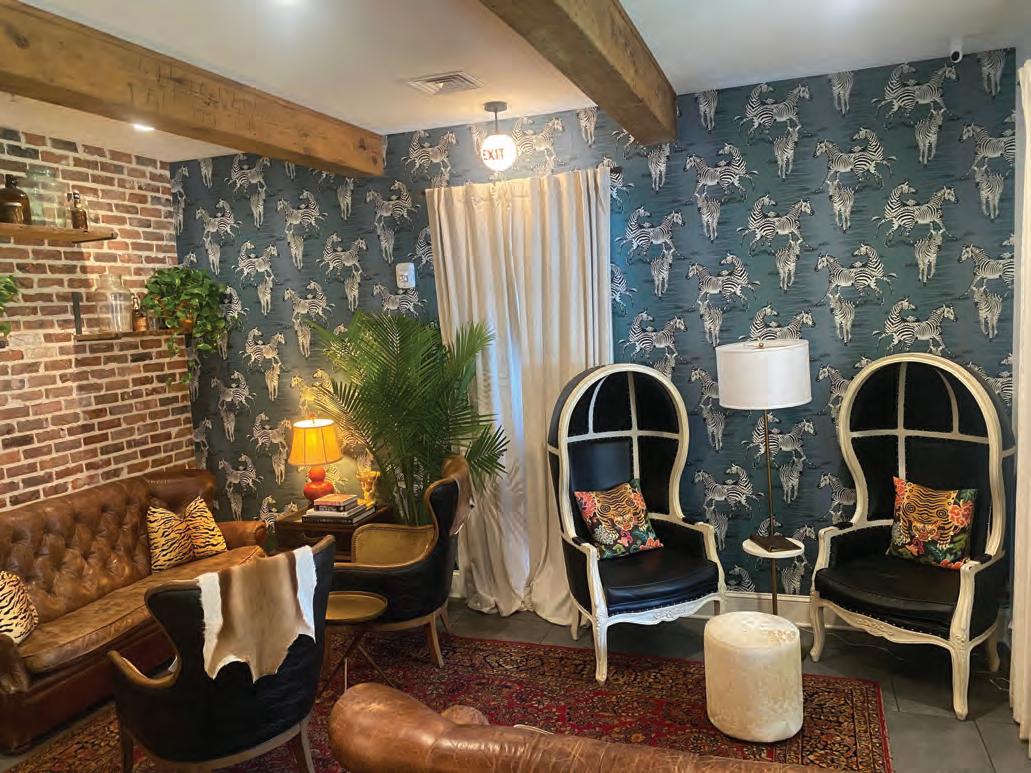



monday - thursday 4:00 - 9:00pm
friday 4:00 - 10:00pm

saturday 11:00 - 10:00pm
sunday 11:00 - 2:00pm
happy hour
monday - saturday 4:00 - 5:00pm







$4 draft beers
1/2 off 5oz wine
$9 speciality cocktails



// JULY 23 33
FRANCISVILLE - YOU’LL
LOVE IT HERE
Features
RECONNECTING WITH OUR FOOD

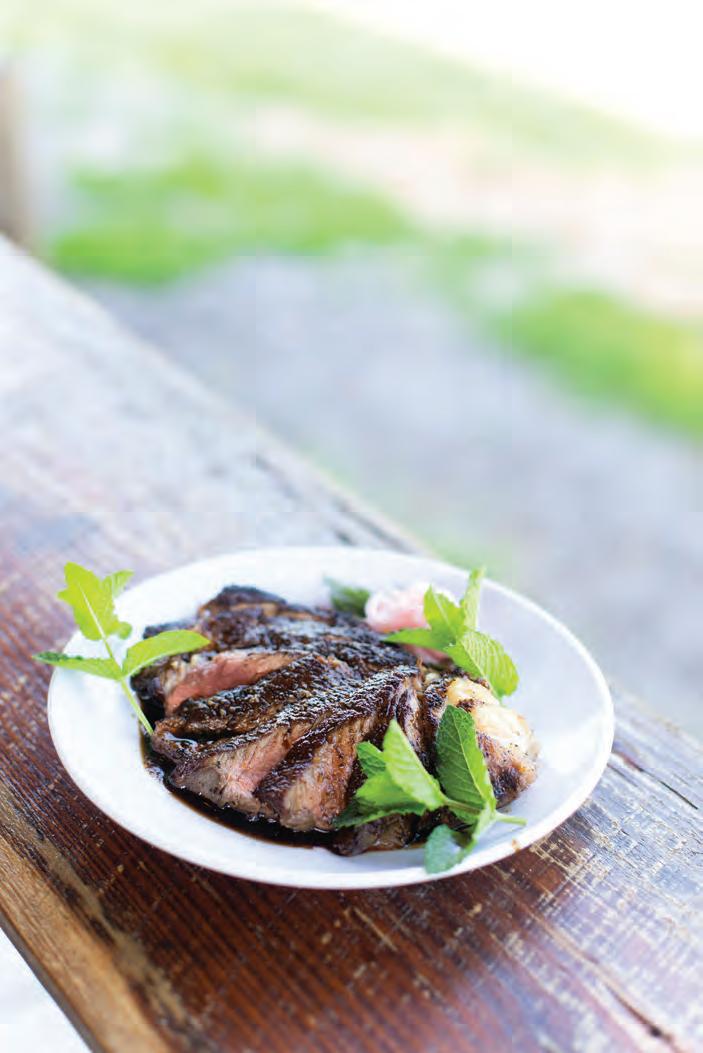
Home Place Pastures
RAISED WITH INTENTION, IN COMO, MISSISSIPPI
FRESH AS IT GETS
cides, and other chemicals) often from those same companies, investing in expensive equipment, taking out loans at the beginning of each season, and praying that rain, drought, insects, early frost, late frost, or any number of other things wouldn’t prevent them from paying them back. The joy of farming was dissipating.
“It’s a hard way to make a living, but the only way to farm was at that industrial scale,” Bartlett said. “My parents put a big emphasis on education to give my brother, my sister, and me opportunities outside of agriculture.” After 150 years and five generations, it looked like the Bartlett family was getting out of agriculture. Marshall went to New England to study anthropology and environmental science at Dartmouth College. His father began leasing out the family fields, although he continued running the cotton gin in town (something he still does at age eighty).
While at Dartmouth, Bartlett completed a college internship with the Virgin Islands Sustainable Farm Institute in St. Croix. There, he met others from the Southeast who, like himself, had grown up on commodity row-crop farms, didn’t want to farm that way, but felt an undeniable draw back to their homeplaces. “I met people there who were navigating the same challenge I was,” Bartlett said. “It was the first time I could admit to myself that what I really wanted was to return to the farm.”
The problem was, Bartlett was all too aware of the environmental damage industrial farming has wrought on a global scale, and he didn’t want to participate in that any longer. He began devouring books by regenerative farmer Joel Salatin—who advocates for a style of farming that enhances and enriches the land and the community around it. Salatin describes his method as “emotionally, economically, and environmentally enhancing agriculture”.
Bartlett reached out to fourth-generation cattleman Will Harris, who manages the land his great-grandfather settled in 1866, called White Oak Pastures in Bluffton, Georgia. Like Bartlett, Harris had grown up farming with a liberal use of pesticides, herbicides, hormones, and antibiotics—feeding his cattle a high-carbohydrate diet of GMO corn and soy, as is the norm in the industrial-ag model. But in the mid-1990s, Harris had done a complete 180, deciding to start managing his land and his cattle the way his great-grandfather had in the 1800s. His phenomenal success has elevated him to the status of a global leader in humane animal husbandry and environmental sustainability. Bartlett visited Harris at his White Oak Pastures, and the older man became a mentor to him.
Growing up on the farm his great-great -grandfather established in 1871, Marshall Bartlett tackled his share of farm chores. As early as age thirteen, he was actually punching the clock, helping with the cotton harvest, spraying insecticides, and operating farm equipment at Home Place Pastures. Without the interruption of school, summers meant even more time on the farm, punctuated by hours spent hunting, fishing, and exploring the woods with his dog. “This place was paradise for a kid,” Bartlett said. “It was a great place to grow up.”
Like most of their neighbors, Bartlett’s father and grandfather were row-crop farmers. At 1,700 acres, their family farm was small compared to many of the behemoth operations around them, all churning out commodity crops such as corn, cotton, and soybeans, then selling them to large corporations.
But agriculture has changed dramatically over the last several decades. Managing the family farm for fifty years, Bartlett’s father watched as his profession started to lose its autonomy and American row-crop farmers got stuck in a loop, buying patented seeds from big-ag companies, buying inputs (synthetic fertilizers, pesti-
Bartlett needed one more piece to fall into place, though. After graduation, he moved to New Orleans to serve a term with AmeriCorps helping rebuild the Ninth Ward after Hurricane Katrina. When he had completed his service, he still didn’t feel ready to return to the farm, and picked up a job selling meat to chefs in New Orleans. “I learned to butcher, and I learned that I could walk into a top restaurant, engage with the chef, and sell them my wares.” Bartlett also realized there is a big market for local meat, and a lot of farmers like himself who wanted to produce meat sustainably and ethically. They were just looking for a way to connect
JUL 23 // COUNTRYROADSMAG.COM 34
JULY 2023
34 FARMING WITH THE FUTURE IN MIND // 38 AT ST. JOHN, FARM-TO-TABLE PRODUCE GOES HYDROPONIC //40 FOR SUSHI, GRETA REID REFUSES TO REACH FURTHER THAN THE GULF •
MEAT
Story by Mimi Greenwood Knight • Photos by Shelby McClure
with the market. Bartlett wondered if he could be that connection.
His idealism was quickly met with intense and demoralizing realities. “There are a lot of things that have to occur between the production and the end consumer, and they’re compli cated, expensive, and challenging,” he said. He decided the linchpin would be setting up his own slaughter and pro cessing plant right there on the farm, so he could sustainably raise, process, and distribute his product directly to the consumer—something that’s not really being done in this country. “To have a truly impactful, scalable, regional food system, we needed to control it all— start to finish,” he said.
wide for her innovations in slaughterhouse design with a focus on making the slaughtering process more compassionate and less stressful for the animals. Bartlett was even able to consult with her on the construction of a humane slaughterhouse for his farm.


Another major aspect of his model features “closedloop farming,” where rather than importing grain to feed his cattle, he intentionally manages his pastures so that his livestock are able to gain the nutrition they need directly from the land and from the diversity of animals that inhabit it. He established complex grazing

Bartlett’s vision was to develop a model that would enhance the land, the community, the lives of the ani mals, and the health of the consumer. He started studying the work of animal behaviorist Dr. Temple Grandin—who has made a name for herself worldrotations whereby cattle, pigs, and chickens follow one another, each adding to the soil the things that the other depletes. “We’re practicing a style of agriculture that builds the soil,” Bartlett said. “It sequesters carbon and enhances the watershed, and the meat produced is more nutrient-dense than anything raised on an industrial farm.” And he’s doing it all sans antibiotics, hormones, steroids, insecticides, pesticides, and GMO grains. Such an operation requires a lot of hands, allowing Bartlett the opportunity to also enhance the economy of the surrounding area by adding jobs on the farm.
Where his father managed 3,000-acres of row crop, including rented land, with five employees, he is managing 300 acres of livestock with twenty-six employees engaged in sales, delivery, harvesting, processing, marketing, office administration, land management, running of the on-site store/restaurant/event venue, and organizing farm tours, music events, and a popular annual boucherie. Additionally, his slaughter facility is available for use to other local, sustainable farmers. “As long as they follow our standards, instead of hauling their livestock to the sale barn, they can bring it to us,”
// JUL 23 35
Bartlett said. “They save on the shipping costs, and I pay a premium price for ethically-raised animals. That adds revenue to Mississippi farmers and that money loops back to the community.”

Bartlett realizes though that, in the end, what the average consumer really cares about is the quality of the meat. Fortunately, the complexity and flavor of grass-fed beef and pasture-raised pork is


so inherently superior to their grain-fed counterparts that the product speaks for itself. Whether the customer is a celebrated chef in a high-end restaurant or a discerning home cook receiving a Home Place Pastures subscription box—the quality, flavor, and nutrient-density of Bartlett’s meats are his best advertisement.


Hunter Evans, the James Beard

Award-nominated chef/owner at Elvie’s Restaurant in Jackson, Mississippi, is an advocate of Bartlett’s local-food model. In fact, the menu at Elvie’s states clearly: “Elvie’s proudly serves produce and protein from Mississippi farmers and fresh Gulf seafood.” Evans and his partner, Cody McClain, have been sourcing meat from Home Place since 2016. “I can ask for what I want, like skin-on, or a
higher fat content for a specific dish, and they make it happen,” Evans said. “And the quality is much better than what I can get from mainstream distributors.”

In New Orleans, Domenica’s Executive Chef Valeriano “Val” Chiella is also a big fan and valued customer of Home Place Pastures. “We make all our charcuterie meats in-house and require the best of the best meats,” said Chiella. “Home Place hogs are superior because of their marbling and the rich flavors they bring to our salami.” Chiella said working with organic homegrown hogs means the flavor isn’t always the same, which allows him to bring a truly unique dining experience to the table.
Nine years into his regenerative farming adventure, Bartlett admits there’s still a gargantuan learning curve for him. “It’s been more challenging, eye opening, and all-encompassing than I could have imagined,” he said. “We’re still learning about the health benefits and qualities of pasture-raised livestock, the fat composition, the nature of the protein itself, and the micronutrients that only an animal raised on pasture can provide. People buy it because it tastes great, but they should also be buying it because it’s the best meat they can put in their bodies.” •
Learn more at homeplacepastures.com.



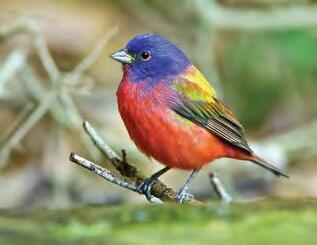

JUL 23 // COUNTRYROADSMAG.COM 36
visitportarthurtx.com
TRIP TO port arthur,
pack up for your perfect
Marshall Bartlett, the fifth-generation owner of Home Place Pastures, who is responsible for stewarding the farm’s future as a source of protein raised while keeping intention and sustainability top-of-mind. Get ready for surf, sand and sunrises in Port Arthur. Drive on over to Texas’ upper Gulf Coast for a family vacation overflowing with summer fun. From sports and music hall of fames at the Museum of the Gulf Coast to overnight camping and paddling one of three rated trails at Sea Rim State Park to fishing and beach combing at McFaddin Beach, and even filling up on the best Cajun seafood in all of Texas, you’ll love every memory-making moment.
ROAD
TEXAS

// JUL 23 37
GOING GREEN
Water Rich, Dirt Poor
Vines are curling up the walls of the old icehouse in St. Martinville. On the outside of the building, this would spell neglect–another forgotten building on a rural road. But the plants here are unfurling indoors, fruiting cucumbers, tomatoes, and the occasional eggplant for the restaurant that stands a few yards away.
At night, the lights pop on, drawing diners across the parking lot of the bustling St. John Restaurant to the illuminated windows. On display is a delicate operation to provide the restaurant with hydroponic, hyperlocal produce.
The St. John Restaurant owner Chip Durand conceived of adapting the old structure into a greenhouse—it’s actually an expansion—a few years ago, purchasing two small parcels of land adjacent to his restaurant from the City of St. Martinville: one includes the old ice house while the other stretches along Bayou Teche.
He laid out his plans to the City Council back in 2017, as reported by the Daily Iberian: “We’re going to use concrete from the ice house to build a greenhouse, and we’ll grow cucumbers, tomatoes— all our vegetables, year-round, to supply the local restaurants. And we’ll have a space there for a farmers’ market, and a place to raise chickens and ducks and geese. I raise cattle, so there’ll be some beef there too.”
Ongoing labor shortages make him hesitant to pursue the full vision, which includes a country store along the bayou that will sell beef, duck, and eggs from his own farm, Durand Ranch. “If I knew I had the help, I’d start in two weeks. Before COVID, we’d get some sort of application almost every day. Last year, we got twelve or fifteen, total.”
In the twelve years since he took over the restaurant from late owner Chef Craig Baudoin, Durand’s plans have been cautious but constant. The restaurant quickly outgrew its forty seats after Durand took over, and the business
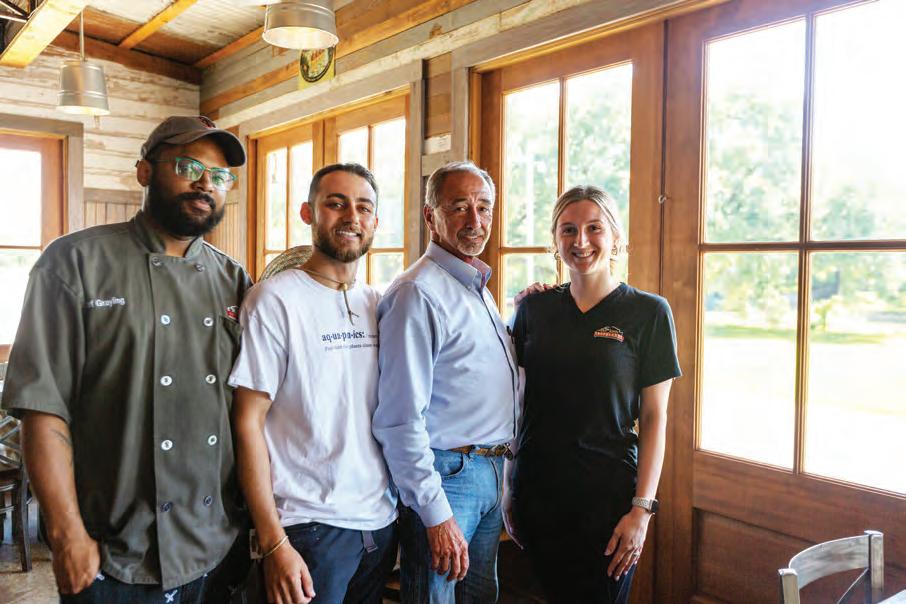
relocated to the old Talley pecan warehouse in 2014. Renovations celebrate the warehouse’s original wood, and Durand built the sunburst light fixtures himself, from metal pipes and buckets. You can almost taste the history—or you can actually taste it if you treat yourself to the J.B. Talley Pecan Warehouse Pie or the mind-bogglingly good Pecan Praline Bread Pudding, both showcases for current chef Grayling Thibodeaux’s background in pastry.
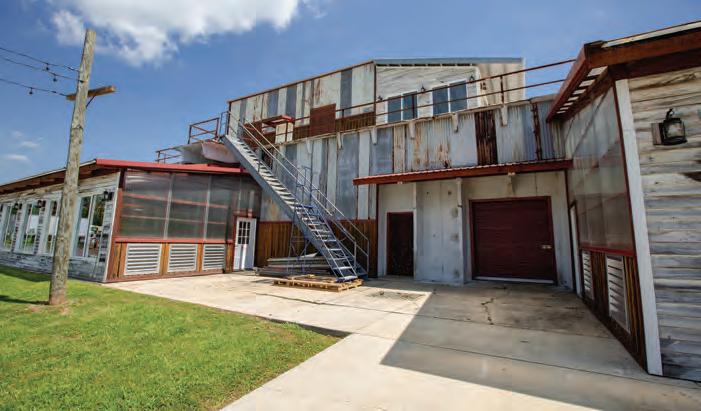
Durand and Thibodeaux have kept most of Baudoin’s menu, with bestselling dishes including Chef Craig’s Original Jumbo Lump Crab Cake. Quality ingredients are prized— “I drive down to New Iberia every Wednesday or Thursday to get the crab meat fresh,” said Thibodeaux, and the steaks are all Certified Angus Beef. While the menu does not explicitly state that the cucumbers and tomatoes are now grown onsite, and have been since January 2023, the greenhouse grabs attention. Sales are on the rise for these relative bit players in a steak & seafood environment.
The most efficient way to enjoy The St. John’s ethos is the beef tenderloin salad. The house-grown cucumbers and tomatoes are sliced and layered next to juicy cubes of steak with a crisp bed of lettuce beneath. Lettuce is an upcoming addi tion to the greenhouse. “The goal is to

eventually have everything in that dish come from here,” said The St. John’s new farm-to-table director, Luke Dugas. The twenty-five-year-old St. Martinville native graduated from LSU in environmental engineering before moving to Denver, where his work designing and installing indoor farming systems took him all over.
“Before this, I was traveling to different schools around the country,” he said. “I’d build the systems and have seminars on how to operate them. It’s proven that with these hydroponic and aquaponic systems, you can teach an entire K-12 curriculum in life sciences, chemistry, and biology. It’s a really big passion for me–to teach people.”
He started his relationship with The St. John as a consultant. “Chip knew he wanted to do something hydroponic and sustainable, to take a farm-to-table direction with the produce. We spent about a year going back and forth, putting together some designs and plans. Before you do a project like this, you really need to estimate how much space you have and how many vegetables can be produced.”
Dugas joined the team full-time last fall. “I built out all of these systems, cut the wood, did the plumbing, and now I’m here managing the systems and also doing some training to upkeep them,”
he said. New team member Delanius Narcisse, or “D,” has been an asset. “I couldn’t do any of this without him,” said Dugas.
The greenhouse currently supplies half of the cucumbers and tomatoes the restaurant uses and is scaling up to meet the whole need. Dugas uses the Dutch bucket system in his design. “People have different strategies; you can spend decades learning,” he said.

Each plant is rooted in a small white bucket containing perlite, a volcanic rock. “It gives the root something to hold onto. You want a material that water can pass through and drain and will also keep air in it too. Air is really important.”
The buckets are connected by tubes to a large reservoir of water, rich with nutrients that Dugas has picked out specifically. “It’s all set on a timer, which comes on once every hour for about five minutes to irrigate the plants,” he said.
Water drains from the plants and back into the reservoir to be used again. Durand and Dugas dream of expanding the operation into aquaponics, in which fish and plants are raised in the same water—the fish fertilize and the plants purify. “We’ll do the catfish farm after the country store,” said Durand.
He took a long sip of iced coffee, which he says is necessary fuel for all his ongoing ventures. “Hey, maybe we roast our own coffee next?” he called over his shoulder, already on the move back to the restaurant.
The crowd packed in as soon as the doors opened for Friday lunch, and I squeezed in on the side porch. I treated my fork as a spear, targeting all the fine ingredients I now know came from so much care. The sweet potato fries disappeared in a cloud of steam, and the culprit hid her orange fingerprints. The pecan praline bread pudding fell in the category of “I shouldn’t, but how could I not?” Bayou Teche moved slowly outside the window. The land between it and me was bare for the moment, but with a vision, a system, and regular bursts of nourishment, I expect we’ll see something sprout soon. •
JUL 23 // COUNTRYROADSMAG.COM 38
ST. JOHN RESTAURANT’S FORAY INTO HYDROPONIC, HYPERLOCAL PRODUCE
Story and photos by Lucie Monk Carter
Left: The beef tenderloin salad, a dish the folks at St. John have ambitions to soon make entirely from ingredients sourced onsite. The tomatoes and cucumbers are already grown in the hydrponic greenhouse. Right: From left to right—St. John Chef Graying Thibodeaux, Farm-to-Table Director Luke Dugas, owner Chip Durand, and Durand’s daughter Whitney.

// JUL 23 39
Raw Deal
BY SUSTAINABLY SOURCING LOCAL SEAFOOD, GRETA REID

IS CHANGING THE WAY LOUISIANA PERCEIVES SUSHI
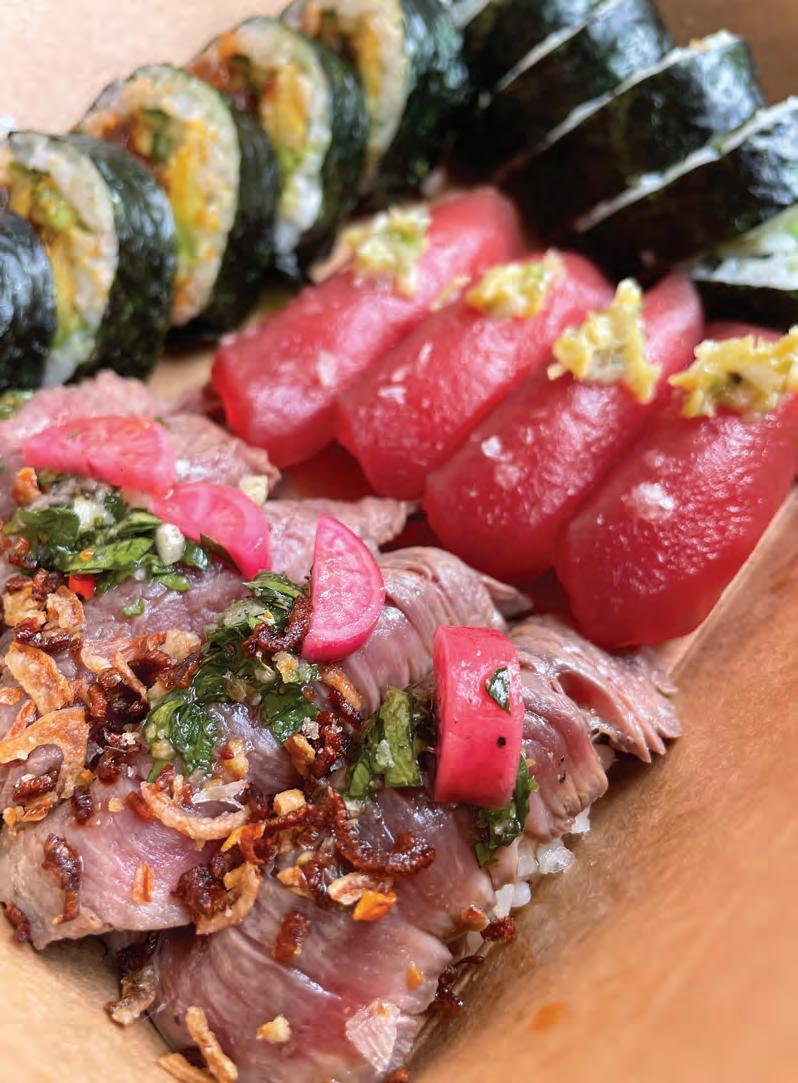
 Story by Alexandra Kennon
Story by Alexandra Kennon
Starting from the Tatami Mat
Sushi has fascinated Greta Reid since she was small, around seven or eight years old. Her parents would bring her to a restaurant with a traditional tatami room, where she felt she was being transported to another universe. She’d sit down on the mat, captivated by the bite-sized rolls. She remembers how excited she was to order in Japanese, whether or not the server actually spoke the language—clumsily and proudly sounding out unfamiliar words like “maguro sushi”.
“Being like, taken into another world just seemed so interesting to me,” she explained over locally-brewed lavender kombucha outside Hey Café in New Orleans, overlooking the Lafitte Greenway. Her dad was a big fan of Japanese animation, and Reid attributes her fascination with Japanese food and culture in part to growing up with “such an anime nerd” and watching with him from a young age. “I think seeing Japanese food like that made me really interested to eat what I was seeing on TV.”
Getting Behind the Bar
Reid entered the restaurant industry at twenty years old while attending college at the University of Minnesota in Minneapolis, proving her mettle as a food runner carrying thirty-pound platters to and from the upstairs kitchen at a restaurant called Chino Latino. “I kind of proved that I was in it to win it there. And I stuck with it,” she said. “So I got some respect from that.” The restaurant had a sushi bar that Reid at first eyed from afar, until a sushi chef named Ana insisted that if Reid
loved sushi, she should train to make it. “I love that a woman convinced me to join on,” she remembered with a smile. “And then, after months of begging these chefs, they finally let me try it out.”
That whole summer between semesters, Reid would go into the restaurant, even on her days off, to study under the sushi chefs. When a spot finally opened up, Reid was already trained and ready to step up to the bar. “So I got in right away. I was lucky.”
Following the completion of her undergraduate degree, Reid felt herself torn between two futures: Move to Denver—a place as landlocked as it gets—and complete her Master’s degree in child, family, and school psychology; or pursue this passion for sushi-making. Fate, it turns out, would pave the way for her to do both.
Right around the same time as her grad school move in 2018, the acclaimed sushi Chef Tyson Cole chose the Mile High City as the home for the newest iteration of his James Beard Award-winning Uchi Restaurants. Shortly after her arrival, Reid took the job as sushi chef. “Which was the craziest two years of my life, I'll say for sure,” she said, recalling this period of juggling graduate-level academia while simultaneously gaining more in-depth training in sushi-making at Uchi. “That's where I learned a lot of my chops and got really refined with my stuff that I do,” she said.
Meanwhile, she was putting together her master’s thesis—a study on the positive impacts green spaces in schools can have on a child’s development. Conducting that research got her thinking about the importance of environmental sustainability in all areas of
JUL 23 // COUNTRYROADSMAG.COM 40 ROLL WITH IT
her life—particularly in the American sushi industry, which sources significantly from international waters.

“So along with that, sustainability and connecting with local farmers and all that became of more importance in my head.”
Reid completed her masters just before the pandemic hit in 2020, and then made the move to New Orleans.
“I did not know how to use my degree at all,” she said, acknowledging that it was a tough time for anyone to set out on their career. “But I knew how to do sushi.”

At this point, her opposing passions for sushi and sustainability were starting to clash. It was difficult to feel good about working at a restaurant that was almost exclusively importing fish from across the world, causing excessive CO2 emissions and neglecting the local seafood industry in the process. And she soon discovered she wasn’t the only person with these concerns, observing the growing movement of people in Louisiana and beyond who have sworn off eating sushi entirely. Passionate about both sushi and the environment, she wanted to find a solution to bridge that gap.
“I want everyone to eat sushi,” she said. “If this guy's telling me that he doesn't eat it because of a sustainability issue, that’s something I want to face head on.” Seeing the opportunity in front of her to join her two passions in a meaningful way, in February 2021 Reid officially started her pop-up restaurant, Greta’s Sushi—New Orleans’ first sustainability-focused sushi purveyor.
Reaching
into the Gulf
Reid made her first local fish contact through Instagram.” So that's kind of how it started . . . someone posted something saying like, ‘If anyone needs a snapper connect, hit this guy up,’ ” she said. To this day, Michael Dang provides Reid with fresh gulf mackerel, cobia, and other local fish varieties for her dishes.“ “He's just like, my independent local fisherman that I love to go through.”
For produce, Reid scopes out the various offerings and producers at the Crescent City Farmer’s Market, which sets up in City Park on Sunday mornings and in other New Orleans neighborhoods on various weekdays. “Even if I don't need to buy anything for an event, I like to see what's in season and what farmers are starting to get so I can start thinking about different dishes that I can run for whatever season is coming up,” Reid explained. “But I like to try and shift things with seasonality. Again, always trying to buy from local farmers first.”
For other produce and seafood, she often utilizes Destrehan-based wholesaler and “online farmer’s market” JV Foods—which is a “chef- and restaurant-driven” distributor to the New Orleans area and larger Gulf Coast. Part of its mission is sourcing locally to promote sustainability and environmental consciousness, too— lining the company right up with Reid’s goals for her own pop-up operation. Most of JV Foods’ inventory comes directly from Louisiana farmers and fishers, with occasional products offered from purveyors in Texas, Alabama, and Mississippi. Occasionally, for harder-tofind special produce like finger limes, JV will utilize a farm connection as far as California, but Reid appreciates that they prioritize locally-grown, smaller businesses, and that quality is always assured.
When she first started Greta’s Sushi, Reid’s intent was to not include a single ingredient that was imported; to exclusively use local fish and farmer’s market produce. For practical reasons, she’s lowered this threshold a bit, though she still considers local sourcing an utmost priority. “Over time I’ve become a little bit more lenient, because it’s hard to always locate local stuff,” she told me. “And like, I couldn't use avocados, which just go really well with sushi.”

// JUL 23 41
A One-Woman Act

When it comes to operating a one-woman sushi business, finding affordable local ingredients is only a fraction of the challenge. “Meeting up with people is so much fun, and connecting with the farmers and the fishermen,” Reid said. “But also, there’s so many other parts of my job, being a one man show. Cooking is like . . . I wish that was the priority of it.”
Besides the sourcing and cooking, starting Greta’s Sushi involved booking events and pop-ups; creating flyers, logos, and menus; marketing her burgeoning business, and more. “Sometimes I felt like I was a fulltime dishwasher, more than anything else.”
Reid admitted that she misses watching others work and learning new skills, a definite drawback to cooking by herself. “I haven't been able to continue my training in a while,” she told me, acknowledging that the impact of learning under another chef can’t fully be replicated by watching YouTube videos alone. “And I'm definitely not done learning.”
This June, she had the opportunity to continue her sushi education by helping a former coworker from Denver’s Uchi open a new restaurant called Rosella at the Grand Hotel in Kennebunkport, Maine, which also has a focus on sushi crafted with local fish. When we talked, she was particularly excited to make sushi with porgy—which is typically viewed as a “scrub” fish of poor quality, but Reid asserts is actually a nice, white bream fish, and a perfect candidate for the sushi treatment. Much like bluefin tuna was at one time viewed as low-quality because of its oiliness—but has benefited from evolving perceptions as the market has shifted its preference to value fattier fishes—Reid thinks many traditionally cheaper fish varieties have the potential to be great sushi ingredients, if only consumers open their minds beyond standards like tuna, sea bass, and salmon.
Helping to open Rosella—which is already garnering considerable press and award consideration as the sustainable sushi movement grows—has helped Reid sharpen her skills while continuing to change perceptions about Louisiana’s Gulf seafood back at home.
Sushi for the Future

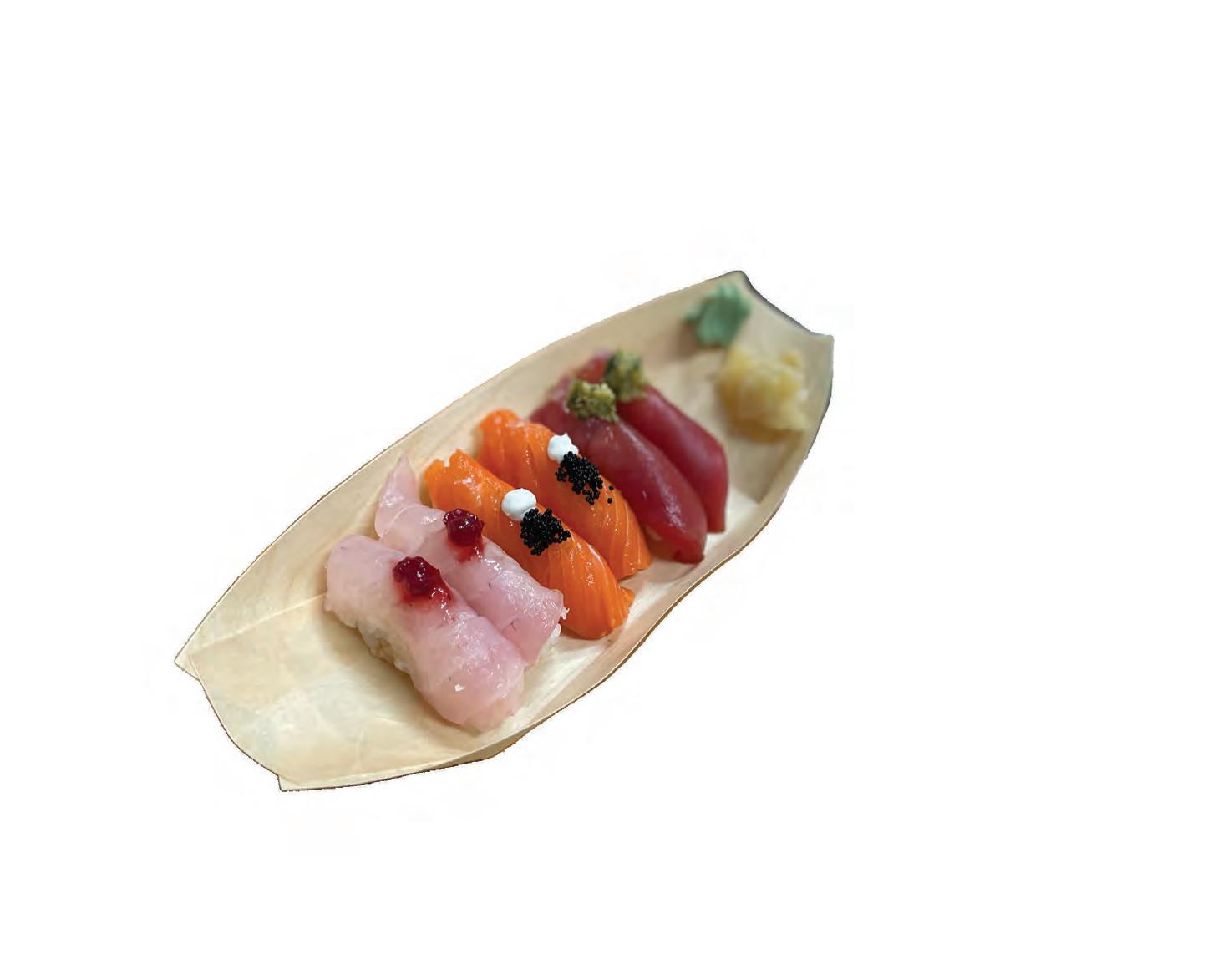
With all of this momentum, and the positive reception Greta’s Sushi has received thus far, Reid has begun to consider someday opening her own restaurant. “I thought I was going to use my masters, but I’m really happy going down this road. And Greta's Sushi has been popping off recently,” she said. “So I'm really excited about it. And now I’ve gotta stick with it.”
Besides eventually starting a brick-and-mortar, long-term goals of Reid’s include partnering with New Orleans nonprofit organizations to teach the art of sushi-making to kids who may not otherwise have the opportunity to be exposed to it. “I do like to help give back to the community however I can,” Reid told me.




But this July, now that she has returned to Louisiana with sharper skills than before, she’s continuing to pop-up with Greta’s Sushi at various local bar residencies—including Rabbit’s Foot and Tell Me Bar. She’s also going to continue to host private multi-course chef-curated Omakase dinners, which translate from Japanese to “I’ll leave it up to you, Chef.”
Through it all, sustainability remains a prominent focus—and Reid is hopeful that the movement will extend far beyond her own business and even the sushi industry, and that more restaurants will begin to offer sustainable specials lists, or indicators on the menu for local products. And for the sake of our planet as well as our local

communities, she hopes that it isn’t only the sushi industry that’s moving in that direction.

“With sushi, it's all about enjoying your craft and honing in on what you know—I feel like we could all do that,” Reid said. “And become more sustainable in everything that we all do independently, in all of our own niches and jobs that we take part in—to integrate and to figure out ways to make it more sustainable, because that's what the future needs. Working with your community or working locally, I think that will help make everything more sustainable.” •
Keep up with Greta Reid’s upcoming pop-ups on the Greta’s Sushi Facebook and Instagram.



JUL 23 // COUNTRYROADSMAG.COM 42
The LOCAL resource since 1983. Registration open ALZBR.ORG OCTOBER 28, 2023 2023 Honorary Walk Chair Jay Johnson Jay Johnson LSU Baseball Head Coach CORPORATE PARTNERS Ask us!





// JUL 23 43
Cuisine
How to Make West African Okra Stew

’m pleased to report that Western-style supermarkets remain a rare enough phenomenon in Cotonou, Benin’s largest city. While I was there, I did eventually find one—all boxed away from the public with security guards at the entrance. This is where I got my quick fixes of frozen pizza, Pringles, Coca-Cola products—things shipped in from other countries at a pre-
For everything else, though, I ventured to the sprawling chaos of Dantokpa Market, the largest open-air market in West
As a native of Louisiana, I came here scouting the ingredients for okra stew, the West African dish that historically lent itself to the beloved gumbo of my home
I was told to begin my journey to Dantokpa in the early morning, at the advice of a local friend and tour guide named Jean-Paul Houndagnon, a Beninese citizen who helped me find backroad cafés and Vodou markets in neighboring Togo.


“Where can I find the ingredients for gumbo stew?” I had asked him.
“Oh, that’s easy,” he answered. “My mother makes it all the time. She could easily show you where to go! She could probably even make some for you.”
My colleague Ben Dome, a UK-based photographer, and I were instantly intrigued. We asked if we could meet them in the morning. It’s one thing to simply know the ingredients for the dish; it’s an entire honor to purchase them alongside locals, and then to observe how they are meant to be prepared and cooked, inside their home.
“This would be a great time to wear your West African clothes,” Houndagnon said, alluding to the traditional garments he’d helped Dome and I find and tailor a few days prior in Togo. While there are different names for this style of men’s clothing, it essentially consists of a loose tunic shirt with matching pants. Styles vary slightly, but the designs of the shirt and pants almost always match. Sorting through literally thousands of
options in a fabric shop can take hours, and locals specifically look for designs that represent their mood, personality, and taste.
“Really?” I asked, cautious from American conditioning of avoiding cultural insensitivity or appropriation. “Should we really do that?”
“Absolutely,” Houndagnon said. “Everyone’s going to love it!”
The next morning Dome and I woke up with a slight hangover from a dinner of Beninese rum and imported Pringles, eager to make our way through Dantokpa Market with Houndagnon and his mother, Augustine. As instructed, we donned our West African slacks and shirts and set out for the market.
We made our way through corridors and crevices of this vibrant and noisy marketplace. On one end, stacks of textiles, plastic buckets, tools, and toys created a seemingly endless backdrop against which sellers shouted and negotiated with buyers. On the other side, hundreds of goats bleated and stomped the ground, raising clouds of dust amidst the clamoring of shoppers deciding between livestock or butchered meat.
As we ventured deeper into the market, things became quieter. We made it to the food and vegetable area. Augustine whipped out a sheet of paper, her grocery list.
“This is everything we need,” she said. “Fish, shrimp, crab, salt, oil, and of course, gombo!” she said, referring to the large bag of okra we would need to create the stew. This humble vegetable has a storied past, traveling with enslaved West Africans—in their pockets and in their hair—to port cities in South America, the Caribbean, and the Port of New Orleans. After several generations, the vegetable would undergo significant evolutionary modification, and eventually become a key ingredient of Louisiana’s gumbo—whose name is believed to originate from this West African ingredient.
And so, we made our way through this bustling vegetable section, gathering all the things on Augustine’s list. Jean-Paul

NO PICKY EATERS HERE
JULY 2023
44 SEARCHING FOR THE ORIGINS OF GUMBO IN WEST AFRICA // 47 UNLIKELY CONNECTIONS BROUGHT THIS MYCELIUM FARM INTO BEING
CULTURAL
CONNECTIONS
THE
SEARCHING FOR
ORIGINS
OF LOUISIANA GUMBO IN BENIN'S DANTOKPA MARKET
Story and photos by Jody Ray
Top: A traditional West African okra stew requires two to three pounds of okra, a vegetable used in Louisiana gumbos as well, that was originally brought to North America by enslaved Africans.
Middle: Dried shrimp for sale in the Dantokpa Market. Bottom: Curded cheese, frying for the stew— an unexpected addition to Western ideas of a "gumbo," but one that the writer assures was especially delicious.
helped us negotiate (an expected backand-forth in West Africa) as we drew ire and laughter from locals who slapped their knees at the sight of two white men in traditional West African dress. By the end of our shopping spree, we squeezed into a taxi back to Augustine’s home a few miles away with the following ingredients, enough to make a stew to feed approximately six to eight people:
Whole African mackerel fish (5-10)


Small live crabs (10-15)
Salted fish (approximately 5)
Dried shrimp (8-10 ounces)
Curded, large chunks of cheese (approximately 10)
Cow skin (4-6 large pieces cut up into strips)

A very large bag of okra (2–3 pounds)
Small green and red chilis
Two onions
Two tomatoes
A variety of herbs
Salt (to taste)
Palm oil (two bottles—355ml x 2)


Note: Sometimes African eggplant is added, but we did not purchase any this time.
Western purveyors and enthusiasts of Louisiana gumbo might raise their eyebrows at ingredients like curded cheese, cow skin, and the hefty surplus of okra. But these are all the things that make this dish particularly West African. They
seem strange to westerners because they have been lost, phased out with French and Native American influence. The gumbo that we are accustomed to in Louisiana is an amalgamation of these West African ingredients, joined with a French roux and flavored by Native American sassafras and other spices.
tine’s front yard, with various ingredients boiling over three small fires we built. Augustine doled out the chores: I gutted mackerel and sliced okra, Ben sautéed cheese and sliced cow skin, Augustine ground up shrimp and chilies into a fine paste with a stone.
boiled separately and added to a large pot of pungent reddish-orange palm oil. The sautéed cheese becomes hardened, almost like haloumi, and is added near the end. But what really makes West African okra stew is the copious amount of okra that cooks down for hours, creating a thick, gelatinous green sauce in which all the seasoned bits of fish, crab meat, shrimp, cow skin, cheese, and other vegetables are suspended.
Wreathed in fire smoke and boiling steam, the entire process took almost three hours to complete. We began at dusk, and by the time we sat down at Augustine’s table, the night insects had already begun to sing.
Instead of eating this with a spoon over rice, the West Africans use fufu, a

sort of sticky dough made from cassava, plantains, and cocoyams. To eat the stew, we’d take a bit of fufu between the fingers and scoop the ingredients of the stew with it. The okra draws from the bowl like melted cheese from a hot New York pizza, holding bits of delicious crab, fish, cow skin, shrimp, and fried cheese.
If you can find it in the United States, West African okra stew will be an entirely new experience for gumbo enthusiasts. The gelatinous texture of the okra, and the rubbery form taken by the cow skin even after it has boiled required some adjustments from our Western palates. But we found delight in this stew, from which
so much other culture has been drawn. And as for the cheese curds, they were absolutely delicious, and I’d argue an ingredient worth exploring in some Louisiana kitchens. •

Check out more of Jody Ray's adventures through his project, Exit Strategy—which aims to discover more of the world through culture, conflict, and cuisine. You can find videos from his experience cooking okra stew, as well as other experiences from his time in West Africa, on the Exit Strategy Youtube.

//JUL 23 45
The final product, a traditional West African okra stew—a predecessor to Louisiana's beloved gumbo.
ON VIEW AT THE LSU MUSEUM OF ART AUGUST 3–DECEMBER 3, 2023 Celebrate the opening with a performance of
classics
Reception
to attend. Reception refreshments sponsored by Winnfield Funeral Homes. 5th floor Shaw Center for the Arts Downtown Baton Rouge, LA lsumoa.org Opening Reception & Performance Thursday, August 3 6–8 PM IMAGE: Sheila Pree Bright, Paul R. Jones, 2010. Chromogenic print, The Paul R. Jones Collection of American Art at the University of Alabama. AT THE UNIVERSITY OF ALABAMA ART FROM
Nina Simone
by Chloé Marie.
follows. Free


JUL 23 // COUNTRYROADSMAG.COM 46
MICRO-FARMS
Flesh of the Gods
FROM SPAWN TO FLUSH, THE STORY OF MUSHROOM MAGGIE'S
 Story by Mimi Greenwood Knight • Photos by Kimberly Meadowlark
Story by Mimi Greenwood Knight • Photos by Kimberly Meadowlark
Ours is not the first civilization hto recognize the indisputable cool of mushrooms. For centuries fungi has spawned folklore across the globe. Think fairy rings and mushroom sprites. The ancient Aztecs considered mushrooms the “flesh of the gods”. Even mushroom terminology has a sense of glamour to it: substrate, mycelium, pinning, flushing, fruiting. Then, there’s inoculation, cultivation, colonization.
For Maggie Long and Cyrus Lester of Mushroom Maggie’s Farm, who spend their days surrounded by these ancient, unearthly organisms, the coolness factor is as sharp as ever. The husband-and-wife team is quick to point out that raising mushrooms for a living is also a lot of hard work. This is no mere cottage-core fantasy, frolicking through the woods plucking chanterelles. Farming mushrooms on the scale that Long and Lester do involves entire days spent trimming unwanted parts off the mushrooms before they’re packaged and delivered to restaurants in New Orleans, Baton Rouge, and New Roads or to eager customers at Red Stick Farmers Market. 5,000 pounds of substrate (sawdust, soybean hulls, and other agricultural waste) must be mixed by hand each week before being sterilized, inoculated, and eventually divided into “fruiting bags” and moved into the fruiting room. And of course, there’s endless cleaning, sterilization, strict temperature control, and circulation requirements.
Tediousness aside, there’s an inescap-
able sense of magic happening inside the red metal barn/laboratory tucked away down a verdant country road on the outskirts of St. Francisville. Just step inside the fruiting room, surrounding yourself with these wondrous life forms that are genetically closer to humans than they are to plants and it’s easy to submit to the seduction of fungi, to appreciate why mushrooms were once said to originate from Zeus’s lightning bolt or St. Peter’s spit.
The Origins
Long and Lester’s partnership was an unlikely one. The two reconnected at the funeral of Lester’s brother, who had been a friend of Long’s since childhood. Lester was incarcerated at the time, and had been given a day pass to attend the ceremonies. When Long got home, she penned a letter to Lester not realizing he’d done the same. Their letters passed in the mail. A robust correspondence began and in one subsequent letter, Long made a proposal, “Start a farm with me”.
“I’d always been interested in farming,” she explained. “Farming is something honest and humble, selling the fruits of your labor.” Long began researching specialty crops they could grow together when Lester was released. She came across statistics from the US Department of Agriculture listing mushrooms as the second most profitable crop (after marijuana). The two knew nothing about mushrooms and retrospectively admit they didn’t even like them. They had no land and no cap-
ital to speak of. But they had time. In the months leading up to the end of Lester’s sentence, they started learning all they could and laying their plans.
From Spawn to Flush
Once Lester was able to join Long in 2016, they began their enterprise slowly, inoculating fifty five-pound blocks of substrate with mushroom spawn each week, both still working other jobs to fund the venture. Seven years later, it’s 550 ten-pound blocks producing 1,200

pounds of oyster, chestnut, shiitake, maitake, lion’s mane, enoki, and other mushrooms. Mushroom Maggie’s Farm now supplies fungi to twenty top New Orleans restaurants and many more closer to home—Long frequently collaborating directly with chefs as they plan their menus. The mushrooms have to be harvested twice a day (Lester says it’s “like milking cows.”) and sometimes three or four times so they’re at peak quality.
Of course, it hasn’t always been smooth sailing. In fact, after their first year of farming, they finally had their first flushes ready to sell, when a fire destroyed the entire operation and left Lester with burns over seventy percent of his body. They started again at ground zero and spent the next year rebuilding. Things were moving forward at a promising clip when the pandemic closed area restaurants and they found themselves with a crop no one was in a position to buy.
Now, three years later, things are going full tilt with four full-time employees and plans in the works to produce mushroom-based products such as seasonings. More than ever, Long and Lester hold dear the people who gave them their first breaks including Ma Mama’s Kitchen in New Roads and Commander’s Palace in New Orleans. “Our goal was to build something to make our kids proud,” Long said. “We didn’t get here by ourselves. A lot of people helped us and believed in us early on. Any success we have is partly thanks to them.” •
mushroommaggiesfarm.com
After falling in love while Cyrus Lester was serving out a prison sentence, he and Maggie Long decided they wanted to start a farm together. Today, in St. Francisville, they own and operate Mushroom Maggie's, one of South Louisiana's best known mushroom farms.
It was the early 1970s, at noon on a Thursday or a Friday. Housewives across Acadiana were preparing lunch, little kitchen TVs turned to Channel 10—Bill Bessun’s typical greeting, “Hi, Bill Bessun here, you’re watching Meet Your Neighbor Acadiana" playing in the background. Looking up from the pot or the oven or the sink, they saw something curious on the television screen: a squat little machine, and a hand scooping rice into it. The camera then zoomed out, focusing again on Bill—who was proceeding as usual. “Hm,” they mumbled, stirring and scrubbing away. The show went on, every now and then panning back to the odd pot of rice, which had started to steam.
Finally, about halfway through the show, Bill looked at the camera and smiled. “Now, if y’all were wondering what we were doing when the show started …”—the camera zoomed back in on the machine—“what we’re doing is making perfect rice. In a Hitachi rice cooker!” At this, someone lifted the lid and reached in with a spoon, pulling out a fluffy, steaming pile of medium grain rice. “You can now get one of these for yourself at Floyd’s Record Shop over in Ville Platte.”
“And the phones never stopped ringing after that,” Floyd Soileau remembers of the most successful advertising campaign of his career. “The ladies were sold on it.”
The Hitachi Rice Cooker's Arrival in America
The mid-century Japanese invention had already risen as a symbol of women’s liberation half a world away—after a Toshiba washing machine salesman discovered that washing clothes was less trouble for Japanese women than the task of preparing three rice-based meals a day. When the salesman proposed the idea of an automatic rice cooker to an engineer, who did not know how to cook rice, the engineer’s wife Fumiko Minami set herself to the task—developing the model still at the base of the appliance almost a century later. During the first year, Toshiba sold 200,000 rice cookers a month. A manufacturer’s race ensued, in which companies across Asia rushed to create their own prototypes. One of those was Hitachi.
By 1958, Hitachi rice cookers had made their way across the Pacific to Hawaii—whose Asian-influenced cuisine also heavily incorporates rice. The trend slowly stretched its way to California—one of the earliest mainland advertisements for the appliance (promoted

as being sold at a local Asian market) appearing in the Stockton Evening and Sunday Record in 1966.
At the time, Americans who encountered the rare machine considered it a foreign novelty more than a revolutionary tool. Hitachi had bigger fish to fry in the American market than a rice cooker—and was devoting more time and advertising money towards their automotive, electronic, and computer products.
But somehow, in the years between 1966 and 1970, the Hitachi rice cooker made its way to Acadiana, where hundreds of miles of fields were freshly a-wave with the products of the still-emerging rice farming industry, and where the regional diet was largely made up of rice dishes like gumbo, jambalaya, étouffée, boudin, and daily plates of rice-and-gravy.
There is more than one origin story attempting to explain the Hitachi rice cooker’s arrival in Acadiana, all difficult to verify with certainty. But newspaper archives show that a Lafayette Asian market called Tomiko’s was
placing advertisements for the product in the Daily Advertiser in 1970, selling it as a machine (priced at $26.50) that “Cooks perfect rice every time—automatically— and STAYS HOT AS LONG AS YOU WANT!” At the same time, regular advertisements in the Alexandria Town Talk were promoting them in the classifieds at a price of $19.95, and with a choice of colors.
It was around this time that two Evangeline Parish businessmen, totally independently, encountered the product that, in their hands, would come to revolutionize Cajun and Creole cooking.

Guillory Wholesale
It is difficult to pinpoint exactly when Bruce Guillory and his wife Gladys, owners of Guillory Wholesale in Mamou, first started selling the Hitachi rice cookers. In an article published in 2000 in the Ville Platte Gazette, Gladys cites the date as the mid-1970s. Their son Paul estimated the late 1960s or early 1970s—which is likely
JUL 23 // COUNTRYROADSMAG.COM 48
48 HOW REVOLUTIONIZING CAJUN COOKING WAS A MATTER OF GIVING WOMEN MORE TIME OUTSIDE THE KITCHEN // 52 REFLECTIONS ON AFRICATOWN // 53 "ANOTHER DAY OF HIGH HEAT & HUMIDITY" // 54 CLARE CRESPO'S SECRET LIFE OF FOOD // 56 THE 50TH ANNIVERSARY OF GRIS GRIS MAGAZINE • JULY 2023
FOODWAYS
THE RICE COOKER BECAME A TOTEM OF LOUISIANA FOOD CULTURE
A GOOD VINTAGE
Culture
Hitachi HOW
Published in partnership with Télé-Louisiane
Story by Jordan LaHaye Fontenot • Photo by Lucius A. Fontenot
This article was published in partnership with Télé-Louisiane, who have published a French translation of the story on their website at telelouisiane.com.
more accurate; a Gazette article from November 1971 announces that Guillory Wholesale donated “one of those fabulous Hatachi [sic] 8-cup electric rice cookers” to the Mamou Volunteer Fire Department for their Christmas party raffle.
Regardless, according to Paul, Bruce first encountered the rice cookers at a trade show—likely in Chicago or Dallas. “As I recall, he initially purchased four rice cookers to try—one for my mom, one for his mom, one for Gladys Mayeux, and one for Hazel Deshotels (his two sisters),” he said. “All were pleased with their performance, and he then started selling them like hotcakes.”
Arthur Courville, who worked as a delivery man for Guillory Wholesale for fifteen years, remembers the first sale—“We retailed it for $13 a piece,” he said. “And the store made a profit.” It started slow, he recalled. But then “Before you knew something, we were delivering them by the case to the mom-and-pop stores in the country” from Crowley and Basile to Marksville. Once a week, Bruce would go to Lafayette and sell there— “he’s the one that really started pushing the rice cookers in the Lafayette area, too. He really sold a lot, and then it started expanding. I mean, it got to where we were selling … it was unreal what we were selling.”
In the 2000 Gazette article, Gladys explained that the product succeeded because the local people approved of it. The quality was still there, and it was less trouble for the cook.

Floyd’s Record Shop
Around the same time, Ville Platte record producer Floyd Soileau was working directly with Hitachi, selling their stereos, tape recorders, and televisions. (Again, the dates are difficult to verify with certainty, but the earliest Floyd’s Hitachi rice cooker newspaper ad I could find is from 1972.)
Through the grapevine, he learned that Hitachi had another product that might appeal to local cooks. “I had never heard of that before,” he said. He had one of his employees purchase one, and brought it back home to his wife, Jinver. He asked her if she would try to use it to cook the rice for the next day’s lunch.
“So, next day, I’m anxious to get home for lunch, and she’s all disappointed,” he recalled. “She says,
‘Oh, the baby’s crying. I didn’t have time to read the instructions, and I couldn’t do it.” The next day, though, when Soileau came home for lunch, “she had a smile from ear to ear.” She loved it, and described the rice as “perfect”. “That’s all I wanted to know,” said Soileau.
Back at the office, he placed an order from Hitachi for six or seven cases of the rice cookers in various colors and sizes. “We started selling,” he said. “I was trying to get my record dealers to stock it and sell it, but I knew we’d have to do something to let the people know about it.” Thus, the ad spot on Meet Your Neighbor —plus plenty more. Soileau saw the gap between the product and the market—which was basic knowledge of its capabilities—and he spent hundreds of dollars getting the word out. It wouldn’t be an exaggeration to say that the cultural place the Hitachi rice cooker holds in Acadiana today can in large part be attributed to this very advertising campaign. “Nobody had done any promotion,” he said. “The other distributors didn’t want to spend money advertising somebody else’s product. But we were getting orders in-store. We were making money off of this.”
There were other rice cookers, Soileau laughed. “But nobody wanted the Panasonic, because nobody had
Unlock a Healthier Future


tried them before. The Hitachi was a proven thing, we approved it. And so, we had the market for it. It was a beautiful set up.”
“The Item to Have in a Cajun Home”
Throughout the 1970s, the Hitachi rice cooker became a coveted newfangled addition to almost every Cajun or Creole kitchen. “Before the rice cooker,” explained Soileau, “Cajun brides had to learn to cook rice in this special little pot on the stove, and you had to use it every day, and get the measurements just right, and cook it just right so you wouldn’t ruin it.” At the 2000 Festival de Musique Acadienne in Lafayette, which was dedicated to Soileau for his contributions to recording and promoting Louisiana French music, Barry Ancelet introduced him as “a young man that probably saved more Cajun marriages than anybody else we can think of”. As it had in Japan, the rice cooker condensed an hours-long process into a few minutes and a single push of a button—granting women more time to spend outside of the kitchen. “The Hitachi rice cooker was the number one gift for newlyweds, at the top of every registry,” said Soileau. “It was the item to have in a Cajun home.”
//JUL 23 49
“IT’S INTERESTING, THE IDEA THAT THE MENTION OF THIS APPLIANCE THROUGHOUT SOUTH LOUISIANA, WOULD CAUSE PEOPLE TO GET REALLY NOSTALGIC AND GO INTO THESE REALLY SENTIMENTAL STORIES. PEOPLE REMEMBER THAT THING VERY FONDLY . . . THERE’S A RESPECT FOR IT, SORT OF LIKE THIS REALLY WEIRD ADORATION FOR THIS ARTIFACT.”
—LUCIUS FONTENOT
Learn more: www.pbrc.edu @pbrcnews @penningtonbiomed @PenningtonBiomedical
Join a clinical trial at Pennington Biomedical!
is
for trial
www.pbrc.edu/clinicaltrials 225-763-3000 6400 Perkins Road, Baton Rouge, LA 70808
Clinical trials are part of scientific research and at the heart of all medical advances. Pennington Biomedical offers clinical trials
that cover topics such as weight-loss, diabetes, cancer, nutrition, and healthy aging.
Compensation
provided
participants.
Come Celebrate in iberia parish
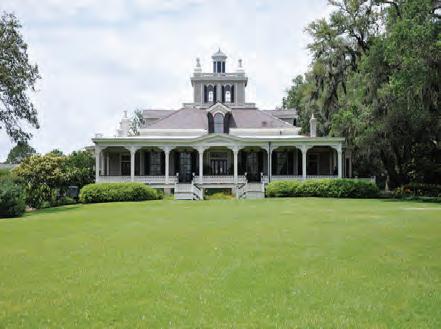
JULY
July 1 – The Cast

July 8 – Ronny Sonnier Yesterday’s Hits
July 15 – Kip Sonnier
July 22 – Matthew Ewing and the All Star Band
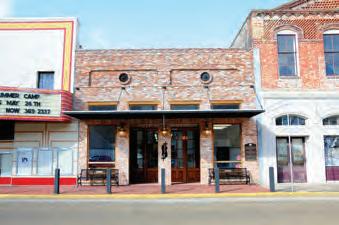
July 29 – Straight Whiskey Band
AUGUST
August 5 – The Envies


August 12 – Kip Sonnier

August 19 – The Cast
August 26 – Loose Change Band
SEPTEMBER
Sept 2 – Matthew Ewing and the All Star Band
Sept 3 – Basin Boogey Man
OCTOBER
Oct 28 – Bad Boys Band – 7:00-10:00pm
Bands play 6:00-9:00pm, unless otherwise specified.
JUL 23 // COUNTRYROADSMAG.COM 50
Visit Tabasco and Jungle Gardens Avery Island, Jefferson Island Rip Van Winkle Gardens, Shadows-on-the-Teche, KONRIKO Rice Mill, Bayou Teche and Jeanerette Museum(s), and stroll the New Iberia Historic District. Enjoy dining, history, outdoor beauty, as you Savor the Difference in Iberia Parish.
LIVE MUSIC AT THE ISLE OF IBERIA RV PARK & RESORT!
Iberia Parish
& Visitors
2513 Hwy. 14, New Iberia, LA 70560 888-942-3742 • IberiaTravel.com
Convention
Bureau
pack, prepare for your staycation.
Plan,
71st Annual Delcambre Shrimp Festival Delcambre, LA
August 16-20 IberiaTravel.com/ShrimpFest
For a time, the two main distributors of the product in Louisiana were in fact Floyd’s Record Shop and Guillory Wholesale—who were each selling the things by the truckload. The often-repeated oral history claims that the sales reached such monumental heights as to make Louisiana, and Evangeline Parish specifically, the site of the single largest distribution of Hitachi rice cookers outside of Asia. Per local lore, to better understand this phenomenon, executives from Hitachi Corporation in Japan flew to Evangeline Parish to see it for themselves. “They visited Ville Platte and Mamou and all that, thanking us for selling their product,” said Soileau. “They couldn’t believe the amount of—‘steamers’ they called them—that we were selling. They came here to thank us for that. They had to air freight them into Louisiana. They never expected that. They didn’t know what the hell was going on.”
Paul Guillory confirms this, recalling that the executives were actually attending a trade show in New Orleans, and had rented a car to visit Evangeline Parish to figure out why this tiny rural area had such a fierce demand for the cookers. Of course, when they drove the roads leading into Evangeline, the seemingly-infinite fields of rice would have delivered as quick an answer as any. Photographs from Paul’s family archive document the executives’ meeting with his parents, Bruce and Gladys
seated with the suited Japanese men at their kitchen table right at the center of a quintessentially 70s-style kitchen, sipping coffee.
The Louisiana market purportedly had its role in the appliance’s evolution, as well. Paul and Soileau each recall that a change to the product was suggested to manufacturers that would make it less reactive to the amount of salt Louisianans tended to add to their rice. “We told them to change that,” said Soileau, “and they did.”

And then there was the matter of size. Originally the cookers came in threecup, five-cup, and eight-cup options. “We needed a ten-cup,” said Soileau. “And then later they came up with even larger ones for restaurants.”
Eventually, the area's big box stores got wind of the product’s popularity, and Hitachi rice cookers became available everywhere. Guillory Wholesale kept a healthy stock going at the small shops across the region, but Soileau— frustrated that Hitachi was going to stop using him as a main distributor and sell directly to the department stores—quit selling them. “I spent all this money helping you get this program set up, and now you’re going to cut me out? Nah, that was it,” he said.
By that point, though, the Hitachi rice cookers had become a ubiquitous part of the landscape. People could hardly remember cooking rice any other way.
The Enduring Legacy
In 2023, Hitachi still sells rice cookers, but these robot-esque multi-setting $100+ products are rarely found in Acadiana, and hardly resemble their predecessors at all.
Still, the idea of the rice cooker as a kitchen necessity has not dwindled here. When I went off to college, I purchased my own three-cupper and packed it up with my toaster and my microwave. Rice is still a staple in Acadiana’s small towns, and this is how you cook it.
And even I, born at the end of the millennium, know exactly what a 1970s Hitachi rice cooker looks like, and I can place it on my grandmother’s counter— from which we served ourselves so many gumbos and gravies. And like most of the others, still steaming in Cajun and Creole kitchens for miles ‘round, it still works just fine.
“It’s one of those things where, as an adult, it’s like—wait how do I get one of those?” said Mamou-raised, Lafayette-based photographer and filmmaker Lucius Fontenot. “They’re always around.”
Inspired after inheriting his grandmother’s avocado green cooker and photographing it, Fontenot found himself drawn into the enduring legacy of the cooker—discovering how many people he knew still had them and had intense memories associated with them. “It’s interesting, the idea that the mention of this appliance throughout South Louisi-
ana, would cause people to get really nostalgic and go into these really sentimental stories. People remember that thing very fondly . . . there’s a respect for it—sort of this weird adoration for this artifact.”
His ongoing Hitachi Rice Cooker project features photographs of cookers still in operation in kitchens across Acadiana, combined with interviews of their current owners—altogether forming a tapestry of Acadiana’s culinary history centered around this little Japanese invention, which is now as thoroughly Louisianan as corner store boudin, or gravy on rice.
It was like the dinner bell—‘Come serve yourself a plate!’
 —Kirstie Cornell
—Kirstie Cornell
My cooker has been with me for more than thirty years—it outlasted my marriage, and has fed me in a way that goes beyond bringing rice to the table. —Sarah
Spell

In the back shed, we found two Hitachi rice makers, still in the boxes. I said, ‘That’s mine!’ I think we kept the other one in the box just in case someone’s breaks or dies. The other brands of rice cookers just don’t work right. They don’t have the ‘ding!’" —Rachel
DeCuir

“I mean,” laughed Fontenot, “when I was a kid, I thought Hitachi was a French word.” •

//JUL 23 51
Surviving the Clotilda
IN MOBILE, ALABAMA, THE NEW AFRICATOWN HERITAGE MUSEUM HONORS THE COMMUNITY BUILT BY THE SURVIVORS OF AMERICA’S LAST SLAVE SHIP
By Cheré Coen
In 1860, it had been illegal to import enslaved Africans into the United States for over fifty years, but the Navy’s enforcement of the ban didn’t stop a steady stream of smugglers from bringing more enslaved people to Southern shores. The federal punishment for the crime was severe, but Mobile shipyard and mill owner Timothy Meaher allegedly made a bet for $1,000 that Southern lawbreakers would never be reprimanded, bragging that he himself could bring enslaved Africans into Alabama with no repercussions.
“Meaher’s response is not recorded, but the case would have been easy to make,” writes Nick Tabor in the book Africatown: America’s Last Slave Ship and The Community It Created . “To begin with, what Southern jury would convict a man for importing Africans? White southerners, even poor ones, had come to associate the expansion of slavery with general economic growth and prosperity.”
Meaher set out to fulfill his promise. He enlisted the aid of shipbuilder and captain William Foster. In March 1860, Foster boarded his two-masted schooner Clotilda with a crew and a bag filled with Meaher’s gold.
“They (Foster and crew) would sail down the winding Chickasaw Creek, into the delta, where it met the Mobile River, down the chute into Mobile Bay, past the wooded Dauphin Island, and into the Gulf of Mexico,” Tabor writes. “According to one version of the story, their papers said they were hauling lumber to St. Thomas, in the Danish Virgin Islands. But the ultimate route on Foster’s maps was for Africa.”
Foster returned to Alabama with 110 enslaved African men, women and children from Dahomey (today, Southern Benin) onboard the Clotilda . Upon arrival, Foster destroyed the evidence by stacking the Clotilda with firewood and setting her ablaze, left to sink into a muddy section of the Mobile Delta.
Although word got out of the brazenly unlawful importation, and an investigation followed, no action was ever taken by the United States government against Meaher and Foster.
Meaher was right, after all. And the Clotilda became America’s last slave ship.
Africatown
After arriving on American soil in May 1860, the captives onboard the Clotilda were sold to area plantation owners or relegated to work on the Meaher property. They stood out beside most of Alabama’s other enslaved people—who had at this point spent decades assimilating to the new world, or had been born here. These newcomers mainly kept to themselves, and occasionally resisted their captivity.
“…there were limits to what they put up with,” Tabor writes. “At least twice the men ganged up on Americans who tried to use violence against the African women.”
Five years after their arrival, the Civil War ended and these last enslaved Africans were freed. A group of them approached Foster with money saved from post-war earnings and
said Jeremy Ellis, a descendant of Clotilda survivors Pollee and Rose Allen. “Look at what they achieved in those ten years from early freedom to 1874. To me, that’s monumental. They showed their resiliency in 1865.”
For many years, Africatown thrived despite the challenges of Jim Crowe laws and segregation. Community leaders such as Oluale Kossola, who later became known as Cudjo Lewis, married and raised a family. His story and those of the other Africans would have become lost to time except for journalists occasionally writing of the town over the course of its history, and for novelist Zora Neale Hurston’s interview of Lewis for her book Barracoon , which was published posthumously in 2018.
Ben Raines, a reporter for the Mobile Press-Register and a charter boat
now protects the Clotilda and related artifacts—and the History Museum of Mobile, which curated the exhibition and will operate Africatown Heritage House going forward.
“There’s something powerful about being in the presence of those objects,” said Dr. Meg McCrummen Fowler, director of History Museum of Mobile. “It both shows the horrors of slavery and makes the history palpable.” McCrummen Fowler insisted, however, that the multi-sensory exhibit of photos and texts remains focused on the people of Africatown.
Clotilda:The Exhibition uses early 20th century interviews of the Africatown residents and highlights the diverse languages, cultures, and religions of the community’s residents.
“It’s really so remarkable that we have those sources,” McCrummen Fowler said of the interviews. “To have someone alive in the 20th century who remembers his life in Africa is just remarkable.”
Ellis agrees that the center of attention should remain on the 110 enslaved Africans forced to Alabama and the descendants who keep their memory alive today.
asked to be returned home. Foster refused, claiming that their savings would not cover expenses.
Disheartened but not discouraged, the group vowed to save enough to purchase land and start their own community in South Alabama. By 1870, they purchased acreage on what would become the Mobile neighborhood Lewis Quarters. Two years later, another group from the Clotilda bought adjacent land that would become the neighborhood of Plateau. They built churches and homes and eventually a school—establishing their own self-sustaining community where they could speak their own languages and continue their traditions in this strange world. The broader community, located three miles north of downtown Mobile, became known as Africa Town, later shortened by locals to Africatown.
“What makes this story so significant is what they achieved after 1865,”
captain, had heard the stories for years. In 2017, he began searching the waters and discovered what he believed to be America’s last slave ship buried in the Mobile River mud near Twelve Mile Island. After extensive research and exploration by archaeologists and historians, in the spring of 2019 National Geographic broke the news that the Clotilda had been found.
The Heritage House
On July 8, the Africatown Heritage House opens in the historic Mobile community with the exhibit Clotilda: The Exhibition. The date marks the anniversary of the Clotilda’s return to Mobile, and the arrival of its survivors, 163 years ago.
The 2,500-square-foot museum was built by the Mobile County Commission in collaboration with the Alabama Historical Commission—which led the authentication process and
“Prior to the discovery of the Clotilda , there were descendants telling the story of the 110 slaves aboard the Clotilda and the founding of Africatown,” said Ellis, whose grandmother Beatrice Ellis was, for a time, the president of the Africatown Direct Descendants of the Clotilda . “It’s extremely important that descendants tell the story and control the narrative. And that’s what the exhibit will do.”
Ellis hopes the museum and exhibition will also bring awareness to modern-day Africatown, which has seen a decades-long decline since several industries moved in and the Bay Bridge Road cut the community in two. “It’s a community that needs revitalizing,” he said. “Justice is still needed for the crimes that were committed.”
McCrummen Fowler reiterated the fact that there is still more to learn about this history and the experience of Africatown’s founders. “Our hope is that the world’s focus on Africatown will result in tangible progress,” she said. •
JUL 23 // COUNTRYROADSMAG.COM 52
MUSEUMS
“THERE’S SOMETHING POWERFUL ABOUT BEING IN THE PRESENCE OF THOSE OBJECTS. IT BOTH SHOWS THE HORRORS OF SLAVERY AND MAKES THE HISTORY PALPABLE.”
—DR. MEG MCCRUMMEN FOWLER
The Africatown Heritage Museum opens July 8 in Mobile, Alabama. The museum has limited capacity, so advance tickets are recommended. For more information, visit clotilda.com.
SUMMERTIME BLUES
We Let Summer Come to Us
MAKING PEACE WITH LOUISIANA'S SWELTER

 By Ed Cullen
By Ed Cullen
In need of a break from mowing, I lower myself into one of those plastic Adirondack-style chairs—this one’s lime green—to rest in the shade of a mutant Meyer’s lemon tree.
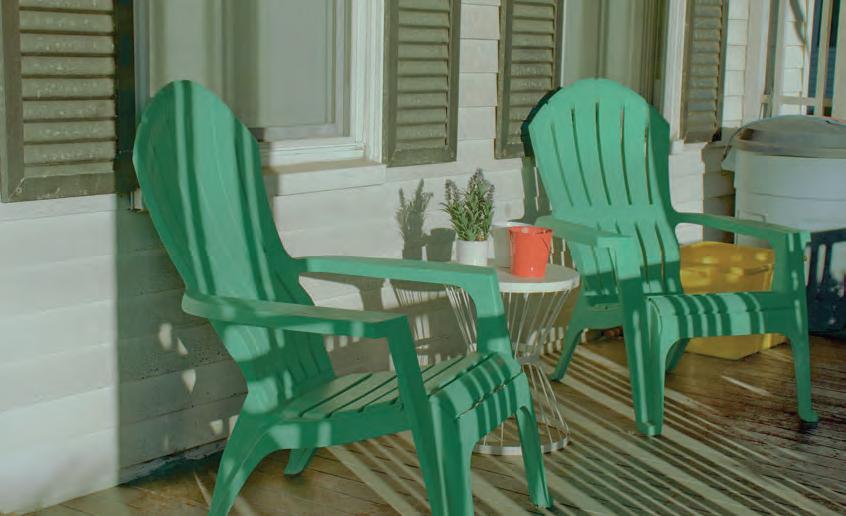
The sounds of summer arrived on the breeze. The street’s a little quieter as gasoline mowers yield, slowly, to electric. There are still the bursts of jet engine noise from blowers as their operators blast cut grass—and dust—into the street and storm drains.
Unlike fall, which we step into lively and eager to embrace the cool air, summer days we approach as we would a dog we’re not sure is friendly. We let summer come to us.
Children are back on the street. Once, there were twenty-one children on our street, from teenagers to babes in arms. The herd of children would break off into ones and twos to run from house to house, pausing to knock before pushing open unlocked doors.
There were fewer fences. Children ran parallel to the street across lush grass that cushioned falls. I quit using pesticides the first time I saw a child stop at my garden, help himself to a cherry tomato, and rush on.
A boy who lives a few doors up the street escapes the gravity of his driveway in a battery-powered car from time to time. I see him headed my way and think of Stuart Little, E.B. White’s adventurous mouse.
“I need help,” the boy announced the other day. His car’s battery needed charging. The car was moving so slowly it was being passed by crawling bugs. I pushed my neighbor up the street and left him in his driveway as his mother advanced. Escape thwarted.
Though I grew up in the days before air conditioning—endured the oppressive, wet heat of offshore Vietnam and work outside every day—as I’ve grown older, I’ve begun to make my peace with summer.
I ignore television weather persons who delight in forecasting “another day of heat and high humidity” to viewers who walk from air-conditioned houses to air-condi tioned cars to drive to air-conditioned offices. In the COVID time, weather forecast ers were telling people who no longer went outside that if they did it would be sum mer.
When weather people issue hot air cautions after May 1, I am not surprised. I don’t panic. I know there’s the chance that early mornings will be soft with small breezes, a good time to meditate while holding one end of a watering wand.
Rather than write off three or four months of the year, I have learned to move slow ly, dress for the tropics, drink water through the day and work outside in brief stints. When I come up with a remedy for the true bane of summer—mosquitoes—I’ll let you know.
Our daily lives change slowly, more slowly than the rapid change we see forecast in the twenty-four-hour news cycle. As I write in a room with two desks, the desk to my left harbors the reality of switching from gasoline machines for lawn work to bat tery-powered. Quietly, with no smell, batteries are charging, their small green, yellow, and red lights reporting their states of readiness.
When I go out to work, I put a couple of batteries in my pants pockets to run the lawn mower, the string trimmer and the blower. I use a grass catcher to feed an insa tiable compost pit. I work a small city plot with my mind at an imaginary place on the side of a hill above a pond fringed by woods.
I would live in a solar house and draw water from a well if I could. I content my self with composting, tending a vegetable garden and mowing the grass to a hum in stead of a howl. It is enough to make peace with summer and let my mind live off the grid. •
Saturday, July 15 from 3-5pm

East BatonRouge Parish Main Library on Goodwood Blvd

The event is free, but space is limited. RSVP at www.lpb.org/southernstorytellers.


And don’t miss the 3-PART SERIES beginning Tuesday, July 18 at 8PM
For exclusive content from storytellers, follow on Instagram @SouthernStorytellersPBS or just scan the QR Code.
www.lpb.org

//JUL 23 53
LPB and the East Baton Rouge Parish Library bring together some of Louisiana’s most notable storytellers.
The Secret Life of Food
CLARE CRESPO USES CUISINE AS THE CONNECTIVE TISSUE IN HER DIVERSE BODY OF ARTWORK
By Sonny Marks
Clare Crespo’s “Hurray Today” calendar hangs on my kitchen wall. I’ve been buying her calendar collections, and saving them, for several years. When we were high school seniors in Baton Rouge, I remember that she wore an eyeball ring on her hand, and that her mother made a fuss of her distaste for it.
Unlike any other calendar I’ve ever had, the months are loose from one another, held together only by a colorful binder clip. The pages are 13”x17”, on 100# Pacesetter Silk Text White. Each year’s “Hurray Today” calendar has a different food-adjacent theme. Last year’s featured illustrations of beverages. This year’s theme is vegetables. Eat the rainbow, as they say.
For January’s page this year, Crespo drew cabbage, black eyed peas, and chili peppers in the symmetry of a mandala. The date markers are hand drawn, and she includes traditional holidays along with the occasional TGIF, meteor shower, Dolly Parton’s birthday, and “Have a hot chocolate.”
Sold all across the globe—including

at the Museum of Contemporary Art in Los Angeles and the Ogden Museum of Art in New Orleans—the calendar is but one small part of Crespo’s diverse body of creative work. Her creations range from a life-sized giraffe sculpture for the window display at Studio Shamshiri on Madison Avenue to the green, fuzzy mascot of the now-defunct clothing brand Entireworld, which appeared in a series of short films with Kirsten Dunst. Through collaborations with Los Angeles ceramicist Heather Levine, Crespo developed a line of dinner ware, as well as a collection of flower vases painted with lesser-known pollinators. The series, titled Unsung Pollinators sold out in no time at all.
Though she now calls Los Angeles home, Crespo grew up in Baton Rouge, the daughter of late LSU art professor Michael Crespo and interior designer Helaine Moyse. The fall after she graduated from Episcopal High in 1986, we started college together at Trinity University in San Antonio—where she majored in communication and minored in painting. She spent the fall semester
of her junior year studying in Italy. She loved it to the point that she burned her plane ticket home.

Her last semester at Trinity, she took a painting class, where she started creating things in motion: “cars driving, animals swirling, stuff like that,” she said. Her plan after graduation was to return to Baton Rouge to work at WRBT-TV, then Baton Rouge’s NBC affiliate, where she had painted weather maps. But when her art professor, the late Robert Tiemann, asked her what she really wanted to do—she couldn’t get the moving art out of her mind.
Crespo told Tiemann she imagined her paintings moving. She thought that was weird, and wondered how it connected to her future. The professor told her, “If you’ll allow me to translate what you just said, I think you want to be an animator.”
“The clouds parted,” Crespo recalled. Tiemann encouraged her to apply to grad school, late in the process. She got admitted into the California Institute of the Arts “by the skin of my teeth.”
At CalArts, she made friends with classmates such as Stephen Hillen-

JUL 23 // COUNTRYROADSMAG.COM 54 IS IT CAKE?
In Crespo's books The Secret Life of Food and Hey There, Cupcake!, she plays with food art, offering fun recipes to make dishes that look like other dishes. Here are cupcakes that look like eggs, and on the opposite page, you'll see a cupcake that looks like a hamburger.
She also "plays with food" in her 2015 installation of a crocheted Louisiana feast. Photos courtesy of Crespo.
burg, who went on to create SpongeBob SquarePants. She played bass in a band with Beck David Hansen. When Beck made his video for “Loser” in 1994, Cres po was in it.
She completed her MFA and found her niche producing music videos in L.A.— climbing her way up to the position of executive producer at The Directors Bu reau, and later at Satellite Films. In 2000, though, she left that career to pursue a new dream—a cooking show for chil dren. The concept combined Crespo’s creativity with her love of sharing food.
She started with a website, hoping that would turn into a show, but instead it be came a book. The Secret Life of Food published by Disney-Hyperion in 2002 as a collection of recipes and photographs transforming easy-to-make dishes into everyday items that do not look like what we know to be food. It included a Jell-O aquarium with Swedish fish, Anatomical Heart Cookies, and Sushi Cupcakes. The book sold well enough to have multiple printings, with features on the Food Net work and Good Morning America. Her next book Hey There, Cupcake! came out two years later, keeping the concept going with recipes for cupcakes that look like burgers, clocks, and panda bears.

Crespo realized food could be a language to communicate her visual art to general audiences. In her garage in the Silver Lake neighborhood of Los Angeles, she created the Yummyfun Kooking Show —which was quickly picked up


by multinational production company Fremantle. The show featured Crespo as Yummy Clare alongside puppet friends, and guests the likes of John C. Reilly.


When Crespo creates with food, it can also be a way for her to express her deepheld connection to the food culture she grew up in. An example is the crocheted sculptural feast of Louisiana foods she orchestrated for a show at the Health Ce-






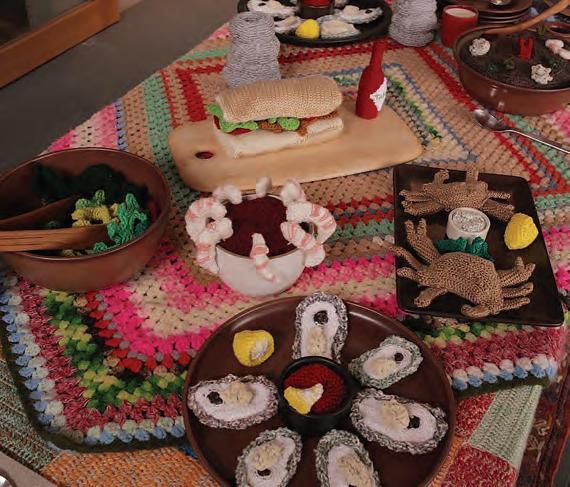
ramics showroom in Los Angeles during Mardi Gras—which later traveled to New Orleans as part of the Prospect 3 Tri ennial in 2015. “I feel,” she said, “like I am often sending homesick love letters to my home state.”

So, what is she working on now, you might ask? The 2024 “Hurray Today” calendar, naturally. • clarecrespo.com



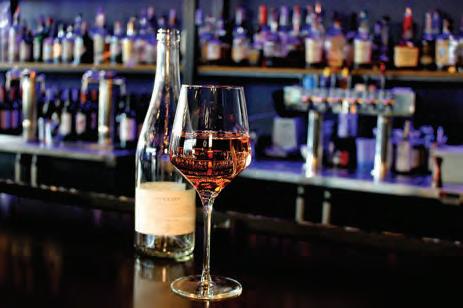


we have a Restaurant for Every Occasion. Welcome to Baton Rouge! View Menus Celebrate the flavors of louIsIANA
Gris Gris
REMEMBERING BATON ROUGE'S EDGIEST ALT-WEEKLY, FIFTY YEARS LATER
 By Teddy McGehee
By Teddy McGehee
What was it about Gris Gris, the alternative magazine that took Baton Rouge by storm in the seventies? Edgy, fun and full of witty articles covering political gun battles and burgeoning nightlife, with avant-garde cover stories—it was a zephyr of fresh air in the occasionally uptight Capital City. America had just exited the Vietnam War and baby boomers (even though that name wasn’t being bandied about then) were hungry for things. They were an eager, emerging generation. And in Baton Rouge, Gris Gris was their voice. Nationally, Rolling Stone was a force, but don’t forget New York’s Village Voice, Philadelphia’s Distant Drummer and the Vieux Carré Courier in New Orleans. Many cities had them. Ours began at LSU’s Student Union, where four students whittled down a list of variations on “Red Stick” and other ridiculous names until there was only one left: “Gris Gris”. While eating a Chinese Inn supper of Moo Goo Gai Pan and egg rolls, the fearless four had decided to launch an alternative newspaper. The group included: John Maginnis, who had been the editor of the LSU Reveille in the spring of ‘69 and just returned from a Navy stint in the Philippines; wordsmith Charlie East, the 1971 Reveille editor who had scored a gig reporting at the Times-Picayune; Jim Gabour, the beefy, bearded hippie with the military chops, newspaper family, and hip experiences from all over the world; and Jodie Cado, a brassy teenager out of Pearl River, the Stevie Nicks of the quartet who couldn’t wait to influence a young audience and see her name on the masthead. It was official. The first bi-weekly issue would publish July 4, 1973.
“You just had daily newspapers,” Maginnis told Melissa Eastin, a senior EBR library archivist who interviewed him shortly before his death ten years ago.
“You didn’t have city magazines or anyone who could do long-form journalism. We could delve into stories. Few people wrote like that. They do now. There was an opening for Gris Gris to really tell personal stories, go more in-depth and get different angles.”
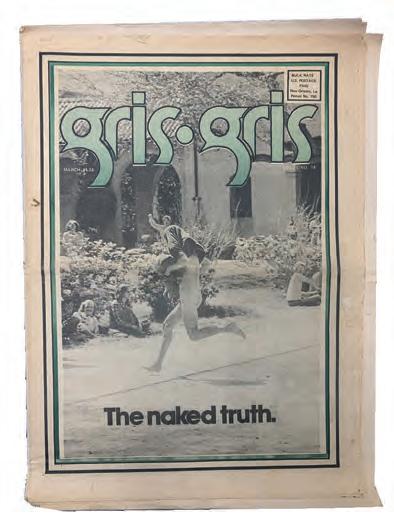

The first issue, twelve pages in total, featured Jim Downey’s art direction and East’s in-depth report (“the porno too hot to handle”) on why the Varsity and Regina movie theaters refused to show the much-ballyhooed porn flick Deep Throat. The cover story was a Jim Gabour piece on the blues scene in Baton Rouge headlined “Jukin’ in Baton Rouge.” It included book reviews by Morris Lewis Witten; record reviews by Patrick Berry, Jimmy Beyer, and Michael Moore; and a punchy piece on LSU politics by Maginnis.
With four years on Maginnis and East, Gabour brought a worldly flavor to Gris Gris. He was a beat poet, artist, and glibtongued hipster—all of which fueled his Hunter Thompson-like rants. His tough Texas upbringing and three years serving in the Korean War gave him a reputation for fearlessness, always ready for a love-in or a barroom brawl—take your pick. The team worked out of a two-story building in Beauregard Town and, later, another on State Street. Cado—wearing various hats and titles over the years as Business Manager, Associate Editor, and Secretary/Treasurer— was the scotch tape and chewing gum holding the paper together. More than just the “hippie girl,” as Edwin Edwards once called her, she was skilled in selling ads and savvy at brainstorming story ideas. She was the paste-up queen who ramrodded the biweekly madness, the putting to bed of a masterpiece, or at least a magazine with a modicum of mistakes.Moreover, she was tough as nails, raised by a marine sergeant dad who stormed every beach on the Pacific.
Ensuing issues hit Baton Rouge like a tidal wave and the publication doubled in size and readership in just two years. Reach expanded, too—with Frank Hall selling ads in New Orleans and Jim Burk in Lafayette. The clever Gris Gris motto “Covers Baton Rouge like the Dieux” debuted in ‘74, as did the streaking issue: the cover marquis ringing out “The Naked Truth”.
Early articles delved into the machinations of such influencers as Edwin Edwards, Mayor Woody Dumas, East Baton Rouge Parish Sheriff Al Amiss, Judge Leander Perez of Plaquemine Parish, white supremacist David Duke, Speaker of the House Bubba Henry, and LSU Football coach Charlie McClendon. Riding on the coattails of popular stories describing the Destrehan ferry incident and the Tongsung Park scandal, the magazine also shimmered with Gabor’s acid-fueled column, Bruce MacMurdo’s sports reporting, and Maginnis’s coverage of Louisiana’s deliciously fraught political landscape.
Going behind the scenes with politicians like Edwin Edwards was Maginnis’s forte (he wrote two books about him). He was funny, glib, and never missed a single legislative crawfish boil. His July 27–August 2, 1976 “Best and Worst Legislators” cover story, cowritten with Sandy Branch, was complimented in the archive by Ray Teddlie’s “Ten Best- and Worst-Dressed Men in Baton Rouge” (written under his nom de plume, Addison deWitt, the name of the snotty play reviewer in the movie All About Eve)— for which Teddlie once wrote that legislator Clyde Vidrine’s sports coat “looked like the fabric had been ripped screaming from the back set of a ‘57 Chevy.” The paper ran pieces on the Teamster’s Ed Partin, former governor John McKeithen, Woody Jenkins, and legislators like Shady Wall. Also under the microscope were Advocate Publisher Doug Manship,
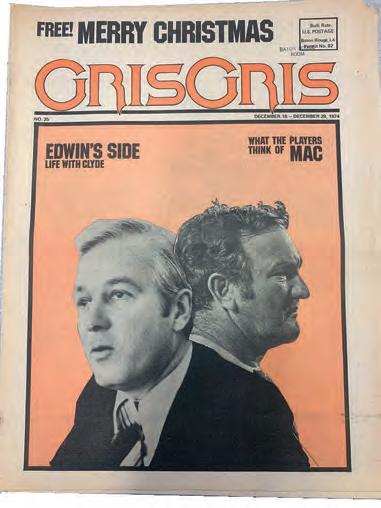
businessman Shelly Beychok, and Edwards’s cozy relationship with Texaco.
Great features flowed, with photographic coverage of the Atchafalaya Basin with C.C. Lockwood and features on the mysteries surrounding New Orleans godfather Carlos Marcello and Baton Rouge businessman Jules LeBlanc.
Concerts were a big deal of course; Leon Russell, Bob Dylan, and the Allman Brothers shared the Gris Gris spotlight with mime Marcel Marceau and Willie Nelson’s Second Annual 4th of July Picnic. Entertainment writers Del Moon and Eddy Allman (the Revues Brothers, otherwise known as “Delwood” and “Juke”) were all too happy to cover the action. Local entertainers featured in Gris Gris’s pages included Marsha Ball, The Meters, Iscoceles Popsicle, Pot Liquor, Bayou Blues Band, and Irma Thomas. Maginnis described the music scene coverage as equally significant to the magazine’s news stories: “That’s what we did when we were out at night. We went to Cahoot’s, Uncle Earl’s, and the Kingfish. It was the sexual revolution and a great time for music in Baton Rouge with John Fred and the Playboys and a lot of other bands.”
All of it was tied together by splashy covers by talented local artists like Joe Disney, Stan Taylor, and Anna Macedo. WJBO Loose Radio was buying full page ads, and others followed suit. Didee’s, The General Store, and Leisure Landing Records & Tapes on Chimes Street advertised—also Caterie, J Western Store, and White Horse, as well as movie theaters like Bon Marche Twin, Paramount, Gordon, Hart, and the drive-in on Airline. Some of Baton Rouge’s best remembered businesses advertised, including Capital Bank, New Generation, and Jake Staple’s. Then there were the bars: Cotton Club, Thirsty Tiger, The Kingfish, Brass Rail, and Patio Lounge.
JUL 23 // COUNTRYROADSMAG.COM 56 TABLOID
By 1975, the year of the first iconic bagasse cover, Steve and Layne May arrived and gave Gris Gris a boost with fresh energy, starting in as business manager and production manager, respectively. Teddlie’s cover story, “Baton Rouge After Dark,” published under the DeWitt name, outdid itself. Writer Ruth Laney was appearing on the masthead, along with Peggy Garvey, Melissa Toler and Anne Baldridge; and photographers Kent Lowe, Bob Ball, and Tom Tumlin.

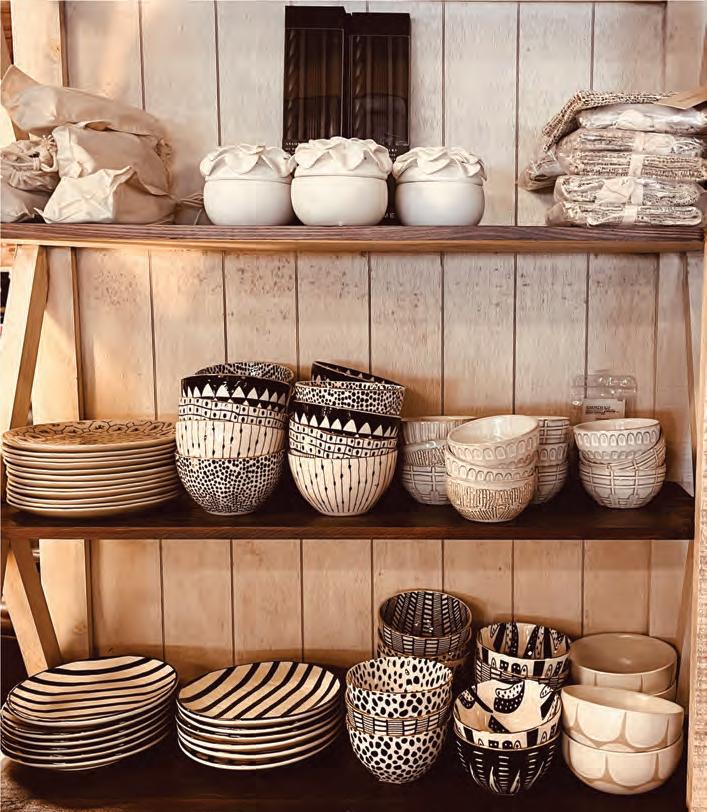

From the beginning, Maginnis’s column “Ratta Tat Tat” sealed Gris Gris’s enduring reputation as publishing the best, most-connected political writing in Baton Rouge history. Former Louisiana Legislator and Speaker of the House Frank Scimineaux and U.S. Sen. Henson Moore recently commented on Maginnis’s integrity as a writer. “John Maginnis was always fair,” said Scimineaux. His reporting was honest and straightforward.” Walking the dog on University Lakes, Moore described Gris Gris as one-of-akind. “When it came to caustic, or political, writing, [Maginnis] was the best.”

In the words of the late Maginnis, they “lived and breathed it.” He said, “There was a kind of printing revolution at the time regarding production—the days of old hot type and linotype machines were numbered. Cold type allowed alternative newspapers to spawn across the country. The production phase became so much easier, something you could do in a living room.”
Through the seventies, Gris Gris kept on growing—the advertisers continuing to pour in: Wilson Jewelers, POETS, C. J. Brown, The Bengal, The Varsity Shop, Art Colley’s Audio Specialties, Jules Madere, RFD, GN Gonzales, Louisiana National Bank, and Sans Souci—a huge allnight joint across the river—just to name a few.
In 1978, Maginnis and Cado broke off to focus on their new weekly, The Baton Rouge Enterprise, published for six years with Rolfe McCollister, Sr. and Jr. before it evolved into the Baton Rouge Business Report. They sold their interest in the paper to journalist Philip Carter of New Orleans, but after they had gone, things were never the same. In December 1979, Gris Gris ran its last edition until a brief revival from 1985–1991, when Gris Gris went away again, this time forever.
After that, Maginnis wrote political columns for various newspapers and magazines around the state while Cado produced artwork for ad agencies. East himself was well-established by that time at the storied Weill-Strother Ad agency, where he worked side-by-side with great political talents like James Carville and Roy Fletcher. Gabour went on to become a professor at Loyola University—where he founded the school’s BFA in Digital Filmmaking, a Grammy-nominated filmmaker in his own right, and a novelist.
When you thumb through the old issues under lockdown at the East Baton Rouge Parish Main Library, the brown flakes around the edges of some pages break off into a confetti. “People were waiting for Gris Gris to come out,” remembered Maginnis, “to see what we would print next. •

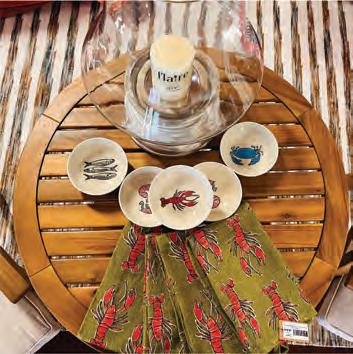
Flip through the Gris Gris archive yourself by making an appointment with the East Baton Rouge Parish Library's Special Collections Department, or find it in digital form at eastbatonrouge. advantage-preservation.com.



//JUL 23 57
Escapes
There's Something in the Water
A FOODIE'S GUIDE TO THE MISSISSIPPI GULF COAST

 Story and photos by Jordan LaHaye Fontenot
Story and photos by Jordan LaHaye Fontenot
Recently, on a trip to Biloxi, my brother joked that the town has more Waffle Houses per capita than anywhere else he’d been—that after a night spent losing money somewhere on the infamous Strip, you couldn’t help but end up at a Waffle House the next morning. His theory was ultimately proven wrong, when after walking to the franchise location across the street from the Beau Rivage in our haggard and hungover states, we were all but turned away at the door; the place packed to bursting. It was a busy weekend on the Coast, with two festivals and gorgeous weather, and we spent the next three hours or so searching for a parking spot in downtown Ocean Springs, angling toward the bottomless mimosas and crab cake Benedict at Blue Dog Bistro. Instead, we landed upstairs at a place called “Rooftop Taco & Tequila Bar”—which had the look of a nightclub rubbing its eyes in the morning, and no air conditioning. Instead of mimosas we settled for margaritas, served in a tower that came leaking so badly the waitress wordlessly brought us another pitcher to compensate. And I swear, I had the best birria taco I have ever tasted. My husband said the bang bang shrimp was even better.
The fact is, it's hard to go wrong when eating in "America's Riviera". This storied strip of coast is soaked in a legacy of indulgence, which is built largely upon the riches of its waters and its soils—a bounty that has inspired artists, entrepreneurs, and chefs for hundreds of years, and received interpretations by its Native, French, Spanish, and Southern American residents. As indicated by the last three years of Country Roads' Small Town Chefs' Awards—which have each featured a different Gulf Coast chef—and an onslaught of new concepts opening up from Bay St. Louis to Pascagoula, we've long had an inkling that there's something delicious in the water. I recommend leaving Waffle House as the ultimate last resort. If you do things right, you'll never land there.
Start on the Water
Whatever your reasons for being on the Coast, you should always start with a view of the water. There are no shortage of options, but if you’re in Biloxi—I say head straight to Beach Boulevard, where a lively set of quintessentially-funky waterside joints jut out gaudily on their stilts.
There’s Fat Bottom BBQ, Lucy’s Retired Surfers’ Bar & Grill, and The Reef—but I opted for Shaggy’s, a local chain owned by fishing buddies Ron Ladner and Rimmer Covington, Jr., who transformed a Hurricane Katrina-ravaged local bait shop in Pass Christian into the first iteration of their beloved Key West-style beer and burger joint.
I was set up waterside on the open-air porch, which sprawls and twists with multiple seating areas and bars. At lunchtime on a Monday, it wasn’t particularly crowded, but you could imagine the place gets rowdy at night. The beach was dotted with colored chairs and umbrellas, and a breeze carried the sounds of seagulls right to my table. I smiled to realize the menu included a section
JUL 23 // COUNTRYROADSMAG.COM 58 COASTAL CUISINE JULY 2023
FOOD TOUR
The Gnocchi with Spicy Vodka and Grana Padano at Radish in Long Beach.
Photo courtesy of Lauren Joffrion.
for “Good Dogs”—featuring a “Hot Diggity Dog” (a beef hot dog, diced) a “Puppy Patty” (a burger patty), a “Bird Dog” (grilled chicken and steamed rice, for those watching their figure), and ice cream flavors of the day.
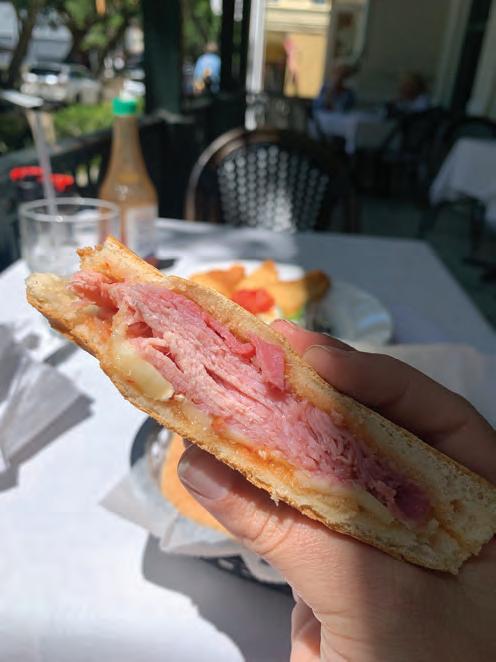
Per my waitress's recommendation, I ordered the Mahi Mahi tacos—teriyaki-glazed with pineapple pico and honey-lime slaw, paired with a Mango Cart Wheat. “You’re gonna love this,” my food runner assured me when he set down my plate. He wasn’t wrong.

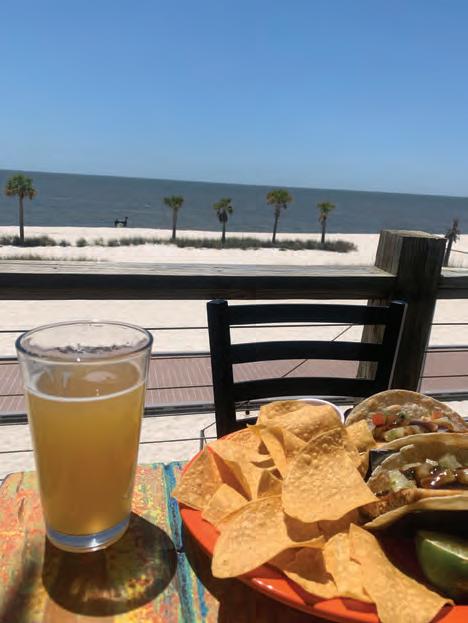
Afterwards, I walked down the stairs in the back straight onto the beach, where a downstairs patio and brightly-colored Adirondacks offered a scenic spot for sipping one of the menu’s many colorful “Beach Drinks” (the “porch rocker” would be especially appropriate), as well as cornhole and Jenga sets. The impressive West Beach Boardwalk—part of a bigger initiative by the City of Biloxi and Harrison County to make the beach more accessible—passes right here, and offers a pleasant walk along the beach and a chance to orient oneself with the rhythms of the Gulf.
For an altogether different waterside view, cross the bridge into Ocean Springs, where the Nicaud Restaurant Group (known for restaurants like steakhouse and oyster bars Field’s and Charred, as well as dozens of other eateries in the area) just opened up the newest iteration of its local Bacchus chain, Bacchus on the Bayou, in March. Extensive renovations to the old Marina Cantina on Old Fort Bayou unveil a playful, water-themed interior—with hand-painted rivulets on the entryway’s floors, and an immersive mural of an underwater reef complete with a mermaid holding a traditional New Orleans Mardi Gras Bacchus parade throw—in the party room.
The outside deck is made for sunsets, sleek with green turf and white furniture—grand water oak branches gesturing above it all. The Bayou shimmers, and a long dock puts you right in the middle of it (you can
also park your boat here, if you’re coming straight from the water). The menu is meant to be a play on Cajun cuisine, of which I am typically skeptical when away from home. But a quick history lesson on Biloxi quickly quells this hesitation: the Cajuns have been living here since 1914, drawn straight from Louisiana by the promise of the oyster industry, bringing their joie de vivre and culinary traditions with them.
The oyster combo—with char-baked, Rockefeller, and “jackpot” (spicy butter, cheddar, jalapeño, and bacon) varieties—disappeared before my eyes one savory, buttery bite at a time. Intrigued, I ordered the blue crab melt next—which consisted of a chunky brioche-wrapped package of crab cake smothered in gouda and chipotle mayo. I’m not typically a “fishy” sandwich person, but when blue crab is fresh and prepared just right—well, I don’t have to tell you that there is simply nothing like it.
Over in Gulfport, the Blow Fly Inn has held court on Bayou Bernard since 1955. Now rebranded as the Blow Fly Bar & Grill, the renovated space still has the feel of an off-the-backroads secret, standing camplike on its stilts at the end of a remote parking lot down Washington Avenue. Climb the ramp, winding up around an old oak, at lunchtime, and you’ll be greeted by an airy dining room brightened by the natural light pouring in from the massive bayou-side windows. High industrial ceilings and shining wooden tables gave off a clean, comfortable elegance—energized by the rich scents swirling in from the kitchen. In an homage to the Inn’s old traditions, my blackened Ahi Tuna came stabbed by a toothpick tent adorned with an illustrated blow fly—whose larvae are historically used as fishing bait. The side of brussel sprouts glazed with soy sauce were a treat all their own, but the fish came well-seasoned and perfectly seared—flaking on my fork and melting in my mouth.

//JUL 23 59
at Shaggy's in Biloxi.
Mahi mahi tacos and a Mango Cart Wheat
The French Panini at Ocean Spring's Maison de Lu, a pressed sandwich of ham, brie, and pepper jelly on ciabatta.
JULY 15TH
SEPTEMBER 16TH
OCTOBER 7TH
8AM-4PM

Openatothertimes


byappointment
(318)758-1758

5317Hwy.133/425
OakRidge,Louisiana
www.StarrHomeplace.org
From my seat at the window, across the bayou and over the treetops, I could just make out the top of Flamingo Landing, the poppy, sparkling new bayouside property by New Orleans’ Creole Cuisine Restaurant Group—the newest of a collective of fresh faces joining the old beloved haunts of Saint Bernard (Captain Al’s, for instance, has been serving “the original surf & turf” on the coast since 1993). Flamingo is one of the many spots I couldn’t squeeze into this trip, but it’s at the top of my list for next time—I’ve got my eye on the bronzed Mahi with cotija and grilled pineapple.
Eat Where the Money's At
It’s no secret that much of the Coast’s identity and economy are wrapped up in Biloxi’s claim as the “Las Vegas of the South”. Behind the glitz and the neon, though, are some of the best dining experiences in the region—worth the venture into the wild world of the Strip’s casinos, if only for a taste.
At Harrah’s, there’s Magnolia House, heralded by Louisiana born-and-bred Chef Kelly English—whose accolades include semi-finalist for the 2010 James Beard “Best Chef in America: Southeast” Award for his Memphis eatery Restaurant Iris, as well as the title of “Best New Chef” by Food & Wine magazine in 2009. The seasonal menu includes Southern staples with a Mediterranean zing: sautéed Gulf snapper and parmesan-seared seabass; Tomahawk Pork Chops from the sustainability-focused Niman Ranch, served with a peach compote, Spätzle, and summer peas.

Or, take the elevator up to the thirty-second floor at IP Casino Resort Spa, where Chef Matthew Kallinikos’s Thirty-Two is widely considered the “most romantic spot on the Coast”. Plan ahead to secure a coveted sunset seat, draping the already-breathtaking view of Biloxi’s beach, downtown area, and Back Bay in shades of orange and pink. The “Modern European” menu is full of creatively-prepared, occasionally-daring indulgences, ranging from a generously-endowed Chef’s selection charcuterie board and lobster bisque, to char-grilled octopus and pan-roasted halibut. If you’ve been particularly lucky on the slots, take the opportunity to try the luxury steaks, including a dry-aged wagyu tomahawk ringing in at $155, and a Japanese A5 Strip Loin—considered one of the finest cuts of meat in the world.
The Beau Rivage, MGM’s Biloxi jewel, has long held court over casino dining on the coast. Its reigning favorites, the chic steakhouse BR Prime, the deliciously-entertaining Teppanyaki grill Jia, and the old-world Italian classic Stalla have frequently been named by Forbes and other publications as some of Mississippi’s best restaurants. But the casino’s newest addition, Salt & Ivy, is vying to be included in that number— and has already been voted a “Best New Restaurant” in 2023 by Casino Magazine. Opened in April, the upscale casual restaurant benefits first from its position in the Beau’s grand atrium, sitting airy and fresh beneath the casino’s 65-foot ceilings—offering not only a fine view of the changing art installations (when I was there, it was a tableau of hot air balloons made of flowers, shipped straight from the Bellagio) but also an ideal vantage for people watching. Inspired by its sister restaurant of the same name in Vegas’s ARIA casino, this Salt & Ivy leans heavily into all things Southern comfort. The crab cakes are a must, lightly pan-fried panko with just the right amount of fresh veggies and a delicious aioli (I may or may not have squirreled one back to my hotel room for a late-night snack). My entrée, a classic New Orleans-style BBQ shrimp and grits, was a thing of true beauty. It brought back memories of my first trip to Mr. B’s as a small child, which ushered in years of homemade attempts by my parents to imitate the buttery-rich sauce. This was pretty damn close, and dripping over homestyle grits already infused with cheddar cheese and bacon. To wash it all down, I selected a sidecar from the list of NOLA-style cocktails. And in an impressive but obligatory feat (I couldn’t not), I squeezed in a few decadent bites of crème brulée, relishing the enormous pleasure of cracking the sugared surface.
JUL 23 // COUNTRYROADSMAG.COM 60
Heritage&Creativity Center CREATIVE COMMUNITY DAYS
Left: The Chai Oatmeal and a latté with local honey at the Mockingbird Café in Bay St. Louis. Middle: Pork Steak Piccata and Spinach Ravioli from White Pillars in Biloxi. Courtesy of White Pillars.
Easier to miss, but worth the second look, is the recently-renovated Under the Oak Café at the Scarlet Pearl Casino Resort in D’Iberville, just a short drive from the Strip. Whimsically decorated with variations of black-and-white patterns across the floors, walls, and upholstery—all beneath the Casino’s centerpiece, a massive oak tree glittering with twinkly lights; the café has a magical, Disney-fied feel to it. The menu is hearty and familiar, and I reckon the steak and eggs might just be one of the best breakfasts on the Coast. Generously seasoned and perfectly cooked, the steak almost didn’t need the pat of garlic butter, but boy did that take things up a notch. The home-style scrambled eggs and hashbrowns were of the roadside diner sort, but perhaps that’s why I liked them, and ate almost every bite.
Beyond the casinos, the Coast also offers a wealth of fabulous hotels with their own claims to culinary fame. I’ll have to come back to investigate further, but for now I’ll just say this: A stay at the charming Roost in Ocean Springs would be worth it for the cocktail menu at the onsite bar, the Wilbur, alone—though the artsy accommodations are purportedly an experience all their own. The cozy craft cocktail bar’s got all the ambiance anyone wants on a weekend away, and there’s a secret speakeasy inside—ask the bartender about it. And if you make it to Long Beach, The Inn offers gorgeous luxury accommodations and one of the sweetest welcome baskets I’ve ever seen—not to mention a fabulous hotel breakfast with lemon curd pancakes and fresh-squeezed orange juice to boot.
Early Bird Gets the Worm
Speaking of breakfast, in between the beach hangouts and the casino swank (and the Waffle Houses and tequila bars), are each coastal community’s go-to coffee joints.


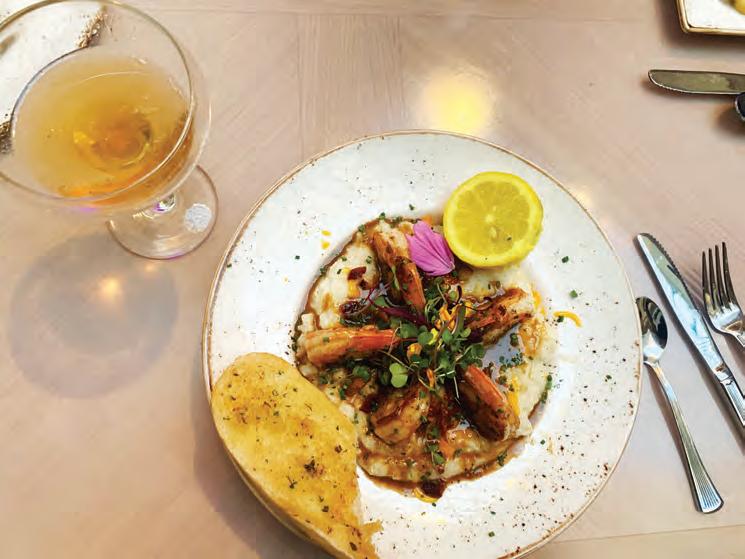
In Ocean Springs, that’s Buzzy’s—with all the things you love about a classic Southern diner, mix-matched chairs and vintage tablecloths shouting things like “farm fresh eggs” and “bless this home” all over them, or in my case, black and white decals of Elvis on the keys. Local seaside-inspired art lines the walls and every table has its own bottle of Crystal. For under $15 you can get a hot cup of joe and a classic, hearty breakfast plate of eggs, grits, and hashbrown casserole. I, for one, raised the bar a little higher: a good BLT tells you everything you need to know about a person, or a restaurant. And this one had lots to say about Buzzy’s. No frills, just the good stuff—quality bread just barely toasted, holding thick slabs of bacon and a tomato I’m certain was picked off a vine within a ten-mile radius.
If you’re looking for something sweeter, a short walk from Buzzy’s takes you to French Kiss Pastries, which has a full menu of craft coffees and a dazzling display of artisanal cakes, tarts, mousses, and cookies.


In Bay St. Louis, the go-to early bird hub is Mockingbird Café—housed in a charming cottage originally built in 1868, known by the locals as the “Living Room of the Bay”. The menu is expansive as it is creative: you can get everything here from the hangover-helper of “Brunch Fries” or pulled pork & grits to the lighter selections on the “Eat Like a Bird” section—quinoa bowls and yogurt parfaits with homemade jam and granola. After four days of stuffing myself with the riches of the Gulf, this side of things is where I landed at Mockingbird, opting for the chai oatmeal—which came beautifully plated with fresh bananas, a sprinkle of pepitas, and a healthy dollop of peanut butter. As for drinks, along with your espresso and coffee basics, there is a boisterous list of breakfast-friendly cocktails (including the beautifully-named “Tequila Mockingbird” with blood orange juice, rosemary honey simple syrup, and rosemary-infused tequila), alongside a “Healthy & Beauty” selection including golden turmeric, purple potato, and collagen lattes. Everything—from the flavored syrups to the whipped cream—is made from scratch, in-house.
Elizabethan Gallery
HOT SUMMER SHOW





//JUL 23 61
Right: The Shrimp and Grits from Salt & Ivy in the Beau Rivage.
• 225-924-6437 • Elizabethangallery.com
680 Jefferson Highway, BR, LA 70806
Than Just A Frame Shop
DAY FRAMING AVAILABLE
More
ONE
Dancing With the Waves, 11x14 oil by Mickey Asche
Sunset on the Dunes, 24x12 oil by Mickey Asche Nothing Like a Secondline, 24x30 mixed media by Keith Douglas Frame your vacation photos and child’s camp art.
Featuring new work by Mickey Asche & Keith Douglas Opening Reception
WEDNESDAY, JULY 19TH, 5 - 7 PM Free & Open to the Public (Show
hangs until Saturday, August 26th)
Something


Special Foodies looking for plated art have a happy home on the Gulf Coast, as well. The draw of the region’s lively, creatively-inclined communities is enhanced by the unsurpassed access to fresh local seafood: a combination that has inspired some of the South’s most intriguing chef-driven restaurant concepts. There’s James Beard nominee and 2021 “King of American Seafood” Austin Sumrall’s iconic Biloxi establishment White Pillars—whose emphasis on locally-sourced ingredients goes so far as to have Chef Sumrall purchasing half a hog from Como, Mississippi farm Home Place once a week, and processing the whole thing in-house (read more about Home Place on page 34).
In 2021, Bay St. Louis caught the eye of native son Chef Jeffrey Hansell, who cut his teeth in the kitchen of Commander’s Palace and went on to open the beloved Covington restaurant in the Southern Hotel, Oxlot 9—acquiring titles of “Best Chef in America” and “Best Chef in the American South” along the way. His newest venture is the Thorny Oyster, with perhaps Hansell’s most daring menu yet—a collection of dishes influenced by international cuisines (clams & chorizo, mussels & fries, bouillabaisse), all tied together by fresh, local seafood.



For foodies craving a more avant-garde experience, Ocean Springs native Alex Perry’s Vestige pushes the boundaries in a manner that has delighted diners since the nature-inspired Asian-infused Southern restaurant debuted on Washington Avenue in 2013. Since the pandemic, the 2019 James Beard Semi-finalist for Best Chef: South has shifted to a Multi-Course Chef’s Tasting Menu format, which is always changing but promises dishes you’ve probably never heard of and will certainly never forget, such as sashimi of hiramasa with foie gras emulsion, kumquat kosho, prickly ash, freshly-grated wasabi, and mustard flowers.
Perry was one of our 2020 Small Town Chefs, followed in 2022 by husband-wife duo Michael and Stephanie Paoletti, also from Ocean Springs. The Paolettis’ pop-up restaurant, The Lot, brings the inspiration of the Gulf into the streets—offering experimental, thoughtful, and fun takes on locally-sourced ingredients in a casual, outdoor setting. True to seasonally-focused form, the menu is almost never repeated, but includes bites to the tune of an aquaculture-raised oyster served with jezebel sauce and lettuce oil, marinated soft shell crab served half raw, and a Wagyu hanger steak with Romanesco purée.

Also in Ocean Springs, a community rich in taste of all sorts, is Luann Ellis’s Maison de Lu—where a woman I met at the Wilbur told me she would be returning to for a second time on her three-day trip because she so enjoyed her lunch. Enjoying the brisk May weather on the bistro’s front porch, I skimmed the menu out of curiosity but already knew what I’d be ordering, per overwhelming recommendations: the famed goat cheese torte, a crown of cheese sitting on pesto and topped with sun-dried tomatoes—served with triangles of fried pita bread; and the French panini, a pressed sandwich of ham, brie, and pepper jelly on ciabatta.
If I had to pick a favorite restaurant from my Gulf Coast adventure, though, it would be Radish— helmed by Chefs William Rester and Lauren Joffrion who—while working under Chef Hansell at the Thorny Oyster in 2021—won our Small Town Chefs Award that year, nominated by Alex Perry, no less. Her new “ingredient-driven” collaboration with restaurateur and chef Rester opened last August, and draws its inspiration from the humble root vegetable that was once Long Beach’s claim to fame as the “radish capital of the world”.
JUL 23 // COUNTRYROADSMAG.COM 62
www.lpb.org Tuesday, July 4 - 7PM Encore Presentation - 8:30PM Beginning Thursday, July 13 - 8PM Friday, July 28 - 8PM Season 8 Encore
The Wilbur Bar at the Roost Hotel in Ocean Springs is an experience all its own, rich in ambience and offering an intriguing menu of craft cocktails.
The space in the middle of downtown Long Beach is small and intimate, charming with its sweetly-tasteful plays on its name: artistic renderings of radishes everywhere, including on the wallpaper in the bathroom. When we featured Joffrion in 2021, it was with respect to her eclectic approach in the kitchen, embracing the bold. An engrossed scan of the menu reveals she’s brought that here, too, but now with an eye towards local agriculture: fried green tomatoes with shrimp and tasso cream, pork belly with fried grits and nuoc cham chimichurri, duck served with molé, dukkah, and fried collards; a pork chop with collard greens, “Grit Girl Grits,” and pickled mustard.
I started with the cocktail menu, as one does—going all in with the “24K Magic”: a Maker’s Mark concoction with honey, “pollen cordial,” and a garnish of gold leaf. Before I had selected my appetizer, a waitress came by with a complimentary plate of molasses cornbread soaked in all things good (honey butter). I told myself I was struggling to decide from the list of tantalizing appetizers (the crab beignets, with beurre blanc and pepper jelly, were tempting), but I knew from the beginning I would have to go with the radishes. And for anyone skeptical about the virtues of this vegetable, I say follow the name to Long Beach. Roasted and served with goat cheese and chimichurri, with big, beautiful flakes of salt—this is the dish that sticks in my mind most poignantly from this trip to the Gulf Coast. The radishes.
That is not to say the entrée was forgettable: upon the waitress’s recommendation, I ordered the gnocchi, which came elegantly simple—drenched in a spicy vodka sauce and piled high with lump crabmeat. A healthy sprinkle of Grana Padano and a green garnish finished the plate. This was comfort food at its finest, prepared
with just enough intention and finesse as to remind you of a home-cooked meal, then surpass those expectations. Radish wasn’t especially busy when I visited, due in no small part to the frenzy taking place next door, where Rester and Joffrion were overseeing the opening night of their new restaurant Kaiteki Noodle Bar, which had a line dangling out the front door until they ran out of food. (Between managing both kitchens that night, each chef graciously took some time to introduce themselves and share a little about the two restaurants.) The ramen bar couldn’t have had more organic origins: people loved Joffrion’s ramen special on the Radish menu so much that they decided to dedicate a whole new restaurant to it, bringing the Japanese comfort dish to the west side of the Coast for the first time.
See How the Sausage Gets Made
To round out a foodie’s journey to the coast, I highly recommend carving out some time to learn more about the food history of this region. The Maritime & Seafood Industry Museum in Biloxi provides extensive histories of, and artifacts from, the seafood industry’s impact and evolution—from its early beginnings in the 19th century to the present day.

Then, step into the world of coastal shrimpers for an afternoon with the Biloxi Shrimping Trip, which has been a pinnacle of local tourism since 1954. The guides are entertaining and incredibly knowledgeable about the history of the industry and its current state today—and provide an interactive, up-close look at how a shrimp finds its way from the sand at the bottom of the Gulf into the grits at Salt & Vine, onto the fried basket at Shaggy’s, or mixed with goat milk in the chawanmushi at Vestige.• gulfcoast.org
Disclaimer: The writer's research and travel for this editorial story were funded in part by Coastal Mississippi Tourism.



//JUL 23 63
The oyster combo—with char-baked, Rockefeller, and “jackpot” (spicy butter, cheddar, jalapeno, and bacon) varieties—at Bacchus on the Bayou.

JUL 23 // COUNTRYROADSMAG.COM 64 Directory
Merchants Baton Rouge, LA Allwood Furniture 18 Alzheimer’s Ser vice of the Capital Area 42 Baton Rouge Clinic 24 Becky Parrish Advance Skincare 63 Blue Cross Blue Shield 12 City Group Hospitality 55 East Baton Rouge Parish Librar y 68 Elizabethan Gallery 61 Louisiana Public Broadcasting 53, 62 LSU Museum of Art 45 Manship Theatre 13 Pennington Biomedical Research Center 7, 49 Pinetta’s European Restaurant 27 Wilson & Wilson, LLC 63 WRKF 89.3 FM 62 Brookhaven, MS Brookhaven Tourism Council 53 Covington, LA Covington Business Association (CBA) 35 Ferriday, LA Brakenridge Furniture 57 Grand Isle, LA Grand Isle Tourism Department 29 Grapevine, TX Grapevine Mills 9 Greenwood, MS Visit Greenwood 29 Hammond, LA Tangipahoa Parish CVB 67 Hattiesburg, MS Visit Hattiesburg 21 Houma, LA Explore Houma 43 Jackson, MS Mississippi Book Festival 31 Visit Mississippi 5 Lake Charles, LA Louisiana Food and Wine Festival 22 Lafayette, LA Allwood Furniture 18 J & J Exterminating 26 SouthStar Urgent Care 15 Livingston, LA Livingston Parish Library 61 Mandeville, LA Visit the Northshore 10 Mansura, LA Avoyelles Tourism Commission 41 Metairie, LA The J Collection 39 Morgan City, L A Cajun Coast CVB 28 Natchez, MS Crye-Leike Stedman Realtors 16 Katie’s Ladies Apparel 27 Monmouth Historic Inn 51 Natchez Chamber of Commerce 17 Natchez Pilgrimage Tours 19 Visit Natchez 57 New Iberia, LA Iberia Parish CVB 50 New Orleans, LA Historic New Orleans Collection 25 New Orleans Public Library 37 New Roads, LA City of New Roads 59 Morel’s Restaurant 27 Pointe Coupee Historical Society 61 Oak Ridge, LA Starr Homeplace 60 Opelousas, LA St. Landr y Parish Tourist Commission 60 Plaquemine, LA Iber ville Parish Tourism Department 14 Port Allen, LA West Baton Rouge Museum 30 West Baton Rouge CVB 23 Port Arthur, TX Visit Port Arthur 36 Scott, LA Bob’s Tree Preservation 59 St. Francisville, LA Bohemianville Antiques, LTD 33 The Saint / St. Francisville Inn 3 The Conundrum Books & Puzzles 33 The Corbel 2 The Cotton Exchange 33 The Magnolia Cafe 33 The Myrtles Plantation / Restaurant 1796 33 Town of St. Francisville 32 West Feliciana Parish Tourism Commission 32 Vicksburg, MS Visit Vicksburg 31 Woodville, MS Community Grocer y 6
of
Tickets on sale July 1st
November
Louisiana’s


Featured Events for 2023

Friday Night Winemaker Dinner featuring Miner Family Vineyards presented by Didier Consulting


St. Francisville Saturday Night at the Magnolia Cafe & 3V Tourist Court presented by Visit Mississippi

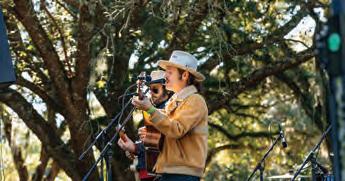
Sunday Grand Tastings at the Myrtles



Craft Beer and Brats Garden presented by Bank of St. Francisville Spirits at the Myrtles’ Courtyard presented by Paretti Jaguar Land Rover Country Roads People’s Choice Chef Experience presented by Williamson Eye Center City Group Hospitality Tasting Experience







Presented

// JUL 23 65
the Myrtles, St. Francisville, LA
at
10-12, 2023
Most Beautiful Food & Wine Event
with generous support from For Tickets Visit www.stfrancisvillefoodandwine.com
Sponsored by Tangipahoa Parish Tourism
PERSPECTIVES: IMAGES OF OUR STATE
YES WE CANNIBAL ENLISTS TUNDE WEY FOR A BOLD EXHIBITION OF MEAL AS MESSAGE
By Chris Turner-Neal
Inibal’s series of gestalt dinners, I effectively had no idea what they meant, or what I was signing up for.
Flash forward to me in an inflated hazmat suit, gloves, and veil-like mask, seated with thirteen strangers in a small gallery space. The walls were lined with balloons, and a video of a man and woman in African dress either speaking or preaching played on loop on the front wall. I tried to figure out how best to manage my glasses with the close-fitting veil—glasses on under? Glasses on over? Glasses off?—and ate my single roasted radish, scraping up the chimichurri-like sauce with the edge of my plastic fork. Even without expectations, this was not what I had expected.

We proceeded through the courses, which were announced by a voice over a loudspeaker: male, with a hard-to-place vaguely Northeastern accent. He also told anecdotes and gave instructions for the participatory aspects of the meal. At various points we danced, marched in a circle, and answered discussion prompts—though we were not to speak directly to each other, but instead had to call over an attendant to whom we would whisper our answer and who would repeat it aloud to the room. Intermittently, a child-sized figure in a hazmat suit matching ours would circuit the room and sometimes pop a balloon. To me, this was by far the most unnerving part of the evening, both because of how desperately I hate loud and sudden noises (“terrier nerves”) and because a civilization that needs to produce hazmat suits for children has gone terribly, desperately astray.
After the sixth course, we all sang, in unison, twice, Monty Python’s “Always Look on the Bright Side of Life,” then were told we could remove our masks, gloves, and suits. The last course, boba balls in spiced coconut milk, was distributed, and the chef finally revealed: chef and artist Tunde Wey. We had, in a sense, been played. Yes We Cannibal was not a restaurant or eatery or even a “purveyor,” but had worked with Wey to create and curate this event at the intersection of installation and performance art, of Dada and dinner.
ly-speaking, meals, to illustrate points about class, race, and inequality. He’s received the most press for projects like Saartj, a 2018 New Orleans pop-up that charged white people higher prices than people of color (a response in part to the St. Roch Food Market, an “urban renewal” plan that did not make good on its affordable food promises) and Hot Chicken Shit, a Nashville event that required white diners wanting a whole Nashville hot chicken to purchase it by signing over a deed to a property in gentrifying North Nashville.
An admiring 2019 GQ profile of Wey by Brett Martin includes the line, “There are times when it appears that food does not even particularly interest him,” which is fair: the food served at the performance dinner was by no means bad, but it was also very much beside the point. Wey’s art is often aggressive and makes arguments through food and about food, but not really through flavor. He wants to use food to create reflection, discomfort, effect: I liked the coconut cassava very much, but I would be amazed if he cared. Despite his (seemingly earned) reputation for confrontational work, the man himself is charming and an appealingly casual speaker—and also apparently a master of mimicry, as it was his voice over the speaker, the faintest West African accent concealed under a convincing “you-talkin’-tome” veneer.
I had mixed feelings about the work. At its best, it was thought-provoking and stimulating; other parts dragged and felt “weird for the sake of weird.” As Wey explained during a press conference/Q&A/hangout after the dinner, one of his major concerns in assembling the project was death: the seed of the project had been an idea for a dinner at the end of the world, which had evolved into the dinner I had experienced. It was his recently-departed mother in the film loop, joining his brother at a service of thanksgiving for the brother’s survival of a near-fatal accident. The meal had begun with, in lieu
of grace, a short, guided meditation on death in which we were invited to imagine and to accept our eventual death, decay, and ultimate return to the earth. Coming soon after we had all put on identity-negating costumes, this was especially effective. In general, the suits and veils were the aspect that struck me most. Enclosed, I felt I was experiencing the meal alone—every introvert knows the feeling of being “alone even in the crowd,” but to take part in this collection of strange rituals without eye contact, without a smile or a smirk across the table, made the weirdness of it all hit harder.
The absence of meat in a meal addressing death felt like a missed opportunity: the meal was nearly vegan (one dish had a little butter), but the provision of meat is how death most directly affects our tables. Also: it was too long. I left before the Q&A was over because I had to get back to New Orleans and sleep before my friends came to help me pack for a move in the morning: a glance at the car clock told me I’d been in there for four hours and forty minutes. I am a firm believer that you cannot effectively compete with the body for attention: if someone’s hip hurts or they have to pee, you’ll lose them, hence my enthusiasm for the eighty-seven-minute movie and the twenty-minute meeting. A broader point about the inversion of roles was lost on me—when the loudspeaker voice commanded us to dance, I did so because I like to think of myself as a good sport, and the idea that we were “dancing for our supper” in a reversal of the usual server-diner roles didn’t occur to me. (Also, as someone who is excellent dinner company, I am used to obtaining meals by providing light entertainment.)
If it didn’t all “work” for me, though, I can still praise Wey and the Yes We Cannibal curators, Mat Keel and Liz Lessner, for producing an event that was unlike anything I’ve encountered in my novelty-seeking, paying-the-bills-with-light-experiential-journalism life. The dinner challenged me (even if I did have to pee) and presented me with a truly new format for art: meal as message. Here’s hoping for seconds. •
Explore more of Yes We Cannibal’s upcoming programming at yeswecannibal.org.
JUL 23 // COUNTRYROADSMAG.COM 66
“Can-I-Ball?”
Image courtesy of Yes We Cannibal

// JUL 23 67
Point


your phone here for updates on the event schedule, special guests, cosplay contest, and more!






 by Mimi Greenwood Knight
by Mimi Greenwood Knight








































































































































































































 Story by Alexandra Kennon
Story by Alexandra Kennon






























 Story by Mimi Greenwood Knight • Photos by Kimberly Meadowlark
Story by Mimi Greenwood Knight • Photos by Kimberly Meadowlark













 —Kirstie Cornell
—Kirstie Cornell




 By Ed Cullen
By Ed Cullen



























 By Teddy McGehee
By Teddy McGehee











 Story and photos by Jordan LaHaye Fontenot
Story and photos by Jordan LaHaye Fontenot














































